Introduction to Economic Planning
VerifiedAdded on 2022/03/24
|75
|17571
|12
AI Summary
KENYATTA UNIVERSITY DIGITAL SCHOOL OF VIRTUAL AND OPEN LEARNING EAE 405: DEVELOPMENT PLANNING DEPARTMENT OF APPLIED ECONOMICS SCHOOL OF ECONOMICS Introduction II: Objective and Purpose of the Course TABLE OF CONTENTS LECTURE ONE: INTRODUCTION TO DEVELOPMENT PLANNING 5 i. 9 LECTURE TWO: RESOURCE REQUIREMENTS FOR PLANNING 11 a) Relevant policy and Institutions 11 b) Resource Requirements 12 i) Human Resource Requirements 13 ii) Non-Human Resource
Contribute Materials
Your contribution can guide someone’s learning journey. Share your
documents today.

KENYATTA UNIVERSITY
DIGITAL SCHOOL OF VIRTUAL AND OPEN LEARNING
EAE 405: DEVELOPMENT PLANNING
DEPARTMENT OF APPLIED ECONOMICS
SCHOOL OF ECONOMICS
Page 1 of 75
WRITTEN BY:
DR KENNEDY NYABUTO OCHARO
DIGITAL SCHOOL OF VIRTUAL AND OPEN LEARNING
EAE 405: DEVELOPMENT PLANNING
DEPARTMENT OF APPLIED ECONOMICS
SCHOOL OF ECONOMICS
Page 1 of 75
WRITTEN BY:
DR KENNEDY NYABUTO OCHARO
Secure Best Marks with AI Grader
Need help grading? Try our AI Grader for instant feedback on your assignments.
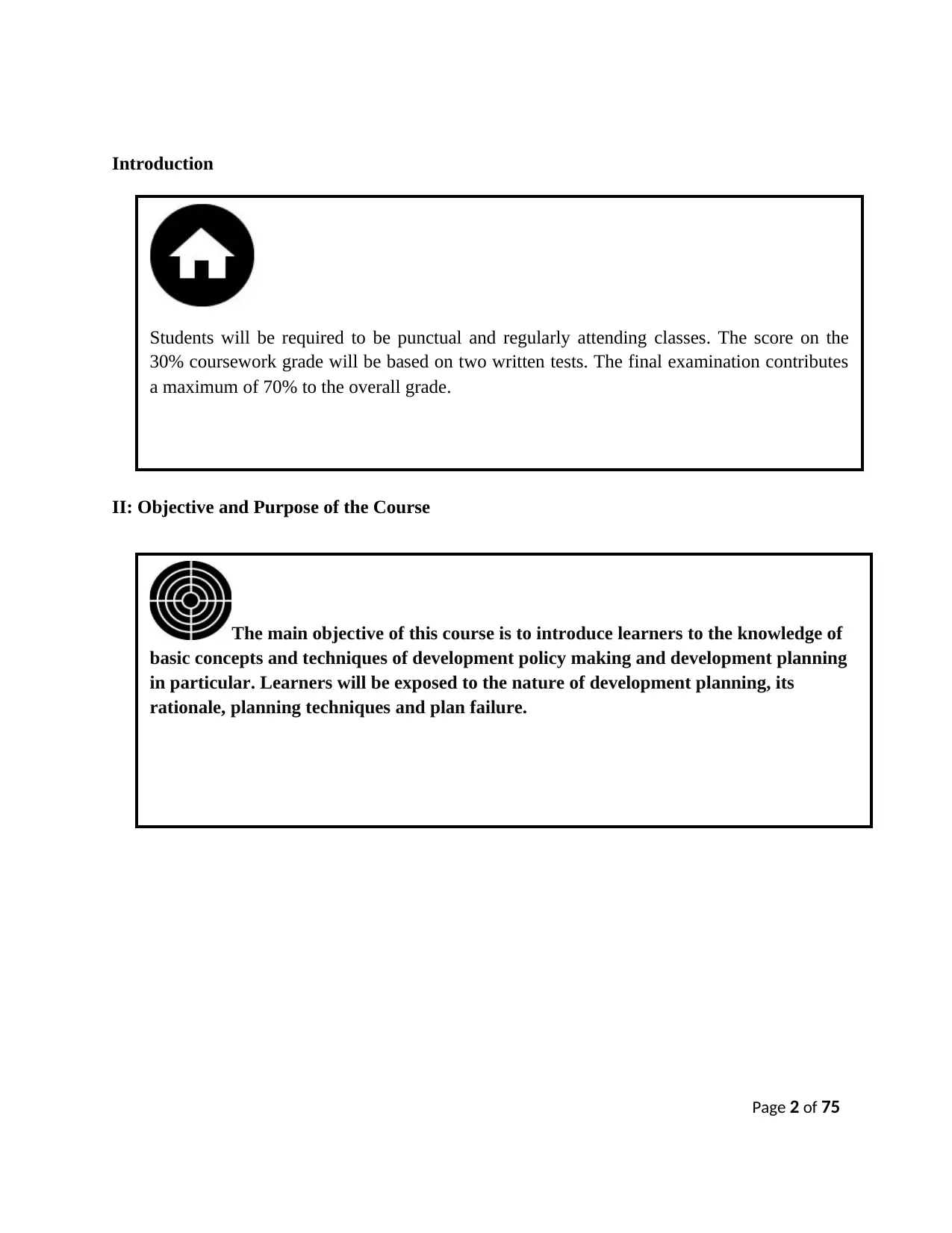
Introduction
II: Objective and Purpose of the Course
Page 2 of 75
Students will be required to be punctual and regularly attending classes. The score on the
30% coursework grade will be based on two written tests. The final examination contributes
a maximum of 70% to the overall grade.
The main objective of this course is to introduce learners to the knowledge of
basic concepts and techniques of development policy making and development planning
in particular. Learners will be exposed to the nature of development planning, its
rationale, planning techniques and plan failure.
II: Objective and Purpose of the Course
Page 2 of 75
Students will be required to be punctual and regularly attending classes. The score on the
30% coursework grade will be based on two written tests. The final examination contributes
a maximum of 70% to the overall grade.
The main objective of this course is to introduce learners to the knowledge of
basic concepts and techniques of development policy making and development planning
in particular. Learners will be exposed to the nature of development planning, its
rationale, planning techniques and plan failure.
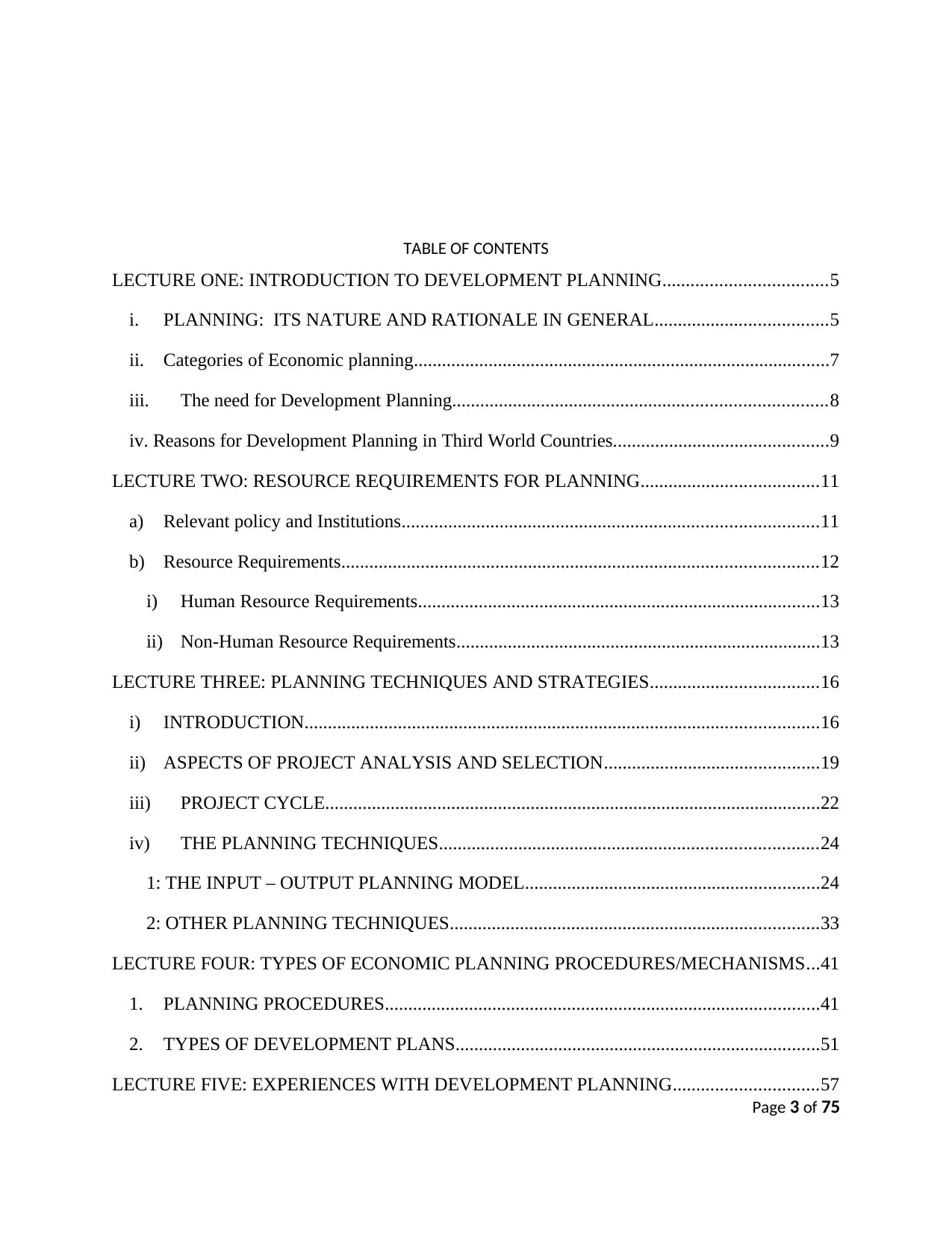
TABLE OF CONTENTS
LECTURE ONE: INTRODUCTION TO DEVELOPMENT PLANNING...................................5
i. PLANNING: ITS NATURE AND RATIONALE IN GENERAL.....................................5
ii. Categories of Economic planning.........................................................................................7
iii. The need for Development Planning................................................................................8
iv. Reasons for Development Planning in Third World Countries..............................................9
LECTURE TWO: RESOURCE REQUIREMENTS FOR PLANNING......................................11
a) Relevant policy and Institutions.........................................................................................11
b) Resource Requirements......................................................................................................12
i) Human Resource Requirements......................................................................................13
ii) Non-Human Resource Requirements..............................................................................13
LECTURE THREE: PLANNING TECHNIQUES AND STRATEGIES....................................16
i) INTRODUCTION..............................................................................................................16
ii) ASPECTS OF PROJECT ANALYSIS AND SELECTION..............................................19
iii) PROJECT CYCLE..........................................................................................................22
iv) THE PLANNING TECHNIQUES.................................................................................24
1: THE INPUT – OUTPUT PLANNING MODEL...............................................................24
2: OTHER PLANNING TECHNIQUES...............................................................................33
LECTURE FOUR: TYPES OF ECONOMIC PLANNING PROCEDURES/MECHANISMS...41
1. PLANNING PROCEDURES.............................................................................................41
2. TYPES OF DEVELOPMENT PLANS..............................................................................51
LECTURE FIVE: EXPERIENCES WITH DEVELOPMENT PLANNING...............................57
Page 3 of 75
LECTURE ONE: INTRODUCTION TO DEVELOPMENT PLANNING...................................5
i. PLANNING: ITS NATURE AND RATIONALE IN GENERAL.....................................5
ii. Categories of Economic planning.........................................................................................7
iii. The need for Development Planning................................................................................8
iv. Reasons for Development Planning in Third World Countries..............................................9
LECTURE TWO: RESOURCE REQUIREMENTS FOR PLANNING......................................11
a) Relevant policy and Institutions.........................................................................................11
b) Resource Requirements......................................................................................................12
i) Human Resource Requirements......................................................................................13
ii) Non-Human Resource Requirements..............................................................................13
LECTURE THREE: PLANNING TECHNIQUES AND STRATEGIES....................................16
i) INTRODUCTION..............................................................................................................16
ii) ASPECTS OF PROJECT ANALYSIS AND SELECTION..............................................19
iii) PROJECT CYCLE..........................................................................................................22
iv) THE PLANNING TECHNIQUES.................................................................................24
1: THE INPUT – OUTPUT PLANNING MODEL...............................................................24
2: OTHER PLANNING TECHNIQUES...............................................................................33
LECTURE FOUR: TYPES OF ECONOMIC PLANNING PROCEDURES/MECHANISMS...41
1. PLANNING PROCEDURES.............................................................................................41
2. TYPES OF DEVELOPMENT PLANS..............................................................................51
LECTURE FIVE: EXPERIENCES WITH DEVELOPMENT PLANNING...............................57
Page 3 of 75
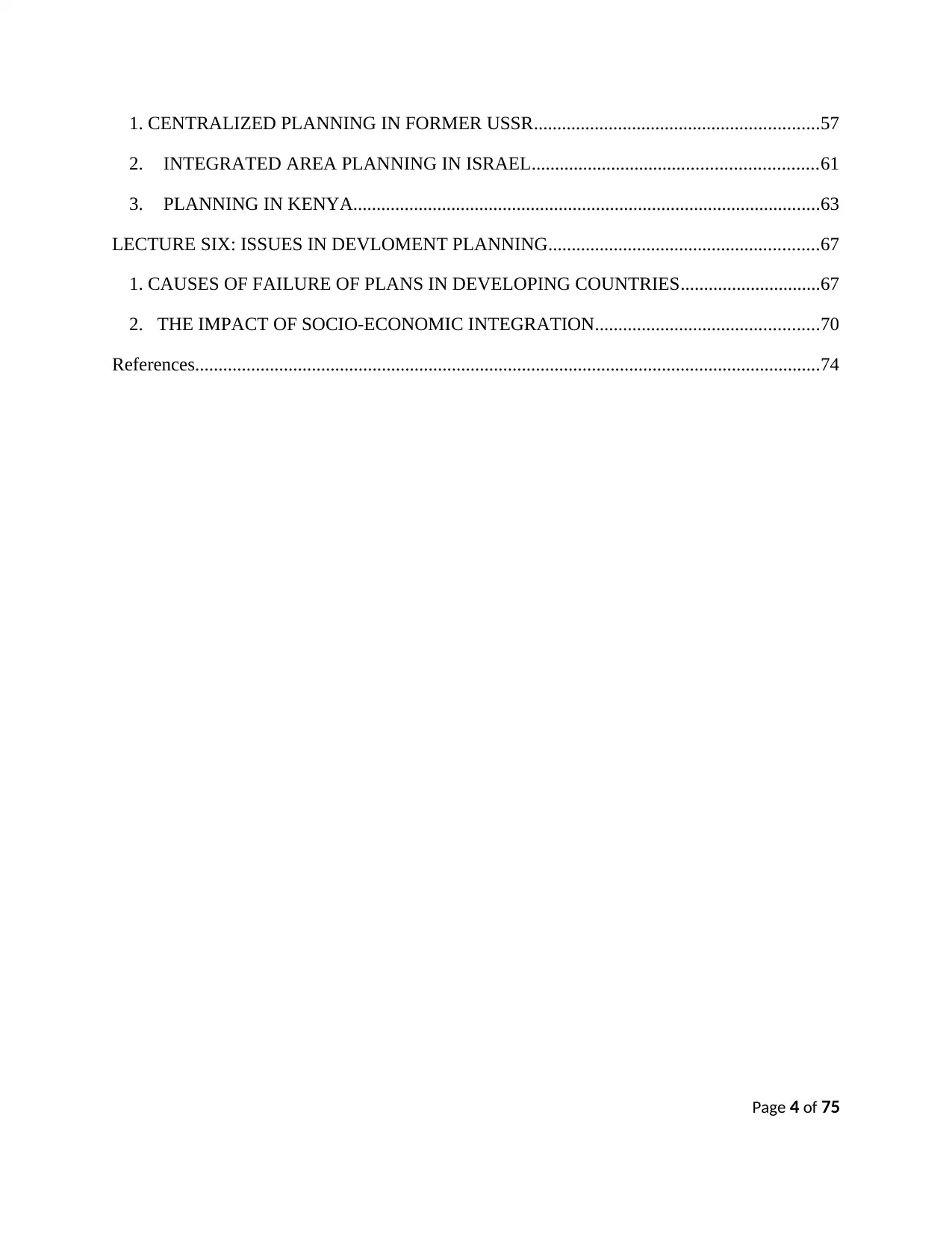
1. CENTRALIZED PLANNING IN FORMER USSR.............................................................57
2. INTEGRATED AREA PLANNING IN ISRAEL.............................................................61
3. PLANNING IN KENYA....................................................................................................63
LECTURE SIX: ISSUES IN DEVLOMENT PLANNING..........................................................67
1. CAUSES OF FAILURE OF PLANS IN DEVELOPING COUNTRIES..............................67
2. THE IMPACT OF SOCIO-ECONOMIC INTEGRATION................................................70
References......................................................................................................................................74
Page 4 of 75
2. INTEGRATED AREA PLANNING IN ISRAEL.............................................................61
3. PLANNING IN KENYA....................................................................................................63
LECTURE SIX: ISSUES IN DEVLOMENT PLANNING..........................................................67
1. CAUSES OF FAILURE OF PLANS IN DEVELOPING COUNTRIES..............................67
2. THE IMPACT OF SOCIO-ECONOMIC INTEGRATION................................................70
References......................................................................................................................................74
Page 4 of 75
Secure Best Marks with AI Grader
Need help grading? Try our AI Grader for instant feedback on your assignments.
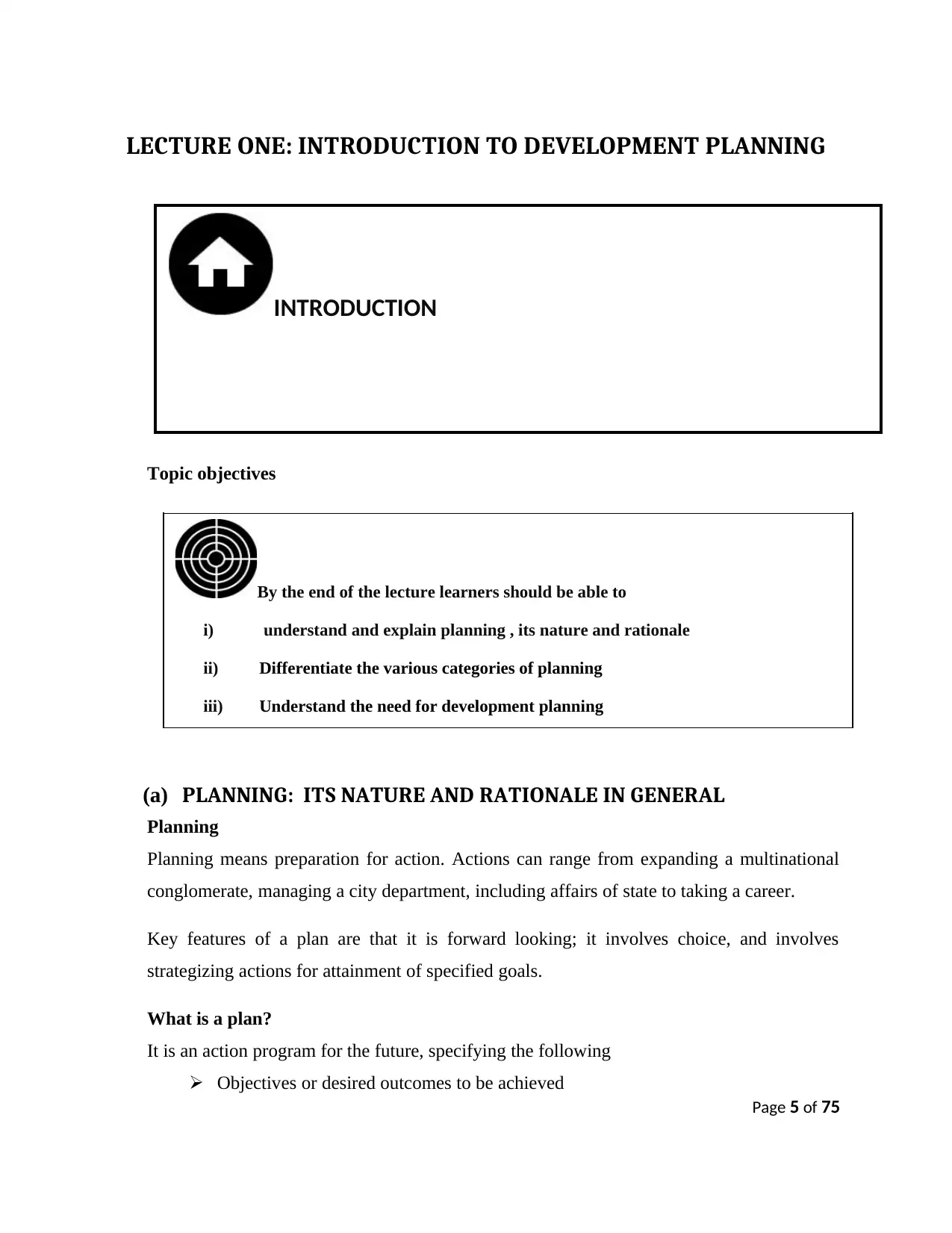
LECTURE ONE: INTRODUCTION TO DEVELOPMENT PLANNING
INTRODUCTION TO DEVELOPMENT PLANNING
Topic objectives
(a) PLANNING: ITS NATURE AND RATIONALE IN GENERAL
Planning
Planning means preparation for action. Actions can range from expanding a multinational
conglomerate, managing a city department, including affairs of state to taking a career.
Key features of a plan are that it is forward looking; it involves choice, and involves
strategizing actions for attainment of specified goals.
What is a plan?
It is an action program for the future, specifying the following
Objectives or desired outcomes to be achieved
Page 5 of 75
INTRODUCTION
By the end of the lecture learners should be able to
i) understand and explain planning , its nature and rationale
ii) Differentiate the various categories of planning
iii) Understand the need for development planning
INTRODUCTION TO DEVELOPMENT PLANNING
Topic objectives
(a) PLANNING: ITS NATURE AND RATIONALE IN GENERAL
Planning
Planning means preparation for action. Actions can range from expanding a multinational
conglomerate, managing a city department, including affairs of state to taking a career.
Key features of a plan are that it is forward looking; it involves choice, and involves
strategizing actions for attainment of specified goals.
What is a plan?
It is an action program for the future, specifying the following
Objectives or desired outcomes to be achieved
Page 5 of 75
INTRODUCTION
By the end of the lecture learners should be able to
i) understand and explain planning , its nature and rationale
ii) Differentiate the various categories of planning
iii) Understand the need for development planning
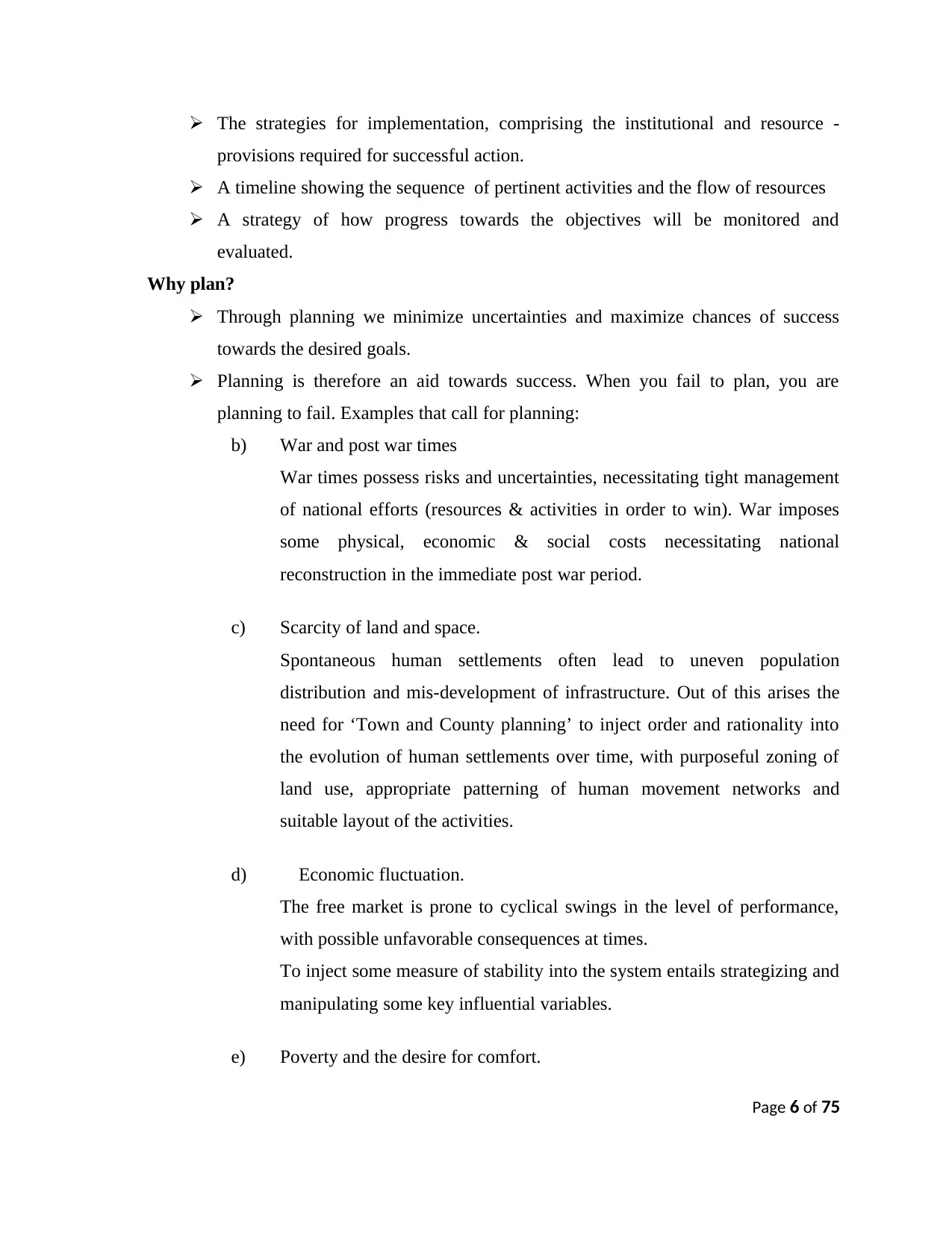
The strategies for implementation, comprising the institutional and resource -
provisions required for successful action.
A timeline showing the sequence of pertinent activities and the flow of resources
A strategy of how progress towards the objectives will be monitored and
evaluated.
Why plan?
Through planning we minimize uncertainties and maximize chances of success
towards the desired goals.
Planning is therefore an aid towards success. When you fail to plan, you are
planning to fail. Examples that call for planning:
b) War and post war times
War times possess risks and uncertainties, necessitating tight management
of national efforts (resources & activities in order to win). War imposes
some physical, economic & social costs necessitating national
reconstruction in the immediate post war period.
c) Scarcity of land and space.
Spontaneous human settlements often lead to uneven population
distribution and mis-development of infrastructure. Out of this arises the
need for ‘Town and County planning’ to inject order and rationality into
the evolution of human settlements over time, with purposeful zoning of
land use, appropriate patterning of human movement networks and
suitable layout of the activities.
d) Economic fluctuation.
The free market is prone to cyclical swings in the level of performance,
with possible unfavorable consequences at times.
To inject some measure of stability into the system entails strategizing and
manipulating some key influential variables.
e) Poverty and the desire for comfort.
Page 6 of 75
provisions required for successful action.
A timeline showing the sequence of pertinent activities and the flow of resources
A strategy of how progress towards the objectives will be monitored and
evaluated.
Why plan?
Through planning we minimize uncertainties and maximize chances of success
towards the desired goals.
Planning is therefore an aid towards success. When you fail to plan, you are
planning to fail. Examples that call for planning:
b) War and post war times
War times possess risks and uncertainties, necessitating tight management
of national efforts (resources & activities in order to win). War imposes
some physical, economic & social costs necessitating national
reconstruction in the immediate post war period.
c) Scarcity of land and space.
Spontaneous human settlements often lead to uneven population
distribution and mis-development of infrastructure. Out of this arises the
need for ‘Town and County planning’ to inject order and rationality into
the evolution of human settlements over time, with purposeful zoning of
land use, appropriate patterning of human movement networks and
suitable layout of the activities.
d) Economic fluctuation.
The free market is prone to cyclical swings in the level of performance,
with possible unfavorable consequences at times.
To inject some measure of stability into the system entails strategizing and
manipulating some key influential variables.
e) Poverty and the desire for comfort.
Page 6 of 75

Poverty is caused by a mix of many adverse factors. Since richness is
preferred to poverty, every poor community or nation wishes to find a way
of escaping from that condition – this needs to be strategized for and
pursued.
ii. Categories of Economic planning
Economic planning is the conscious effort by the government to influence, direct and
control the performance of the national economy. An economic plan therefore is an
action program setting out the nation’s economic goals and detailing the strategy for
pursuing them. It could be short-term (aimed at stabilizing performance) or long term
(charting out desired transformations).
a) Anti cyclical Planning
The market economy has a built in tendency for recurrent cycles, the ups and downs in its
performance. Anti cyclical planning aims at achieving and maintaining full use of
resources (Labour, capital, land and etc) & maintaining incomes above some set
minimum.
In modern day parlance, it is termed as ‘macroeconomic stabilization’ and it focuses on
the economy’s dynamics in the short run.
b) Development Planning
This is a category of economic planning that is concerned with the affairs of the economy
in the medium to long-term. It is divided into 4 levels:
National planning: This planning attempts to cover all sectors and aspects of the country’s
economy. It focuses on broad aggregates such as the level of national savings & investment,
GDP growth, per-capita income, national employment or unemployment, etc. It is supported by
sub-national, sect oral details & projects.
Sub-national/regional planning: This type of planning deals with a given geographical area
within the national economy. Preparations of such regional plans can cover the entire economy
Page 7 of 75
preferred to poverty, every poor community or nation wishes to find a way
of escaping from that condition – this needs to be strategized for and
pursued.
ii. Categories of Economic planning
Economic planning is the conscious effort by the government to influence, direct and
control the performance of the national economy. An economic plan therefore is an
action program setting out the nation’s economic goals and detailing the strategy for
pursuing them. It could be short-term (aimed at stabilizing performance) or long term
(charting out desired transformations).
a) Anti cyclical Planning
The market economy has a built in tendency for recurrent cycles, the ups and downs in its
performance. Anti cyclical planning aims at achieving and maintaining full use of
resources (Labour, capital, land and etc) & maintaining incomes above some set
minimum.
In modern day parlance, it is termed as ‘macroeconomic stabilization’ and it focuses on
the economy’s dynamics in the short run.
b) Development Planning
This is a category of economic planning that is concerned with the affairs of the economy
in the medium to long-term. It is divided into 4 levels:
National planning: This planning attempts to cover all sectors and aspects of the country’s
economy. It focuses on broad aggregates such as the level of national savings & investment,
GDP growth, per-capita income, national employment or unemployment, etc. It is supported by
sub-national, sect oral details & projects.
Sub-national/regional planning: This type of planning deals with a given geographical area
within the national economy. Preparations of such regional plans can cover the entire economy
Page 7 of 75
Paraphrase This Document
Need a fresh take? Get an instant paraphrase of this document with our AI Paraphraser
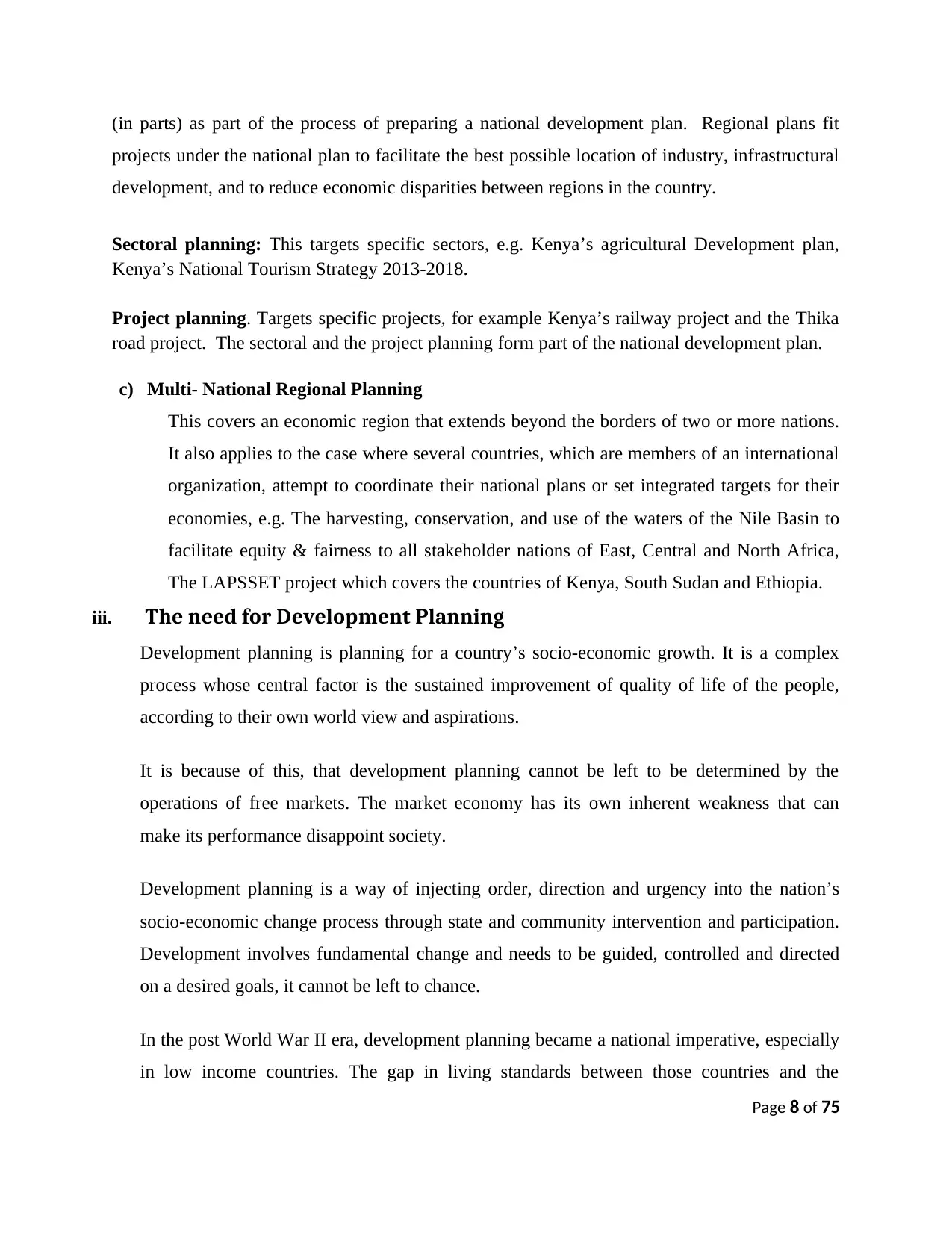
(in parts) as part of the process of preparing a national development plan. Regional plans fit
projects under the national plan to facilitate the best possible location of industry, infrastructural
development, and to reduce economic disparities between regions in the country.
Sectoral planning: This targets specific sectors, e.g. Kenya’s agricultural Development plan,
Kenya’s National Tourism Strategy 2013-2018.
Project planning. Targets specific projects, for example Kenya’s railway project and the Thika
road project. The sectoral and the project planning form part of the national development plan.
c) Multi- National Regional Planning
This covers an economic region that extends beyond the borders of two or more nations.
It also applies to the case where several countries, which are members of an international
organization, attempt to coordinate their national plans or set integrated targets for their
economies, e.g. The harvesting, conservation, and use of the waters of the Nile Basin to
facilitate equity & fairness to all stakeholder nations of East, Central and North Africa,
The LAPSSET project which covers the countries of Kenya, South Sudan and Ethiopia.
iii. The need for Development Planning
Development planning is planning for a country’s socio-economic growth. It is a complex
process whose central factor is the sustained improvement of quality of life of the people,
according to their own world view and aspirations.
It is because of this, that development planning cannot be left to be determined by the
operations of free markets. The market economy has its own inherent weakness that can
make its performance disappoint society.
Development planning is a way of injecting order, direction and urgency into the nation’s
socio-economic change process through state and community intervention and participation.
Development involves fundamental change and needs to be guided, controlled and directed
on a desired goals, it cannot be left to chance.
In the post World War II era, development planning became a national imperative, especially
in low income countries. The gap in living standards between those countries and the
Page 8 of 75
projects under the national plan to facilitate the best possible location of industry, infrastructural
development, and to reduce economic disparities between regions in the country.
Sectoral planning: This targets specific sectors, e.g. Kenya’s agricultural Development plan,
Kenya’s National Tourism Strategy 2013-2018.
Project planning. Targets specific projects, for example Kenya’s railway project and the Thika
road project. The sectoral and the project planning form part of the national development plan.
c) Multi- National Regional Planning
This covers an economic region that extends beyond the borders of two or more nations.
It also applies to the case where several countries, which are members of an international
organization, attempt to coordinate their national plans or set integrated targets for their
economies, e.g. The harvesting, conservation, and use of the waters of the Nile Basin to
facilitate equity & fairness to all stakeholder nations of East, Central and North Africa,
The LAPSSET project which covers the countries of Kenya, South Sudan and Ethiopia.
iii. The need for Development Planning
Development planning is planning for a country’s socio-economic growth. It is a complex
process whose central factor is the sustained improvement of quality of life of the people,
according to their own world view and aspirations.
It is because of this, that development planning cannot be left to be determined by the
operations of free markets. The market economy has its own inherent weakness that can
make its performance disappoint society.
Development planning is a way of injecting order, direction and urgency into the nation’s
socio-economic change process through state and community intervention and participation.
Development involves fundamental change and needs to be guided, controlled and directed
on a desired goals, it cannot be left to chance.
In the post World War II era, development planning became a national imperative, especially
in low income countries. The gap in living standards between those countries and the
Page 8 of 75
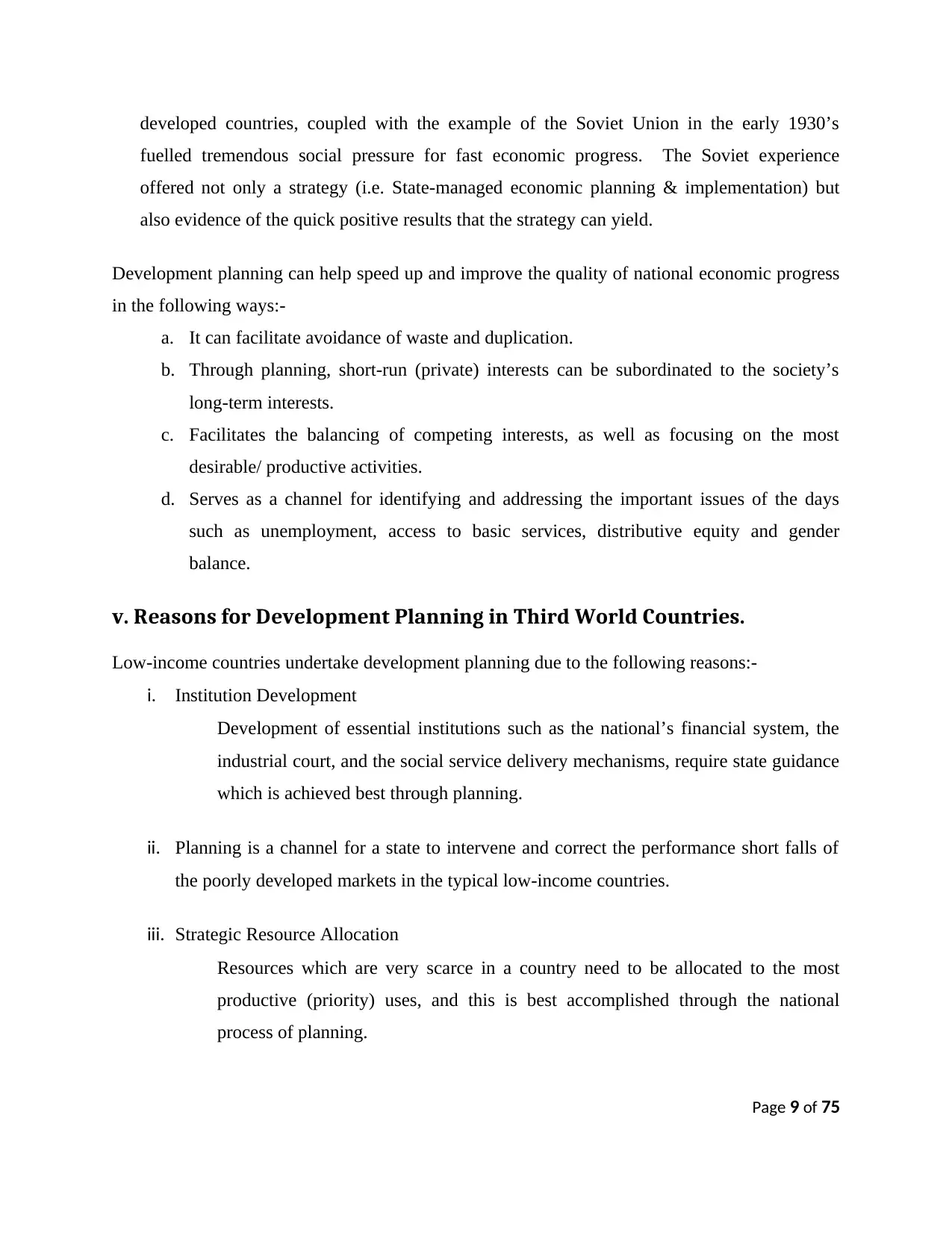
developed countries, coupled with the example of the Soviet Union in the early 1930’s
fuelled tremendous social pressure for fast economic progress. The Soviet experience
offered not only a strategy (i.e. State-managed economic planning & implementation) but
also evidence of the quick positive results that the strategy can yield.
Development planning can help speed up and improve the quality of national economic progress
in the following ways:-
a. It can facilitate avoidance of waste and duplication.
b. Through planning, short-run (private) interests can be subordinated to the society’s
long-term interests.
c. Facilitates the balancing of competing interests, as well as focusing on the most
desirable/ productive activities.
d. Serves as a channel for identifying and addressing the important issues of the days
such as unemployment, access to basic services, distributive equity and gender
balance.
v. Reasons for Development Planning in Third World Countries.
Low-income countries undertake development planning due to the following reasons:-
i. Institution Development
Development of essential institutions such as the national’s financial system, the
industrial court, and the social service delivery mechanisms, require state guidance
which is achieved best through planning.
ii. Planning is a channel for a state to intervene and correct the performance short falls of
the poorly developed markets in the typical low-income countries.
iii. Strategic Resource Allocation
Resources which are very scarce in a country need to be allocated to the most
productive (priority) uses, and this is best accomplished through the national
process of planning.
Page 9 of 75
fuelled tremendous social pressure for fast economic progress. The Soviet experience
offered not only a strategy (i.e. State-managed economic planning & implementation) but
also evidence of the quick positive results that the strategy can yield.
Development planning can help speed up and improve the quality of national economic progress
in the following ways:-
a. It can facilitate avoidance of waste and duplication.
b. Through planning, short-run (private) interests can be subordinated to the society’s
long-term interests.
c. Facilitates the balancing of competing interests, as well as focusing on the most
desirable/ productive activities.
d. Serves as a channel for identifying and addressing the important issues of the days
such as unemployment, access to basic services, distributive equity and gender
balance.
v. Reasons for Development Planning in Third World Countries.
Low-income countries undertake development planning due to the following reasons:-
i. Institution Development
Development of essential institutions such as the national’s financial system, the
industrial court, and the social service delivery mechanisms, require state guidance
which is achieved best through planning.
ii. Planning is a channel for a state to intervene and correct the performance short falls of
the poorly developed markets in the typical low-income countries.
iii. Strategic Resource Allocation
Resources which are very scarce in a country need to be allocated to the most
productive (priority) uses, and this is best accomplished through the national
process of planning.
Page 9 of 75

iv. Mobilizing the people
Often, a national development plan is used as a rallying tool to mobilize citizens,
for a united effort. The plan raises hopes, and provides a framework for citizen
participation in development activities.
v. Attracting Foreign Aid
Some donors insist on a country having a national plan before it can be considered
for assistance. Consequently, some low-income states draw up elaborate plans as
tools for soliciting external aid. The chances that such plans would be implemented
are minimal, even if the external aid is actually gotten.
Lecture summary
In this lecture we have learnt what a plan is, why plan, categories of
economic planning, the need for planning and why countries should plan
Work to do
The county government is recruiting a county executive in charge of
planning. Assume you are interested in the position and have been shortlisted for the
job. You have been asked to argue for the need for planning at the county level. What
arguments will you put forward for planning at the county level?
Page 10 of 75
Often, a national development plan is used as a rallying tool to mobilize citizens,
for a united effort. The plan raises hopes, and provides a framework for citizen
participation in development activities.
v. Attracting Foreign Aid
Some donors insist on a country having a national plan before it can be considered
for assistance. Consequently, some low-income states draw up elaborate plans as
tools for soliciting external aid. The chances that such plans would be implemented
are minimal, even if the external aid is actually gotten.
Lecture summary
In this lecture we have learnt what a plan is, why plan, categories of
economic planning, the need for planning and why countries should plan
Work to do
The county government is recruiting a county executive in charge of
planning. Assume you are interested in the position and have been shortlisted for the
job. You have been asked to argue for the need for planning at the county level. What
arguments will you put forward for planning at the county level?
Page 10 of 75
Secure Best Marks with AI Grader
Need help grading? Try our AI Grader for instant feedback on your assignments.
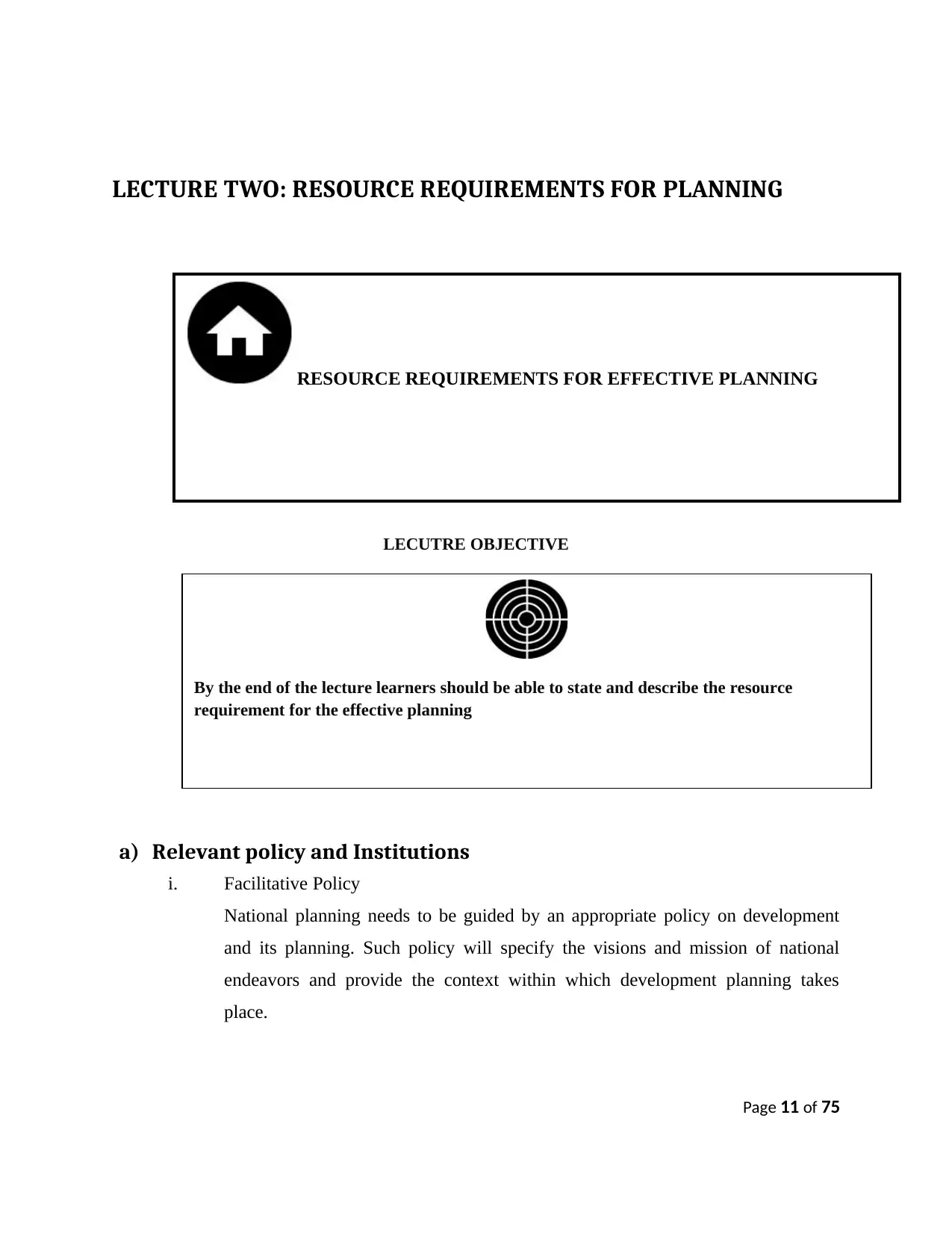
LECTURE TWO: RESOURCE REQUIREMENTS FOR PLANNING
LECUTRE OBJECTIVE
a) Relevant policy and Institutions
i. Facilitative Policy
National planning needs to be guided by an appropriate policy on development
and its planning. Such policy will specify the visions and mission of national
endeavors and provide the context within which development planning takes
place.
Page 11 of 75
RESOURCE REQUIREMENTS FOR EFFECTIVE PLANNING
By the end of the lecture learners should be able to state and describe the resource
requirement for the effective planning
LECUTRE OBJECTIVE
a) Relevant policy and Institutions
i. Facilitative Policy
National planning needs to be guided by an appropriate policy on development
and its planning. Such policy will specify the visions and mission of national
endeavors and provide the context within which development planning takes
place.
Page 11 of 75
RESOURCE REQUIREMENTS FOR EFFECTIVE PLANNING
By the end of the lecture learners should be able to state and describe the resource
requirement for the effective planning
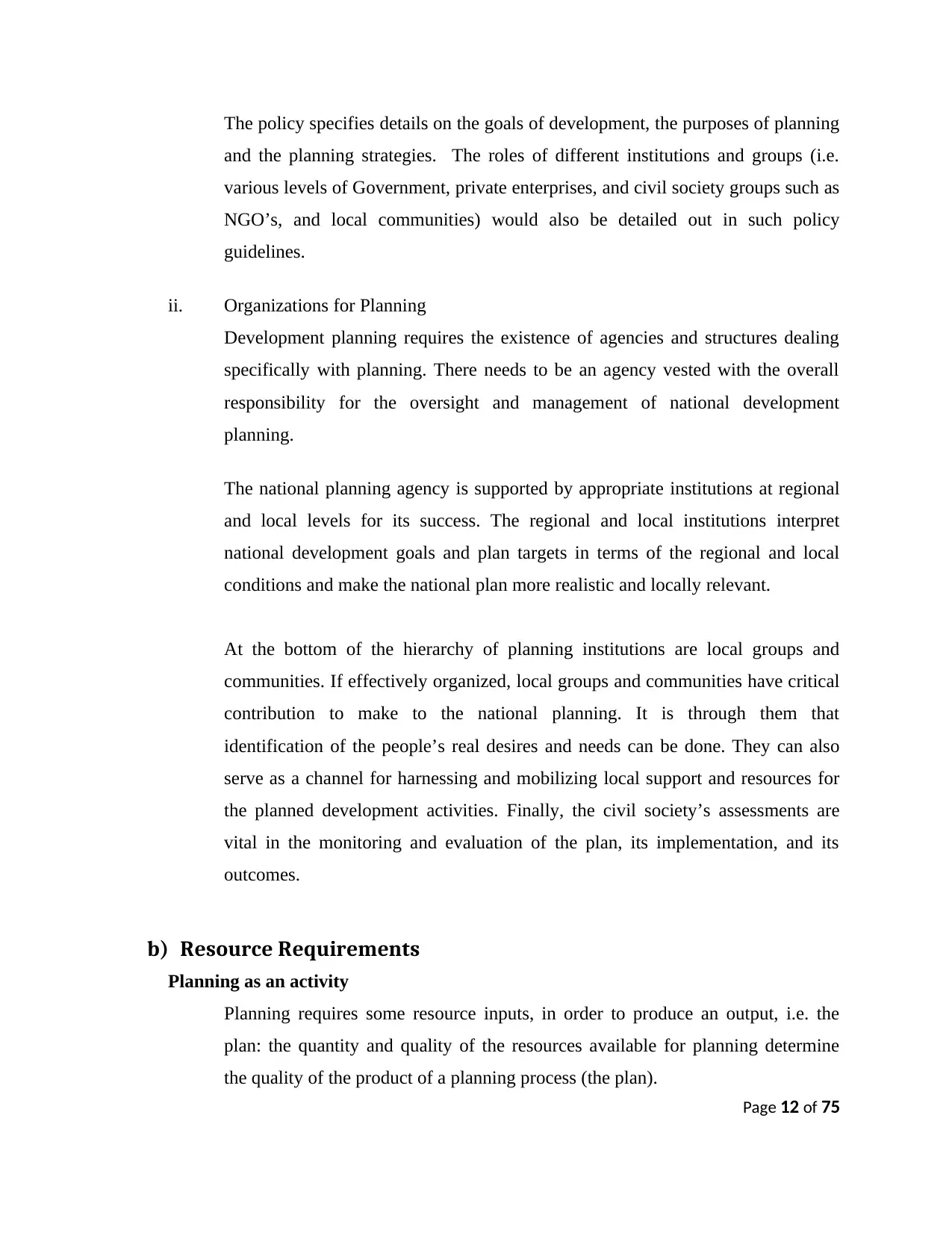
The policy specifies details on the goals of development, the purposes of planning
and the planning strategies. The roles of different institutions and groups (i.e.
various levels of Government, private enterprises, and civil society groups such as
NGO’s, and local communities) would also be detailed out in such policy
guidelines.
ii. Organizations for Planning
Development planning requires the existence of agencies and structures dealing
specifically with planning. There needs to be an agency vested with the overall
responsibility for the oversight and management of national development
planning.
The national planning agency is supported by appropriate institutions at regional
and local levels for its success. The regional and local institutions interpret
national development goals and plan targets in terms of the regional and local
conditions and make the national plan more realistic and locally relevant.
At the bottom of the hierarchy of planning institutions are local groups and
communities. If effectively organized, local groups and communities have critical
contribution to make to the national planning. It is through them that
identification of the people’s real desires and needs can be done. They can also
serve as a channel for harnessing and mobilizing local support and resources for
the planned development activities. Finally, the civil society’s assessments are
vital in the monitoring and evaluation of the plan, its implementation, and its
outcomes.
b) Resource Requirements
Planning as an activity
Planning requires some resource inputs, in order to produce an output, i.e. the
plan: the quantity and quality of the resources available for planning determine
the quality of the product of a planning process (the plan).
Page 12 of 75
and the planning strategies. The roles of different institutions and groups (i.e.
various levels of Government, private enterprises, and civil society groups such as
NGO’s, and local communities) would also be detailed out in such policy
guidelines.
ii. Organizations for Planning
Development planning requires the existence of agencies and structures dealing
specifically with planning. There needs to be an agency vested with the overall
responsibility for the oversight and management of national development
planning.
The national planning agency is supported by appropriate institutions at regional
and local levels for its success. The regional and local institutions interpret
national development goals and plan targets in terms of the regional and local
conditions and make the national plan more realistic and locally relevant.
At the bottom of the hierarchy of planning institutions are local groups and
communities. If effectively organized, local groups and communities have critical
contribution to make to the national planning. It is through them that
identification of the people’s real desires and needs can be done. They can also
serve as a channel for harnessing and mobilizing local support and resources for
the planned development activities. Finally, the civil society’s assessments are
vital in the monitoring and evaluation of the plan, its implementation, and its
outcomes.
b) Resource Requirements
Planning as an activity
Planning requires some resource inputs, in order to produce an output, i.e. the
plan: the quantity and quality of the resources available for planning determine
the quality of the product of a planning process (the plan).
Page 12 of 75
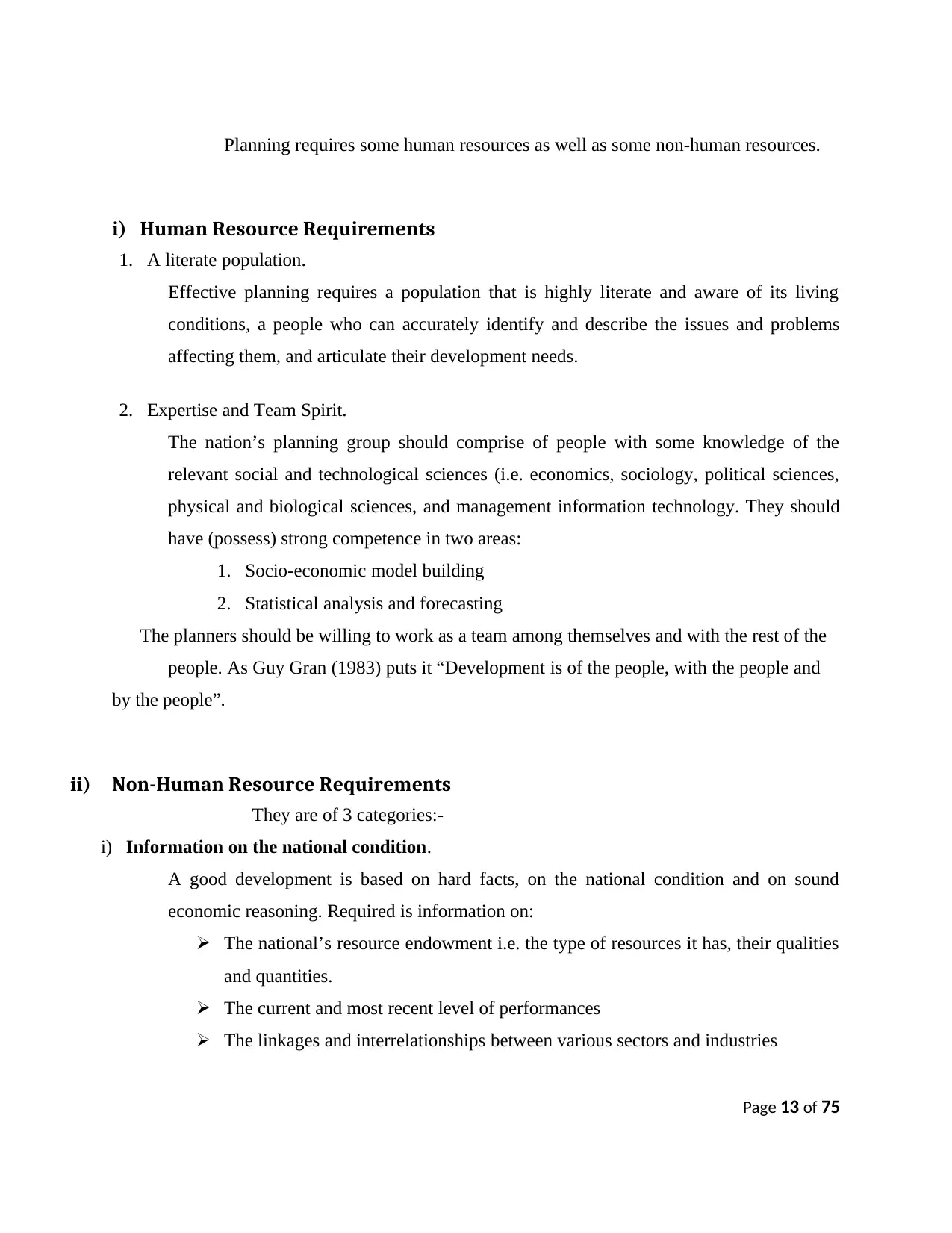
Planning requires some human resources as well as some non-human resources.
i) Human Resource Requirements
1. A literate population.
Effective planning requires a population that is highly literate and aware of its living
conditions, a people who can accurately identify and describe the issues and problems
affecting them, and articulate their development needs.
2. Expertise and Team Spirit.
The nation’s planning group should comprise of people with some knowledge of the
relevant social and technological sciences (i.e. economics, sociology, political sciences,
physical and biological sciences, and management information technology. They should
have (possess) strong competence in two areas:
1. Socio-economic model building
2. Statistical analysis and forecasting
The planners should be willing to work as a team among themselves and with the rest of the
people. As Guy Gran (1983) puts it “Development is of the people, with the people and
by the people”.
ii) Non-Human Resource Requirements
They are of 3 categories:-
i) Information on the national condition.
A good development is based on hard facts, on the national condition and on sound
economic reasoning. Required is information on:
The national’s resource endowment i.e. the type of resources it has, their qualities
and quantities.
The current and most recent level of performances
The linkages and interrelationships between various sectors and industries
Page 13 of 75
i) Human Resource Requirements
1. A literate population.
Effective planning requires a population that is highly literate and aware of its living
conditions, a people who can accurately identify and describe the issues and problems
affecting them, and articulate their development needs.
2. Expertise and Team Spirit.
The nation’s planning group should comprise of people with some knowledge of the
relevant social and technological sciences (i.e. economics, sociology, political sciences,
physical and biological sciences, and management information technology. They should
have (possess) strong competence in two areas:
1. Socio-economic model building
2. Statistical analysis and forecasting
The planners should be willing to work as a team among themselves and with the rest of the
people. As Guy Gran (1983) puts it “Development is of the people, with the people and
by the people”.
ii) Non-Human Resource Requirements
They are of 3 categories:-
i) Information on the national condition.
A good development is based on hard facts, on the national condition and on sound
economic reasoning. Required is information on:
The national’s resource endowment i.e. the type of resources it has, their qualities
and quantities.
The current and most recent level of performances
The linkages and interrelationships between various sectors and industries
Page 13 of 75
Paraphrase This Document
Need a fresh take? Get an instant paraphrase of this document with our AI Paraphraser

Problems and issues that need attention, i.e. what they are and how pressing they
are
Existing institutions relevant to the nation’s development efforts, i.e. those that
can help or hinder progress, such as the national ministry for economic planning
Current links to the international economy, i.e. the type and strength of the links
with the rest of the world
How committed to the development effort the Government is. This can be judged
from its history of allocating resources to development activities and its reactions
to any unforeseen threats to development plans
Economic planning requires a large volume of data and information on the national
system. The problem is how such a large quantity of information can be made readily
available, and received in relevant and usable form. Talk of KNBS (Kenya National
Bureau of Statistics).
The best arrangement could be a generation of such information through the presence and
utilization of an integrated National Social Accounting system, together with the use of
planning workshops and seminars that bring together experts from different fields and
backgrounds to generate and share information targeted on different sections and issues
in the national system.
2. Physical facilities and Materials
The planning exercise needs to be located in suitable premises like offices, meeting
facilities and other items of convenience. Needed also are materials and equipments to
facilitate documentation, computations, communication and publication.
3. Funds
Planning personnel have to be paid. Correspondence has to be undertaken; information
has to be published in written form. All these require funds. Availability of funds
facilitates timely accession of the real resources needed in the planning process.
Page 14 of 75
are
Existing institutions relevant to the nation’s development efforts, i.e. those that
can help or hinder progress, such as the national ministry for economic planning
Current links to the international economy, i.e. the type and strength of the links
with the rest of the world
How committed to the development effort the Government is. This can be judged
from its history of allocating resources to development activities and its reactions
to any unforeseen threats to development plans
Economic planning requires a large volume of data and information on the national
system. The problem is how such a large quantity of information can be made readily
available, and received in relevant and usable form. Talk of KNBS (Kenya National
Bureau of Statistics).
The best arrangement could be a generation of such information through the presence and
utilization of an integrated National Social Accounting system, together with the use of
planning workshops and seminars that bring together experts from different fields and
backgrounds to generate and share information targeted on different sections and issues
in the national system.
2. Physical facilities and Materials
The planning exercise needs to be located in suitable premises like offices, meeting
facilities and other items of convenience. Needed also are materials and equipments to
facilitate documentation, computations, communication and publication.
3. Funds
Planning personnel have to be paid. Correspondence has to be undertaken; information
has to be published in written form. All these require funds. Availability of funds
facilitates timely accession of the real resources needed in the planning process.
Page 14 of 75

Lecture summary
In this we lecture we have looked at the resource requirements for planning. These include
relevant policy and institutions and resources such human and non human.
-
1.6 Work to do
Think of a project and discuss the resources that you will require for the said project.
Page 15 of 75
In this we lecture we have looked at the resource requirements for planning. These include
relevant policy and institutions and resources such human and non human.
-
1.6 Work to do
Think of a project and discuss the resources that you will require for the said project.
Page 15 of 75
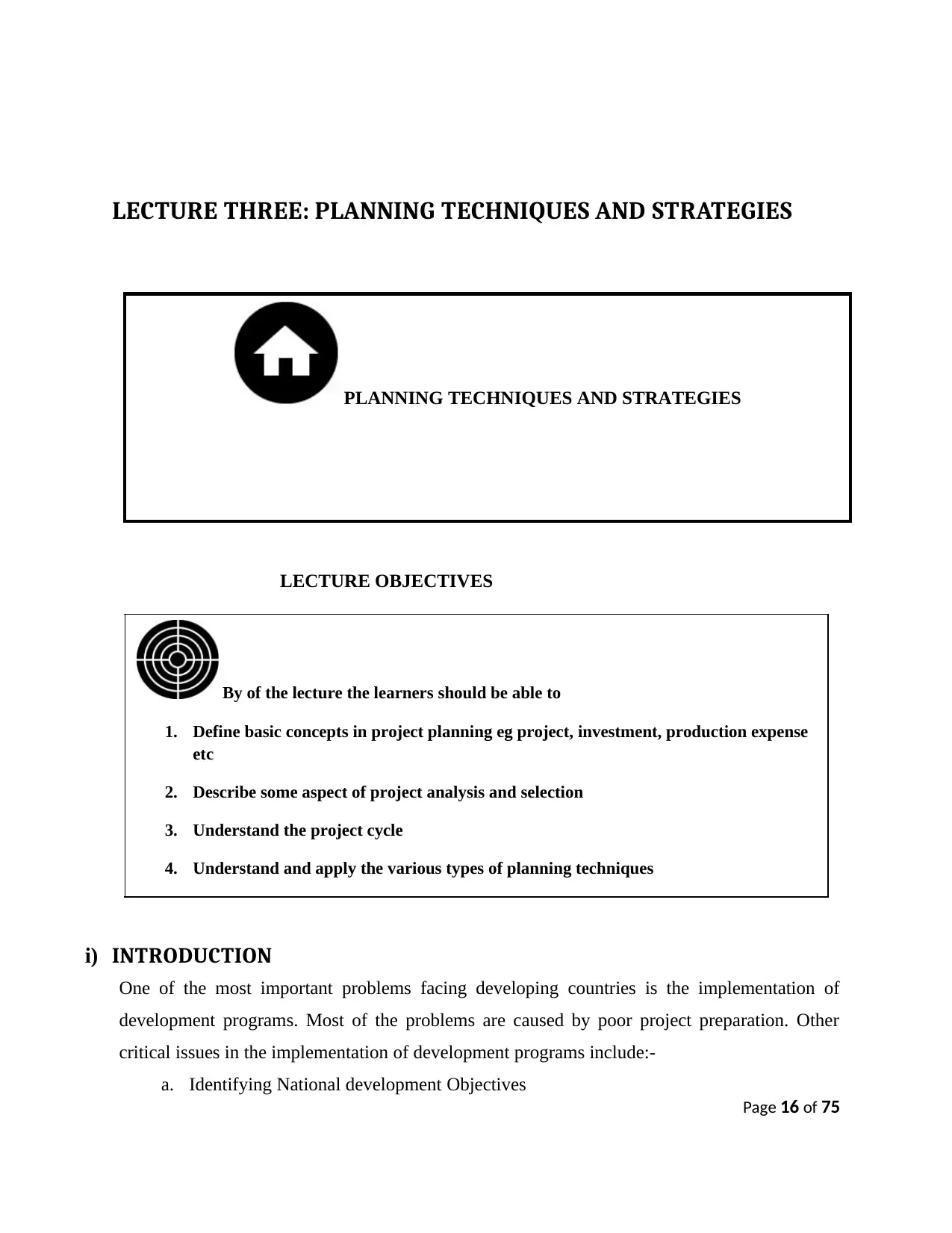
LECTURE THREE: PLANNING TECHNIQUES AND STRATEGIES
LECTURE OBJECTIVES
i) INTRODUCTION
One of the most important problems facing developing countries is the implementation of
development programs. Most of the problems are caused by poor project preparation. Other
critical issues in the implementation of development programs include:-
a. Identifying National development Objectives
Page 16 of 75
By of the lecture the learners should be able to
1. Define basic concepts in project planning eg project, investment, production expense
etc
2. Describe some aspect of project analysis and selection
3. Understand the project cycle
4. Understand and apply the various types of planning techniques
PLANNING TECHNIQUES AND STRATEGIES
LECTURE OBJECTIVES
i) INTRODUCTION
One of the most important problems facing developing countries is the implementation of
development programs. Most of the problems are caused by poor project preparation. Other
critical issues in the implementation of development programs include:-
a. Identifying National development Objectives
Page 16 of 75
By of the lecture the learners should be able to
1. Define basic concepts in project planning eg project, investment, production expense
etc
2. Describe some aspect of project analysis and selection
3. Understand the project cycle
4. Understand and apply the various types of planning techniques
PLANNING TECHNIQUES AND STRATEGIES
Secure Best Marks with AI Grader
Need help grading? Try our AI Grader for instant feedback on your assignments.

b. Selecting priority areas for investment
c. Assigning effective price policies
d. Mobilizing the resources that are needed
In any development activities, one should bear in mind careful project preparation in advance of
expenditure. There are two reasons for doing this:
i. For efficient and economic use of capital funds
ii. For the increased chance of a project being implemented on schedule or in time
When a project has not been carefully prepared, then inefficient or even wasteful expenditure
will occur. In this case, the main issue is the comparison of the stream of investment and
production costs. For example, in an agricultural project, one will do the comparison of costs
with the flow of benefits that the project will produce.
The complex range of activities in the undertaking that uses resources in order to gain benefit
constitutes the project. In general a project is considered as an investment activity in which
financial resources are used up to create capital assets which produce benefits over an extended
period of time.
In some projects however, costs may be incurred for production expenses or maintenance from
which benefits can be expected quite fast.
For example, in an Agricultural project the dividing line between an “investment”
and“production” expenditure is not at all that clear-for instance,
i. Fertilizers, pesticides and so on are generally considered to be production expenses
which are used within one crop season
ii. A dam, a building or tractor will generally be thought of as investment from which a
return will be realized over several years.
The same kind of activity may be considered a production expense in one project and investment
expenditure in another. E.g.
a. Transplanting rice is a production expense
b. Planting rubber trees is an investment expense
Page 17 of 75
c. Assigning effective price policies
d. Mobilizing the resources that are needed
In any development activities, one should bear in mind careful project preparation in advance of
expenditure. There are two reasons for doing this:
i. For efficient and economic use of capital funds
ii. For the increased chance of a project being implemented on schedule or in time
When a project has not been carefully prepared, then inefficient or even wasteful expenditure
will occur. In this case, the main issue is the comparison of the stream of investment and
production costs. For example, in an agricultural project, one will do the comparison of costs
with the flow of benefits that the project will produce.
The complex range of activities in the undertaking that uses resources in order to gain benefit
constitutes the project. In general a project is considered as an investment activity in which
financial resources are used up to create capital assets which produce benefits over an extended
period of time.
In some projects however, costs may be incurred for production expenses or maintenance from
which benefits can be expected quite fast.
For example, in an Agricultural project the dividing line between an “investment”
and“production” expenditure is not at all that clear-for instance,
i. Fertilizers, pesticides and so on are generally considered to be production expenses
which are used within one crop season
ii. A dam, a building or tractor will generally be thought of as investment from which a
return will be realized over several years.
The same kind of activity may be considered a production expense in one project and investment
expenditure in another. E.g.
a. Transplanting rice is a production expense
b. Planting rubber trees is an investment expense
Page 17 of 75
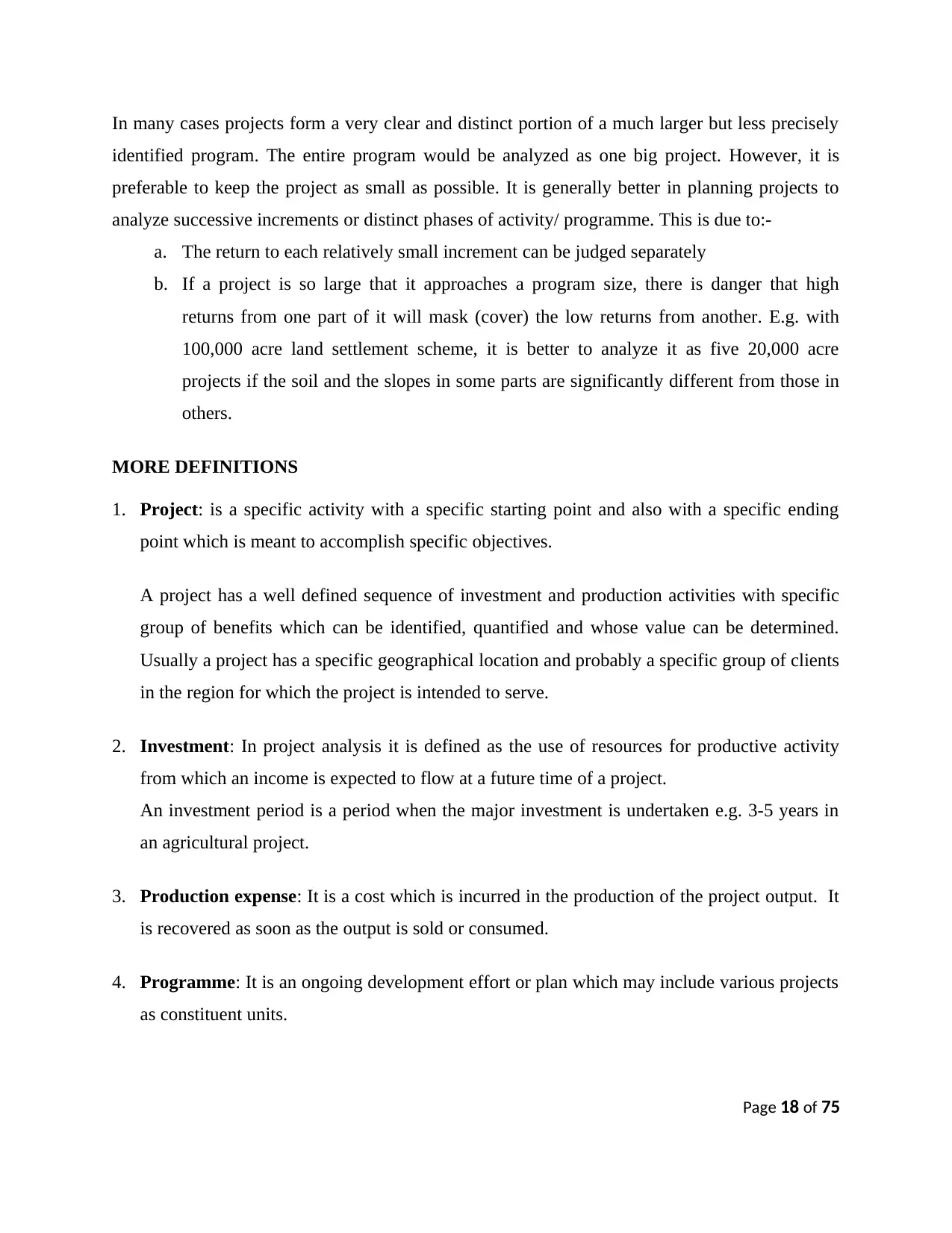
In many cases projects form a very clear and distinct portion of a much larger but less precisely
identified program. The entire program would be analyzed as one big project. However, it is
preferable to keep the project as small as possible. It is generally better in planning projects to
analyze successive increments or distinct phases of activity/ programme. This is due to:-
a. The return to each relatively small increment can be judged separately
b. If a project is so large that it approaches a program size, there is danger that high
returns from one part of it will mask (cover) the low returns from another. E.g. with
100,000 acre land settlement scheme, it is better to analyze it as five 20,000 acre
projects if the soil and the slopes in some parts are significantly different from those in
others.
MORE DEFINITIONS
1. Project: is a specific activity with a specific starting point and also with a specific ending
point which is meant to accomplish specific objectives.
A project has a well defined sequence of investment and production activities with specific
group of benefits which can be identified, quantified and whose value can be determined.
Usually a project has a specific geographical location and probably a specific group of clients
in the region for which the project is intended to serve.
2. Investment: In project analysis it is defined as the use of resources for productive activity
from which an income is expected to flow at a future time of a project.
An investment period is a period when the major investment is undertaken e.g. 3-5 years in
an agricultural project.
3. Production expense: It is a cost which is incurred in the production of the project output. It
is recovered as soon as the output is sold or consumed.
4. Programme: It is an ongoing development effort or plan which may include various projects
as constituent units.
Page 18 of 75
identified program. The entire program would be analyzed as one big project. However, it is
preferable to keep the project as small as possible. It is generally better in planning projects to
analyze successive increments or distinct phases of activity/ programme. This is due to:-
a. The return to each relatively small increment can be judged separately
b. If a project is so large that it approaches a program size, there is danger that high
returns from one part of it will mask (cover) the low returns from another. E.g. with
100,000 acre land settlement scheme, it is better to analyze it as five 20,000 acre
projects if the soil and the slopes in some parts are significantly different from those in
others.
MORE DEFINITIONS
1. Project: is a specific activity with a specific starting point and also with a specific ending
point which is meant to accomplish specific objectives.
A project has a well defined sequence of investment and production activities with specific
group of benefits which can be identified, quantified and whose value can be determined.
Usually a project has a specific geographical location and probably a specific group of clients
in the region for which the project is intended to serve.
2. Investment: In project analysis it is defined as the use of resources for productive activity
from which an income is expected to flow at a future time of a project.
An investment period is a period when the major investment is undertaken e.g. 3-5 years in
an agricultural project.
3. Production expense: It is a cost which is incurred in the production of the project output. It
is recovered as soon as the output is sold or consumed.
4. Programme: It is an ongoing development effort or plan which may include various projects
as constituent units.
Page 18 of 75
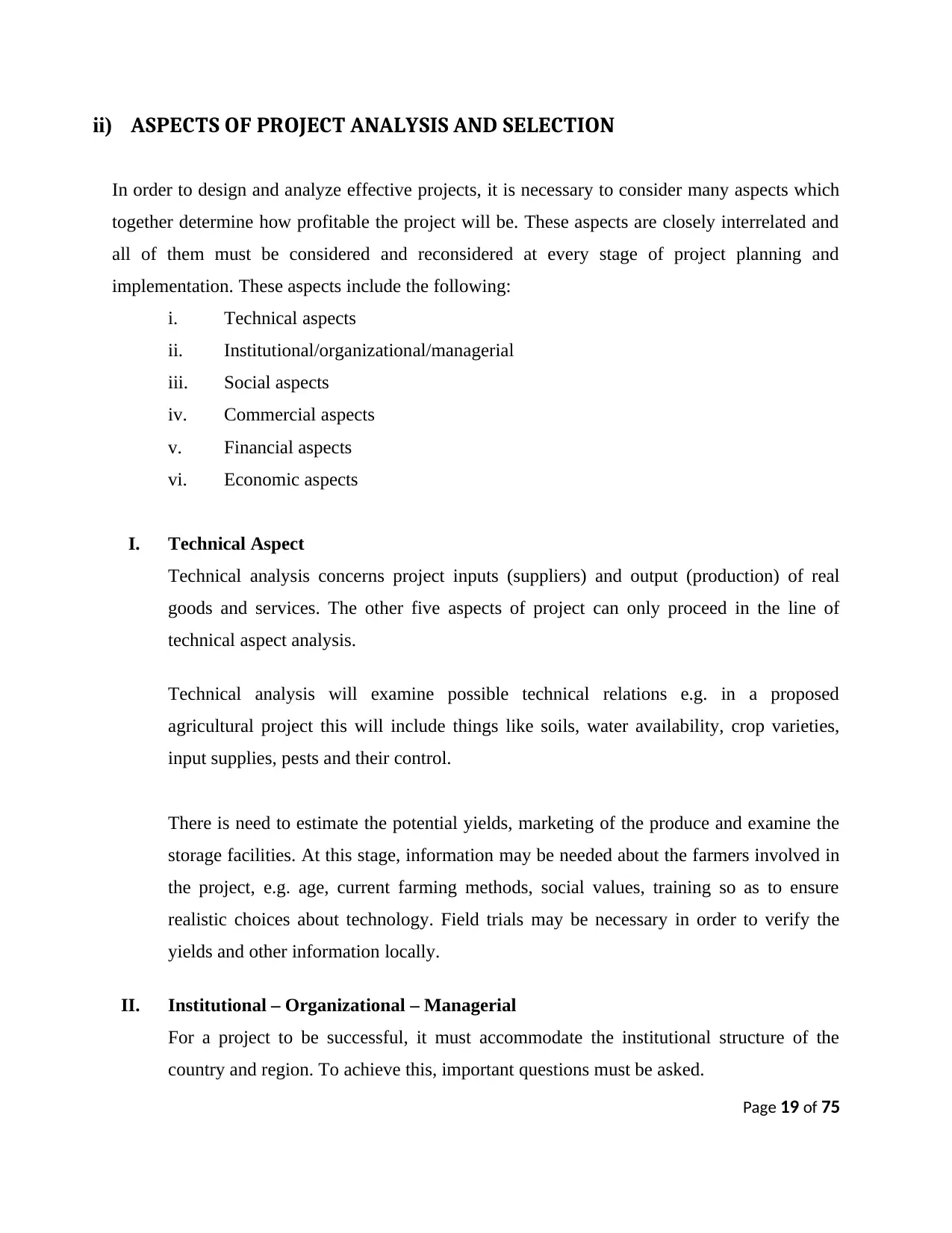
ii) ASPECTS OF PROJECT ANALYSIS AND SELECTION
In order to design and analyze effective projects, it is necessary to consider many aspects which
together determine how profitable the project will be. These aspects are closely interrelated and
all of them must be considered and reconsidered at every stage of project planning and
implementation. These aspects include the following:
i. Technical aspects
ii. Institutional/organizational/managerial
iii. Social aspects
iv. Commercial aspects
v. Financial aspects
vi. Economic aspects
I. Technical Aspect
Technical analysis concerns project inputs (suppliers) and output (production) of real
goods and services. The other five aspects of project can only proceed in the line of
technical aspect analysis.
Technical analysis will examine possible technical relations e.g. in a proposed
agricultural project this will include things like soils, water availability, crop varieties,
input supplies, pests and their control.
There is need to estimate the potential yields, marketing of the produce and examine the
storage facilities. At this stage, information may be needed about the farmers involved in
the project, e.g. age, current farming methods, social values, training so as to ensure
realistic choices about technology. Field trials may be necessary in order to verify the
yields and other information locally.
II. Institutional – Organizational – Managerial
For a project to be successful, it must accommodate the institutional structure of the
country and region. To achieve this, important questions must be asked.
Page 19 of 75
In order to design and analyze effective projects, it is necessary to consider many aspects which
together determine how profitable the project will be. These aspects are closely interrelated and
all of them must be considered and reconsidered at every stage of project planning and
implementation. These aspects include the following:
i. Technical aspects
ii. Institutional/organizational/managerial
iii. Social aspects
iv. Commercial aspects
v. Financial aspects
vi. Economic aspects
I. Technical Aspect
Technical analysis concerns project inputs (suppliers) and output (production) of real
goods and services. The other five aspects of project can only proceed in the line of
technical aspect analysis.
Technical analysis will examine possible technical relations e.g. in a proposed
agricultural project this will include things like soils, water availability, crop varieties,
input supplies, pests and their control.
There is need to estimate the potential yields, marketing of the produce and examine the
storage facilities. At this stage, information may be needed about the farmers involved in
the project, e.g. age, current farming methods, social values, training so as to ensure
realistic choices about technology. Field trials may be necessary in order to verify the
yields and other information locally.
II. Institutional – Organizational – Managerial
For a project to be successful, it must accommodate the institutional structure of the
country and region. To achieve this, important questions must be asked.
Page 19 of 75
Paraphrase This Document
Need a fresh take? Get an instant paraphrase of this document with our AI Paraphraser
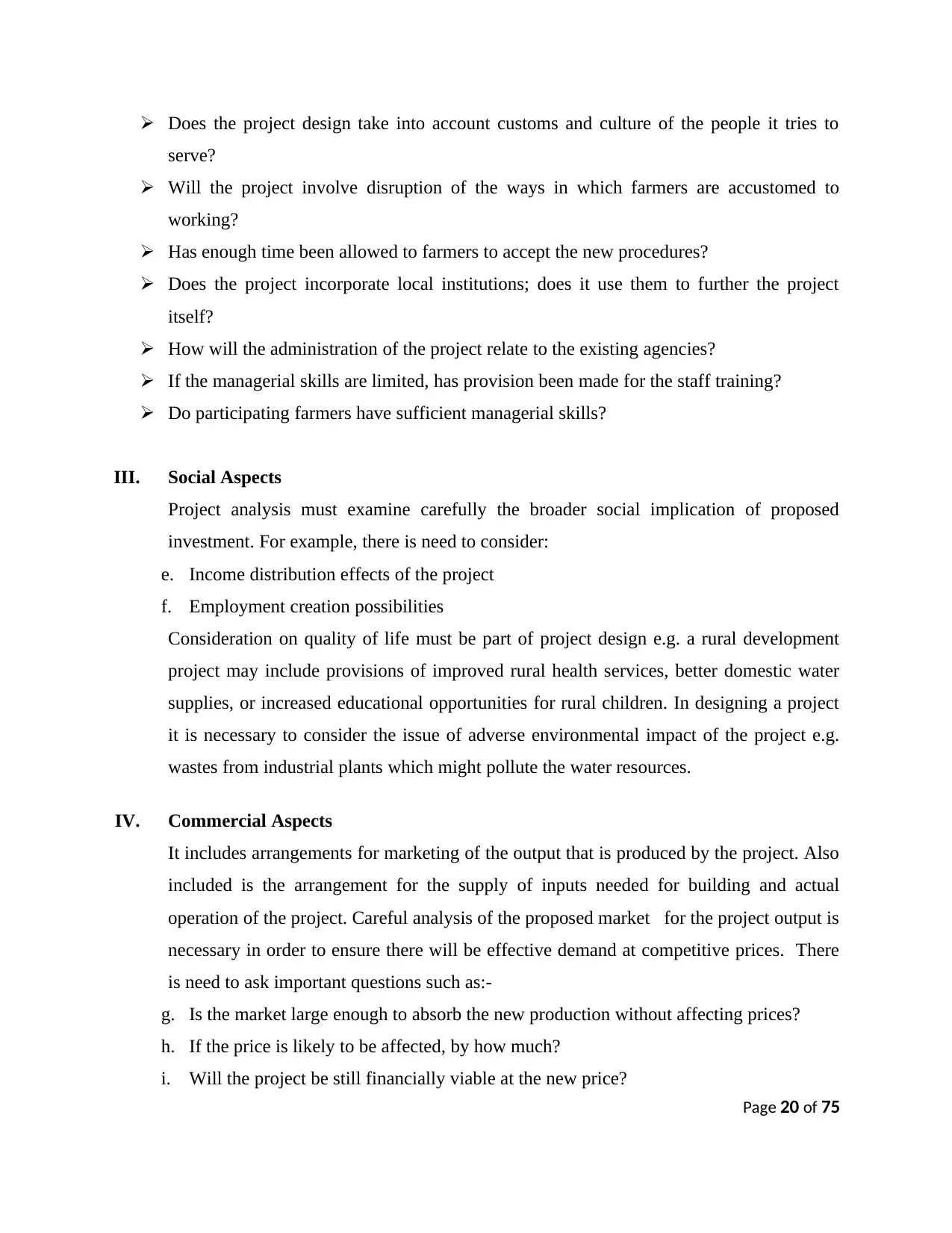
Does the project design take into account customs and culture of the people it tries to
serve?
Will the project involve disruption of the ways in which farmers are accustomed to
working?
Has enough time been allowed to farmers to accept the new procedures?
Does the project incorporate local institutions; does it use them to further the project
itself?
How will the administration of the project relate to the existing agencies?
If the managerial skills are limited, has provision been made for the staff training?
Do participating farmers have sufficient managerial skills?
III. Social Aspects
Project analysis must examine carefully the broader social implication of proposed
investment. For example, there is need to consider:
e. Income distribution effects of the project
f. Employment creation possibilities
Consideration on quality of life must be part of project design e.g. a rural development
project may include provisions of improved rural health services, better domestic water
supplies, or increased educational opportunities for rural children. In designing a project
it is necessary to consider the issue of adverse environmental impact of the project e.g.
wastes from industrial plants which might pollute the water resources.
IV. Commercial Aspects
It includes arrangements for marketing of the output that is produced by the project. Also
included is the arrangement for the supply of inputs needed for building and actual
operation of the project. Careful analysis of the proposed market for the project output is
necessary in order to ensure there will be effective demand at competitive prices. There
is need to ask important questions such as:-
g. Is the market large enough to absorb the new production without affecting prices?
h. If the price is likely to be affected, by how much?
i. Will the project be still financially viable at the new price?
Page 20 of 75
serve?
Will the project involve disruption of the ways in which farmers are accustomed to
working?
Has enough time been allowed to farmers to accept the new procedures?
Does the project incorporate local institutions; does it use them to further the project
itself?
How will the administration of the project relate to the existing agencies?
If the managerial skills are limited, has provision been made for the staff training?
Do participating farmers have sufficient managerial skills?
III. Social Aspects
Project analysis must examine carefully the broader social implication of proposed
investment. For example, there is need to consider:
e. Income distribution effects of the project
f. Employment creation possibilities
Consideration on quality of life must be part of project design e.g. a rural development
project may include provisions of improved rural health services, better domestic water
supplies, or increased educational opportunities for rural children. In designing a project
it is necessary to consider the issue of adverse environmental impact of the project e.g.
wastes from industrial plants which might pollute the water resources.
IV. Commercial Aspects
It includes arrangements for marketing of the output that is produced by the project. Also
included is the arrangement for the supply of inputs needed for building and actual
operation of the project. Careful analysis of the proposed market for the project output is
necessary in order to ensure there will be effective demand at competitive prices. There
is need to ask important questions such as:-
g. Is the market large enough to absorb the new production without affecting prices?
h. If the price is likely to be affected, by how much?
i. Will the project be still financially viable at the new price?
Page 20 of 75
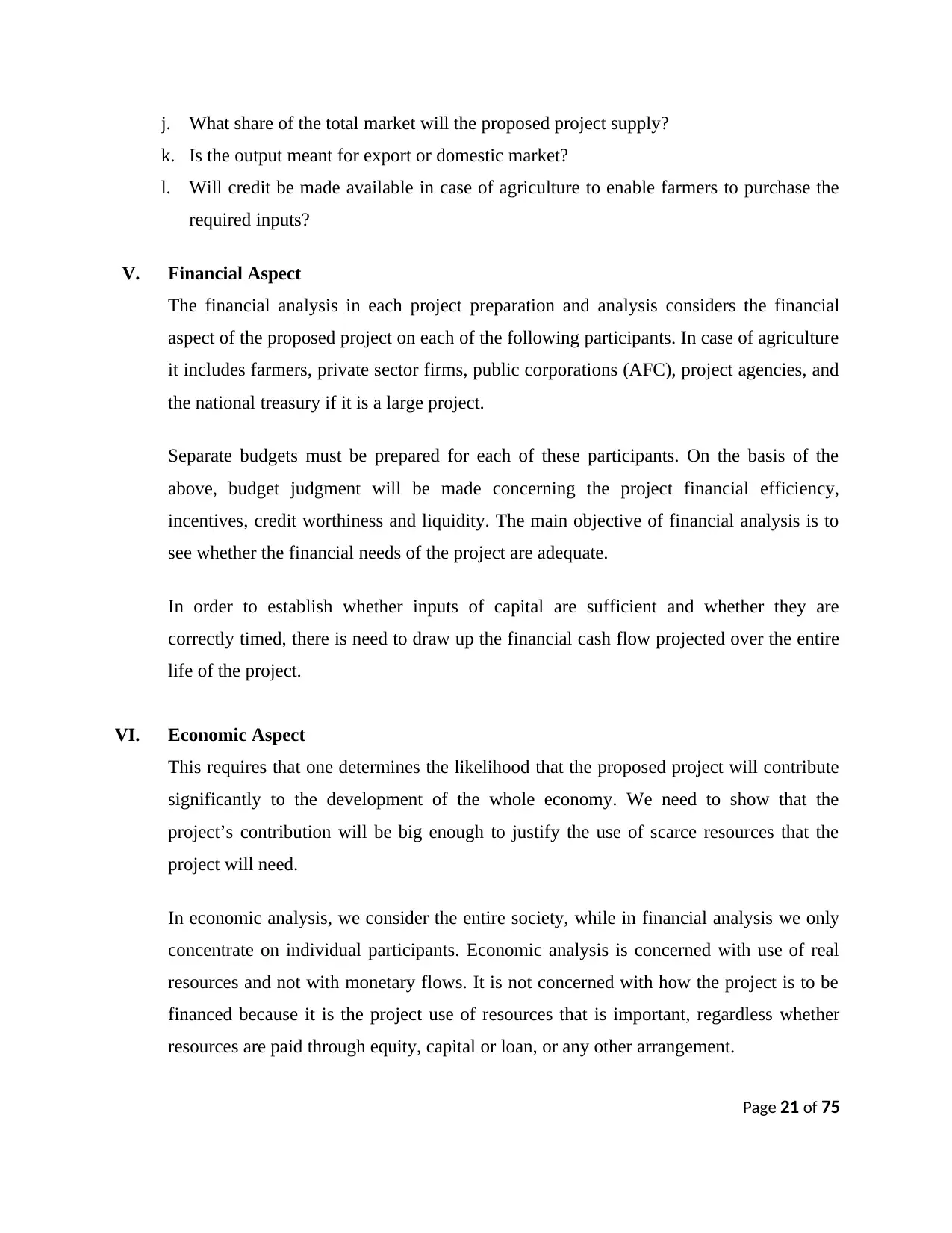
j. What share of the total market will the proposed project supply?
k. Is the output meant for export or domestic market?
l. Will credit be made available in case of agriculture to enable farmers to purchase the
required inputs?
V. Financial Aspect
The financial analysis in each project preparation and analysis considers the financial
aspect of the proposed project on each of the following participants. In case of agriculture
it includes farmers, private sector firms, public corporations (AFC), project agencies, and
the national treasury if it is a large project.
Separate budgets must be prepared for each of these participants. On the basis of the
above, budget judgment will be made concerning the project financial efficiency,
incentives, credit worthiness and liquidity. The main objective of financial analysis is to
see whether the financial needs of the project are adequate.
In order to establish whether inputs of capital are sufficient and whether they are
correctly timed, there is need to draw up the financial cash flow projected over the entire
life of the project.
VI. Economic Aspect
This requires that one determines the likelihood that the proposed project will contribute
significantly to the development of the whole economy. We need to show that the
project’s contribution will be big enough to justify the use of scarce resources that the
project will need.
In economic analysis, we consider the entire society, while in financial analysis we only
concentrate on individual participants. Economic analysis is concerned with use of real
resources and not with monetary flows. It is not concerned with how the project is to be
financed because it is the project use of resources that is important, regardless whether
resources are paid through equity, capital or loan, or any other arrangement.
Page 21 of 75
k. Is the output meant for export or domestic market?
l. Will credit be made available in case of agriculture to enable farmers to purchase the
required inputs?
V. Financial Aspect
The financial analysis in each project preparation and analysis considers the financial
aspect of the proposed project on each of the following participants. In case of agriculture
it includes farmers, private sector firms, public corporations (AFC), project agencies, and
the national treasury if it is a large project.
Separate budgets must be prepared for each of these participants. On the basis of the
above, budget judgment will be made concerning the project financial efficiency,
incentives, credit worthiness and liquidity. The main objective of financial analysis is to
see whether the financial needs of the project are adequate.
In order to establish whether inputs of capital are sufficient and whether they are
correctly timed, there is need to draw up the financial cash flow projected over the entire
life of the project.
VI. Economic Aspect
This requires that one determines the likelihood that the proposed project will contribute
significantly to the development of the whole economy. We need to show that the
project’s contribution will be big enough to justify the use of scarce resources that the
project will need.
In economic analysis, we consider the entire society, while in financial analysis we only
concentrate on individual participants. Economic analysis is concerned with use of real
resources and not with monetary flows. It is not concerned with how the project is to be
financed because it is the project use of resources that is important, regardless whether
resources are paid through equity, capital or loan, or any other arrangement.
Page 21 of 75

We have three important distinctions between economic analysis and financial analysis:
m. In economic analysis, taxes and subsidies are treated as transfer payments which are
ignored but in financial analysis, taxes are treated as a cost while benefits are treated as
benefits.
n. In financial analysis, market prices are normally used (prices distorted by
imperfections) while economic analysis uses shadow prices or social values or
accounting prices.
o. In economic analysis interest on capital is never separated and deducted from the gross
returns because it is part of the total return to capital available to the society as a whole
and because of that, total return including interest is what economic analysis is meant
to estimate. In financial analysis, this is a cost.
Why then do we need both economic and financial analysis? If our interest is
economic analysis, we wish to see if a private individual/ participant would find
the project attractive i.e. we ask a question, will a private participant be interested
in this project?
iii) PROJECT CYCLE
A project cycle is the sequence that is followed or a way in which projects are normally planned
and carried out i.e. where to begin and end. The project cycle has 5 main stages:
- Identification of the project
- Preparation and analysis of the project
- Appraisal of the project
- Implementation of the project
- Evaluation of the project.
Identification of the project stage
This is the first stage where finding a potential project takes place. There are many sources
where suggestions may come from; well informed technical specialists who include local leaders
or from proposals to extend existing programmess. Projects emerge from problems existing in
the society.
Page 22 of 75
m. In economic analysis, taxes and subsidies are treated as transfer payments which are
ignored but in financial analysis, taxes are treated as a cost while benefits are treated as
benefits.
n. In financial analysis, market prices are normally used (prices distorted by
imperfections) while economic analysis uses shadow prices or social values or
accounting prices.
o. In economic analysis interest on capital is never separated and deducted from the gross
returns because it is part of the total return to capital available to the society as a whole
and because of that, total return including interest is what economic analysis is meant
to estimate. In financial analysis, this is a cost.
Why then do we need both economic and financial analysis? If our interest is
economic analysis, we wish to see if a private individual/ participant would find
the project attractive i.e. we ask a question, will a private participant be interested
in this project?
iii) PROJECT CYCLE
A project cycle is the sequence that is followed or a way in which projects are normally planned
and carried out i.e. where to begin and end. The project cycle has 5 main stages:
- Identification of the project
- Preparation and analysis of the project
- Appraisal of the project
- Implementation of the project
- Evaluation of the project.
Identification of the project stage
This is the first stage where finding a potential project takes place. There are many sources
where suggestions may come from; well informed technical specialists who include local leaders
or from proposals to extend existing programmess. Projects emerge from problems existing in
the society.
Page 22 of 75
Secure Best Marks with AI Grader
Need help grading? Try our AI Grader for instant feedback on your assignments.

Preparation and Analysis
It entails a more detailed preparation and analysis of project plan. Included here is all the work
necessary to bring the project to the point at which a careful appraisal can be done. If the project
is a good one, implementation can begin.
All the six aspects considered early are considered at this stage. First step is to carry out a
feasibility study which will provide enough information for deciding whether or not to begin a
more advanced planning. Feasibility study must define the objectives of the project clearly and
must explicitly explain whether or not alternative ways of achieving the objectives exist.
Appraisal of Project
An independent appraisal following project preparation gives opportunity to examine every
aspect whether the proposal is appropriate and sound before large expenditures are incurred.
Implementation Stage
Most important part of the project cycle. Project implementation must be flexible because
circumstances may change and managers must be able to respond intelligently to these changes.
In case of agriculture changes likely to arise will do with prices of output and input.
Implementation is a process of refinement and learning from experience. This stage has 3
periods:
Period 1: This is the investment period during which major project investments are undertaken. It
lasts between 3 and 5 years in the case of agriculture. Where it is applicable, this period
coincides with disbursement of the loan.
Period 2: This is the development period. Here actual project production begins to build up.
Period 3: This is the final period which starts once full development is reached and continues for
the rest of the project life.
Page 23 of 75
It entails a more detailed preparation and analysis of project plan. Included here is all the work
necessary to bring the project to the point at which a careful appraisal can be done. If the project
is a good one, implementation can begin.
All the six aspects considered early are considered at this stage. First step is to carry out a
feasibility study which will provide enough information for deciding whether or not to begin a
more advanced planning. Feasibility study must define the objectives of the project clearly and
must explicitly explain whether or not alternative ways of achieving the objectives exist.
Appraisal of Project
An independent appraisal following project preparation gives opportunity to examine every
aspect whether the proposal is appropriate and sound before large expenditures are incurred.
Implementation Stage
Most important part of the project cycle. Project implementation must be flexible because
circumstances may change and managers must be able to respond intelligently to these changes.
In case of agriculture changes likely to arise will do with prices of output and input.
Implementation is a process of refinement and learning from experience. This stage has 3
periods:
Period 1: This is the investment period during which major project investments are undertaken. It
lasts between 3 and 5 years in the case of agriculture. Where it is applicable, this period
coincides with disbursement of the loan.
Period 2: This is the development period. Here actual project production begins to build up.
Period 3: This is the final period which starts once full development is reached and continues for
the rest of the project life.
Page 23 of 75
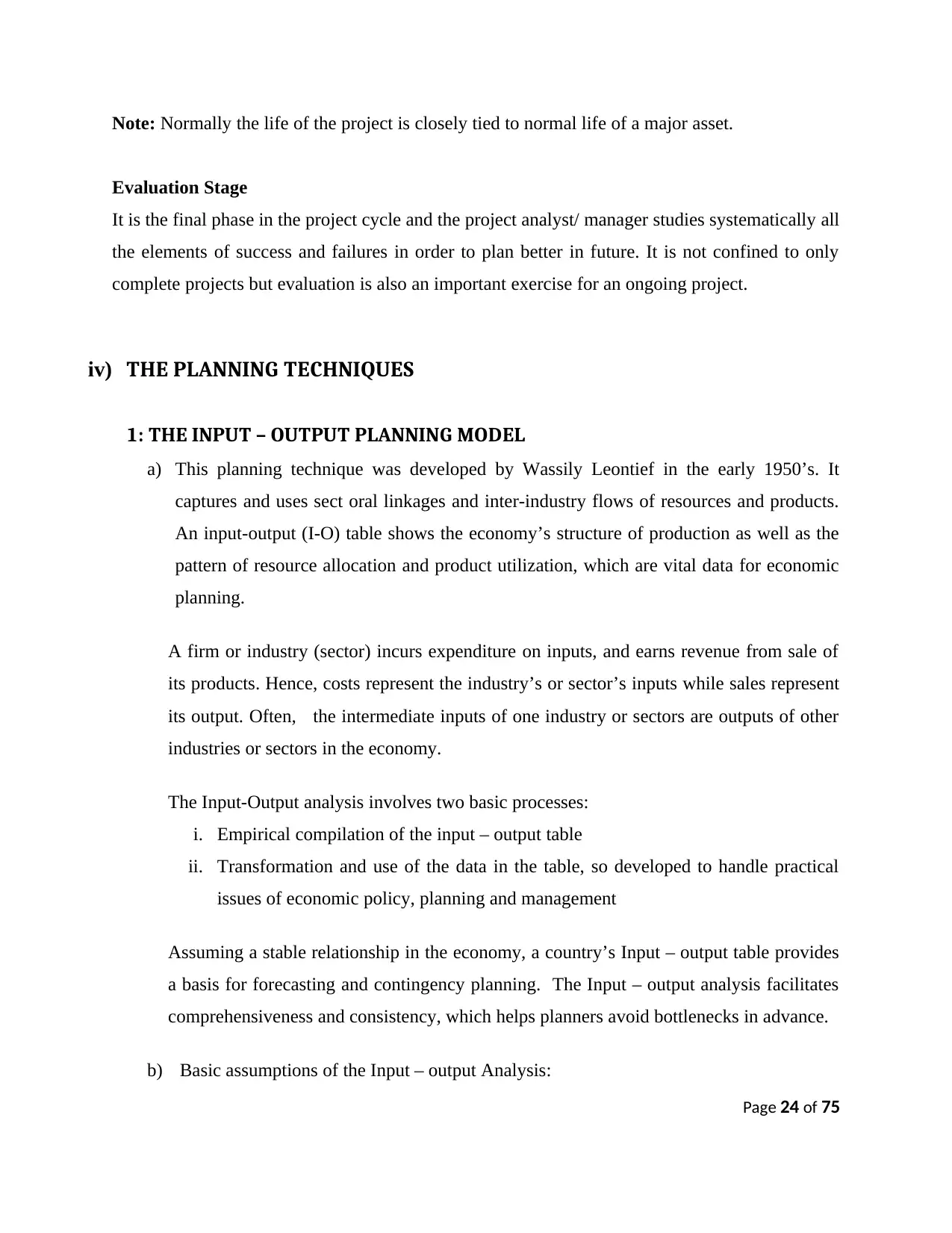
Note: Normally the life of the project is closely tied to normal life of a major asset.
Evaluation Stage
It is the final phase in the project cycle and the project analyst/ manager studies systematically all
the elements of success and failures in order to plan better in future. It is not confined to only
complete projects but evaluation is also an important exercise for an ongoing project.
iv) THE PLANNING TECHNIQUES
1: THE INPUT – OUTPUT PLANNING MODEL
a) This planning technique was developed by Wassily Leontief in the early 1950’s. It
captures and uses sect oral linkages and inter-industry flows of resources and products.
An input-output (I-O) table shows the economy’s structure of production as well as the
pattern of resource allocation and product utilization, which are vital data for economic
planning.
A firm or industry (sector) incurs expenditure on inputs, and earns revenue from sale of
its products. Hence, costs represent the industry’s or sector’s inputs while sales represent
its output. Often, the intermediate inputs of one industry or sectors are outputs of other
industries or sectors in the economy.
The Input-Output analysis involves two basic processes:
i. Empirical compilation of the input – output table
ii. Transformation and use of the data in the table, so developed to handle practical
issues of economic policy, planning and management
Assuming a stable relationship in the economy, a country’s Input – output table provides
a basis for forecasting and contingency planning. The Input – output analysis facilitates
comprehensiveness and consistency, which helps planners avoid bottlenecks in advance.
b) Basic assumptions of the Input – output Analysis:
Page 24 of 75
Evaluation Stage
It is the final phase in the project cycle and the project analyst/ manager studies systematically all
the elements of success and failures in order to plan better in future. It is not confined to only
complete projects but evaluation is also an important exercise for an ongoing project.
iv) THE PLANNING TECHNIQUES
1: THE INPUT – OUTPUT PLANNING MODEL
a) This planning technique was developed by Wassily Leontief in the early 1950’s. It
captures and uses sect oral linkages and inter-industry flows of resources and products.
An input-output (I-O) table shows the economy’s structure of production as well as the
pattern of resource allocation and product utilization, which are vital data for economic
planning.
A firm or industry (sector) incurs expenditure on inputs, and earns revenue from sale of
its products. Hence, costs represent the industry’s or sector’s inputs while sales represent
its output. Often, the intermediate inputs of one industry or sectors are outputs of other
industries or sectors in the economy.
The Input-Output analysis involves two basic processes:
i. Empirical compilation of the input – output table
ii. Transformation and use of the data in the table, so developed to handle practical
issues of economic policy, planning and management
Assuming a stable relationship in the economy, a country’s Input – output table provides
a basis for forecasting and contingency planning. The Input – output analysis facilitates
comprehensiveness and consistency, which helps planners avoid bottlenecks in advance.
b) Basic assumptions of the Input – output Analysis:
Page 24 of 75
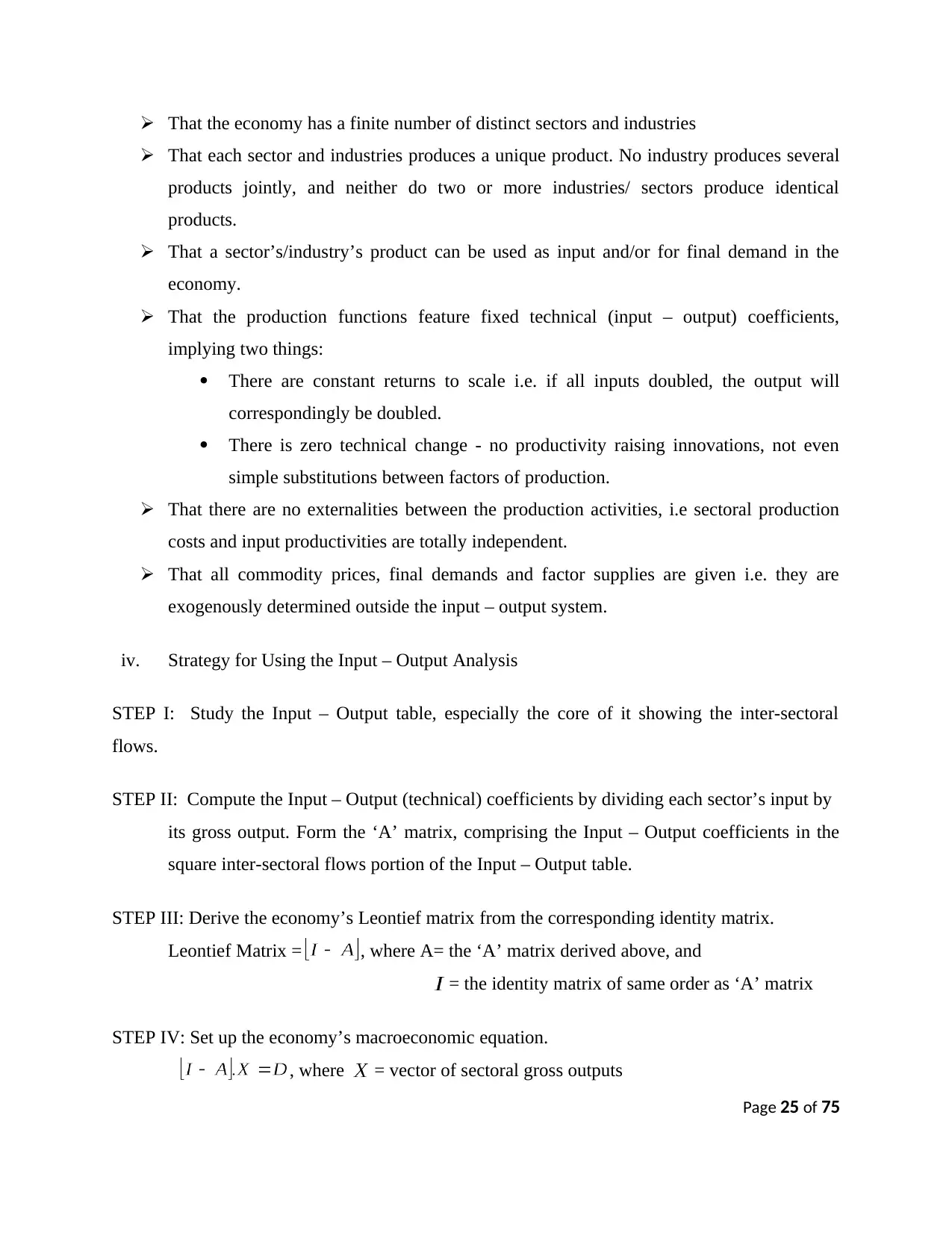
That the economy has a finite number of distinct sectors and industries
That each sector and industries produces a unique product. No industry produces several
products jointly, and neither do two or more industries/ sectors produce identical
products.
That a sector’s/industry’s product can be used as input and/or for final demand in the
economy.
That the production functions feature fixed technical (input – output) coefficients,
implying two things:
There are constant returns to scale i.e. if all inputs doubled, the output will
correspondingly be doubled.
There is zero technical change - no productivity raising innovations, not even
simple substitutions between factors of production.
That there are no externalities between the production activities, i.e sectoral production
costs and input productivities are totally independent.
That all commodity prices, final demands and factor supplies are given i.e. they are
exogenously determined outside the input – output system.
iv. Strategy for Using the Input – Output Analysis
STEP I: Study the Input – Output table, especially the core of it showing the inter-sectoral
flows.
STEP II: Compute the Input – Output (technical) coefficients by dividing each sector’s input by
its gross output. Form the ‘A’ matrix, comprising the Input – Output coefficients in the
square inter-sectoral flows portion of the Input – Output table.
STEP III: Derive the economy’s Leontief matrix from the corresponding identity matrix.
Leontief Matrix = , where A= the ‘A’ matrix derived above, and
= the identity matrix of same order as ‘A’ matrix
STEP IV: Set up the economy’s macroeconomic equation.
, where = vector of sectoral gross outputs
Page 25 of 75
That each sector and industries produces a unique product. No industry produces several
products jointly, and neither do two or more industries/ sectors produce identical
products.
That a sector’s/industry’s product can be used as input and/or for final demand in the
economy.
That the production functions feature fixed technical (input – output) coefficients,
implying two things:
There are constant returns to scale i.e. if all inputs doubled, the output will
correspondingly be doubled.
There is zero technical change - no productivity raising innovations, not even
simple substitutions between factors of production.
That there are no externalities between the production activities, i.e sectoral production
costs and input productivities are totally independent.
That all commodity prices, final demands and factor supplies are given i.e. they are
exogenously determined outside the input – output system.
iv. Strategy for Using the Input – Output Analysis
STEP I: Study the Input – Output table, especially the core of it showing the inter-sectoral
flows.
STEP II: Compute the Input – Output (technical) coefficients by dividing each sector’s input by
its gross output. Form the ‘A’ matrix, comprising the Input – Output coefficients in the
square inter-sectoral flows portion of the Input – Output table.
STEP III: Derive the economy’s Leontief matrix from the corresponding identity matrix.
Leontief Matrix = , where A= the ‘A’ matrix derived above, and
= the identity matrix of same order as ‘A’ matrix
STEP IV: Set up the economy’s macroeconomic equation.
, where = vector of sectoral gross outputs
Page 25 of 75
Paraphrase This Document
Need a fresh take? Get an instant paraphrase of this document with our AI Paraphraser
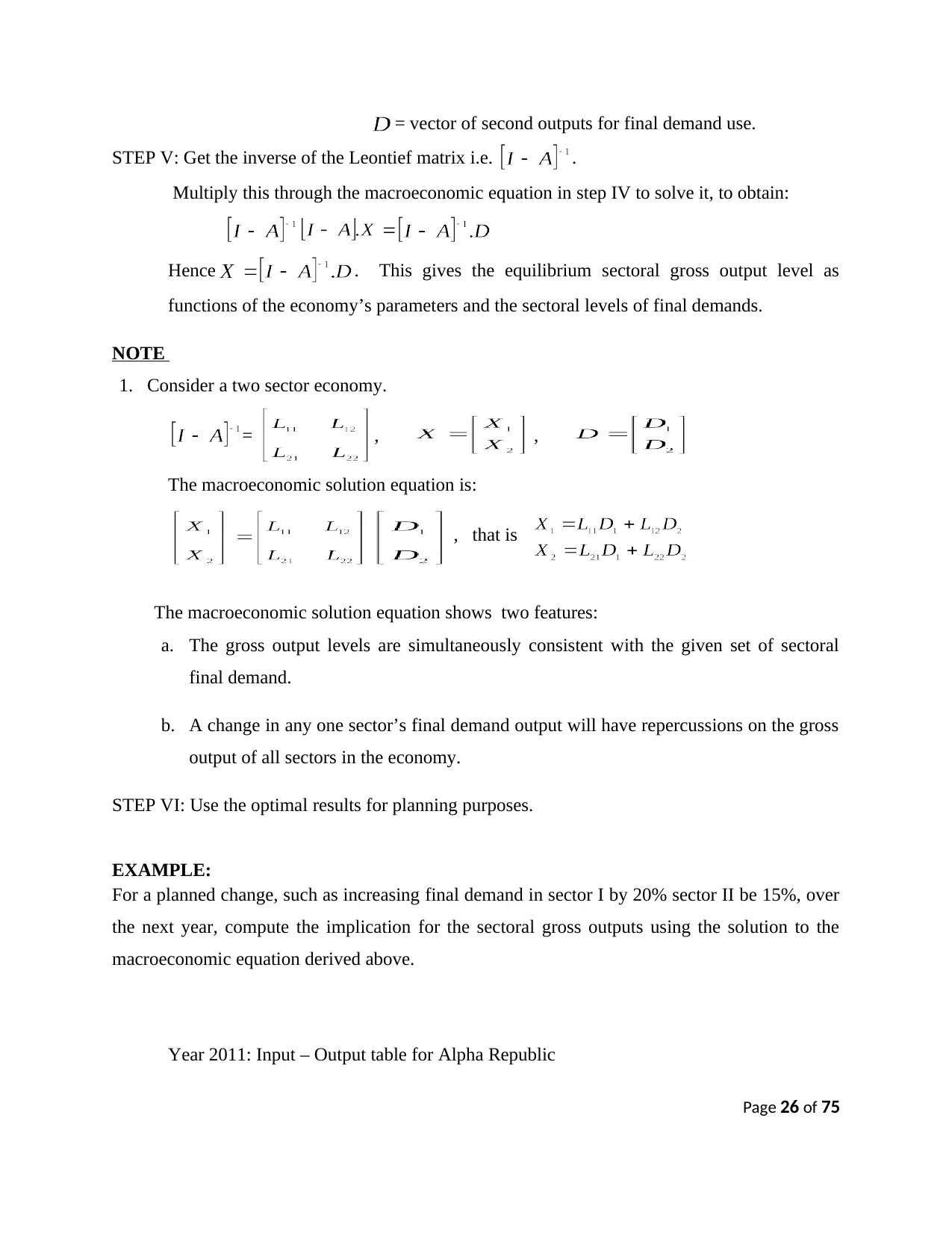
= vector of second outputs for final demand use.
STEP V: Get the inverse of the Leontief matrix i.e. .
Multiply this through the macroeconomic equation in step IV to solve it, to obtain:
Hence . This gives the equilibrium sectoral gross output level as
functions of the economy’s parameters and the sectoral levels of final demands.
NOTE
1. Consider a two sector economy.
= , ,
The macroeconomic solution equation is:
, that is
The macroeconomic solution equation shows two features:
a. The gross output levels are simultaneously consistent with the given set of sectoral
final demand.
b. A change in any one sector’s final demand output will have repercussions on the gross
output of all sectors in the economy.
STEP VI: Use the optimal results for planning purposes.
EXAMPLE:
For a planned change, such as increasing final demand in sector I by 20% sector II be 15%, over
the next year, compute the implication for the sectoral gross outputs using the solution to the
macroeconomic equation derived above.
Year 2011: Input – Output table for Alpha Republic
Page 26 of 75
STEP V: Get the inverse of the Leontief matrix i.e. .
Multiply this through the macroeconomic equation in step IV to solve it, to obtain:
Hence . This gives the equilibrium sectoral gross output level as
functions of the economy’s parameters and the sectoral levels of final demands.
NOTE
1. Consider a two sector economy.
= , ,
The macroeconomic solution equation is:
, that is
The macroeconomic solution equation shows two features:
a. The gross output levels are simultaneously consistent with the given set of sectoral
final demand.
b. A change in any one sector’s final demand output will have repercussions on the gross
output of all sectors in the economy.
STEP VI: Use the optimal results for planning purposes.
EXAMPLE:
For a planned change, such as increasing final demand in sector I by 20% sector II be 15%, over
the next year, compute the implication for the sectoral gross outputs using the solution to the
macroeconomic equation derived above.
Year 2011: Input – Output table for Alpha Republic
Page 26 of 75
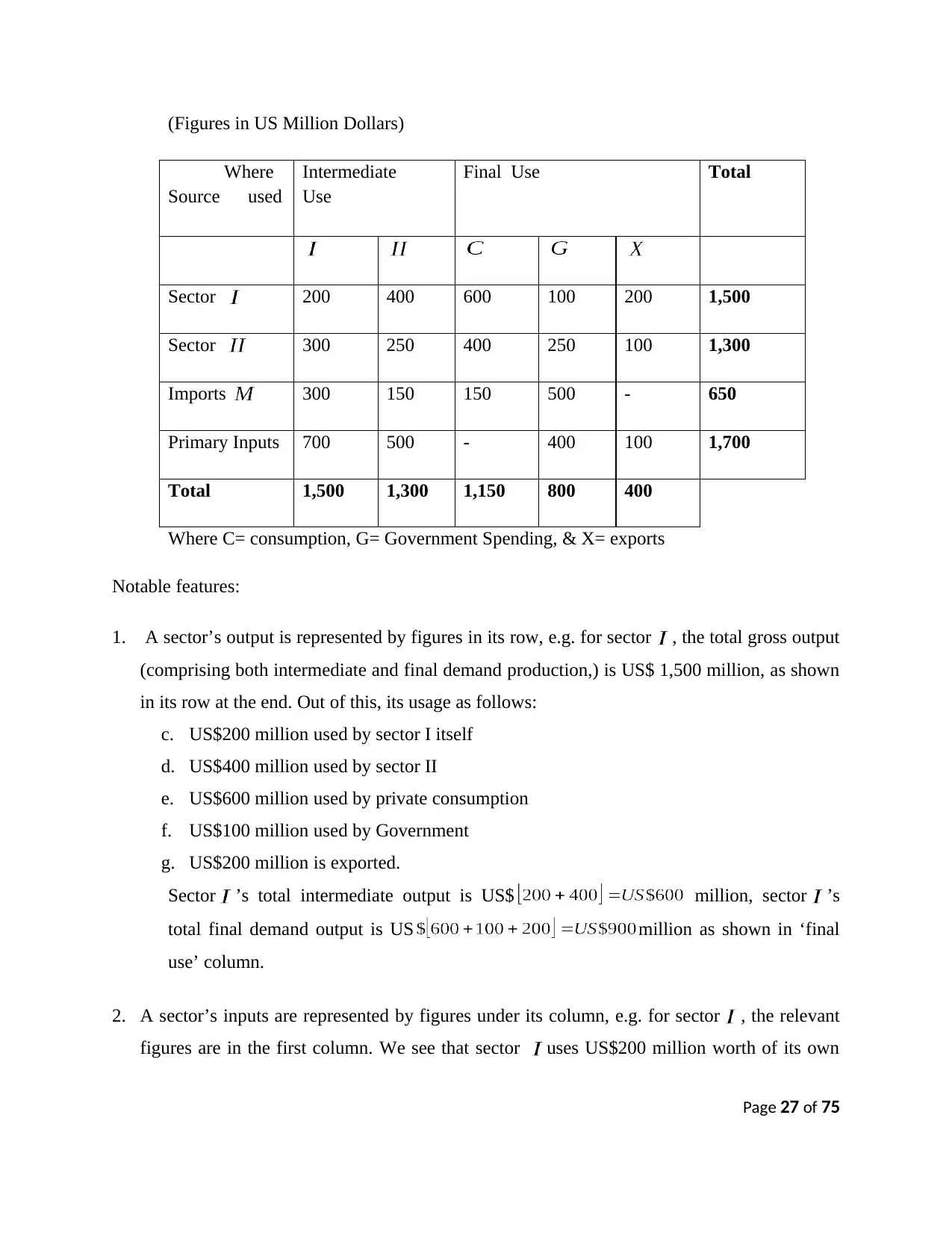
(Figures in US Million Dollars)
Where
Source used
Intermediate
Use
Final Use Total
Sector 200 400 600 100 200 1,500
Sector 300 250 400 250 100 1,300
Imports 300 150 150 500 - 650
Primary Inputs 700 500 - 400 100 1,700
Total 1,500 1,300 1,150 800 400
Where C= consumption, G= Government Spending, & X= exports
Notable features:
1. A sector’s output is represented by figures in its row, e.g. for sector , the total gross output
(comprising both intermediate and final demand production,) is US$ 1,500 million, as shown
in its row at the end. Out of this, its usage as follows:
c. US$200 million used by sector I itself
d. US$400 million used by sector II
e. US$600 million used by private consumption
f. US$100 million used by Government
g. US$200 million is exported.
Sector ’s total intermediate output is US$ million, sector ’s
total final demand output is US million as shown in ‘final
use’ column.
2. A sector’s inputs are represented by figures under its column, e.g. for sector , the relevant
figures are in the first column. We see that sector uses US$200 million worth of its own
Page 27 of 75
Where
Source used
Intermediate
Use
Final Use Total
Sector 200 400 600 100 200 1,500
Sector 300 250 400 250 100 1,300
Imports 300 150 150 500 - 650
Primary Inputs 700 500 - 400 100 1,700
Total 1,500 1,300 1,150 800 400
Where C= consumption, G= Government Spending, & X= exports
Notable features:
1. A sector’s output is represented by figures in its row, e.g. for sector , the total gross output
(comprising both intermediate and final demand production,) is US$ 1,500 million, as shown
in its row at the end. Out of this, its usage as follows:
c. US$200 million used by sector I itself
d. US$400 million used by sector II
e. US$600 million used by private consumption
f. US$100 million used by Government
g. US$200 million is exported.
Sector ’s total intermediate output is US$ million, sector ’s
total final demand output is US million as shown in ‘final
use’ column.
2. A sector’s inputs are represented by figures under its column, e.g. for sector , the relevant
figures are in the first column. We see that sector uses US$200 million worth of its own
Page 27 of 75
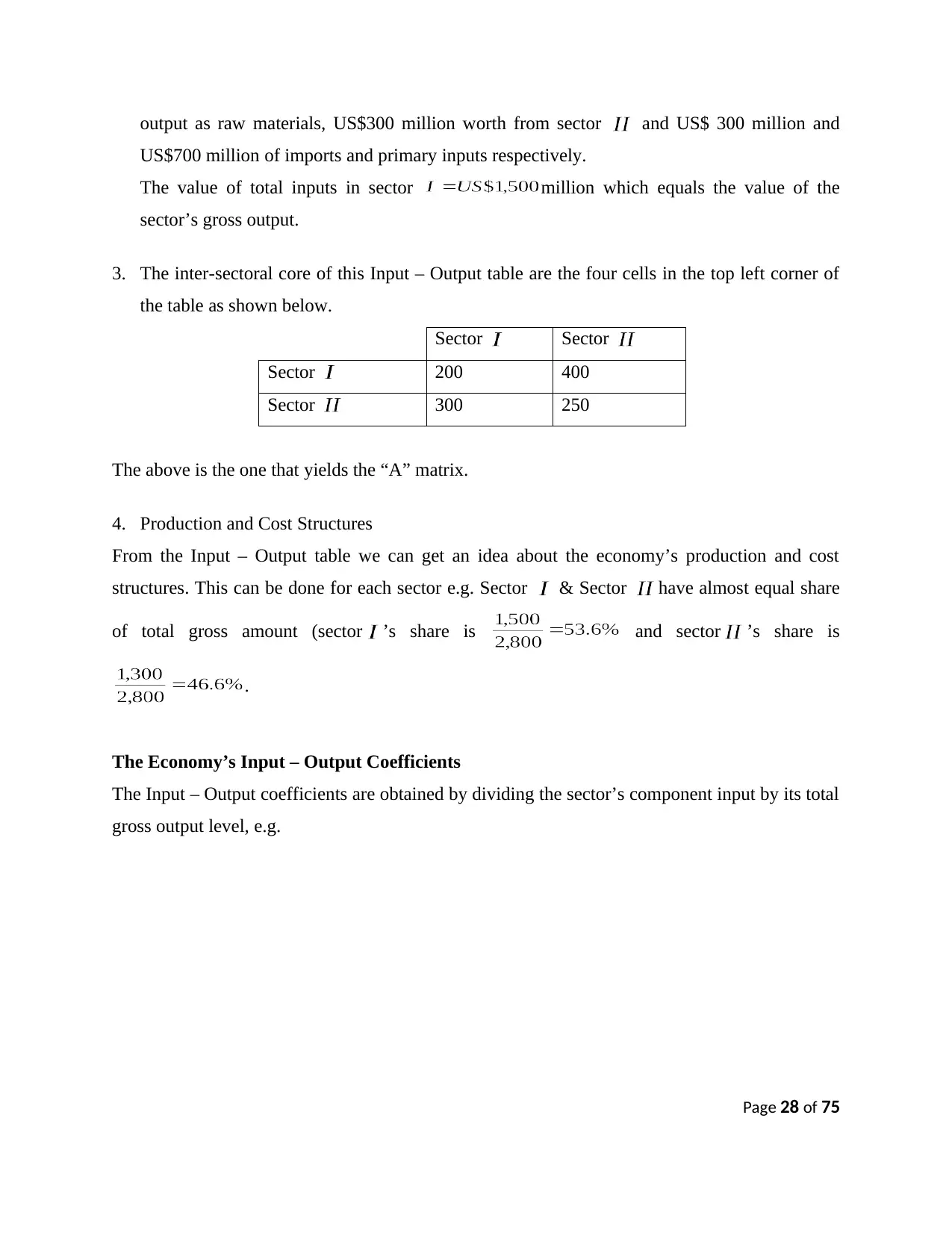
output as raw materials, US$300 million worth from sector and US$ 300 million and
US$700 million of imports and primary inputs respectively.
The value of total inputs in sector million which equals the value of the
sector’s gross output.
3. The inter-sectoral core of this Input – Output table are the four cells in the top left corner of
the table as shown below.
Sector Sector
Sector 200 400
Sector 300 250
The above is the one that yields the “A” matrix.
4. Production and Cost Structures
From the Input – Output table we can get an idea about the economy’s production and cost
structures. This can be done for each sector e.g. Sector & Sector have almost equal share
of total gross amount (sector ’s share is and sector ’s share is
.
The Economy’s Input – Output Coefficients
The Input – Output coefficients are obtained by dividing the sector’s component input by its total
gross output level, e.g.
Page 28 of 75
US$700 million of imports and primary inputs respectively.
The value of total inputs in sector million which equals the value of the
sector’s gross output.
3. The inter-sectoral core of this Input – Output table are the four cells in the top left corner of
the table as shown below.
Sector Sector
Sector 200 400
Sector 300 250
The above is the one that yields the “A” matrix.
4. Production and Cost Structures
From the Input – Output table we can get an idea about the economy’s production and cost
structures. This can be done for each sector e.g. Sector & Sector have almost equal share
of total gross amount (sector ’s share is and sector ’s share is
.
The Economy’s Input – Output Coefficients
The Input – Output coefficients are obtained by dividing the sector’s component input by its total
gross output level, e.g.
Page 28 of 75
Secure Best Marks with AI Grader
Need help grading? Try our AI Grader for instant feedback on your assignments.
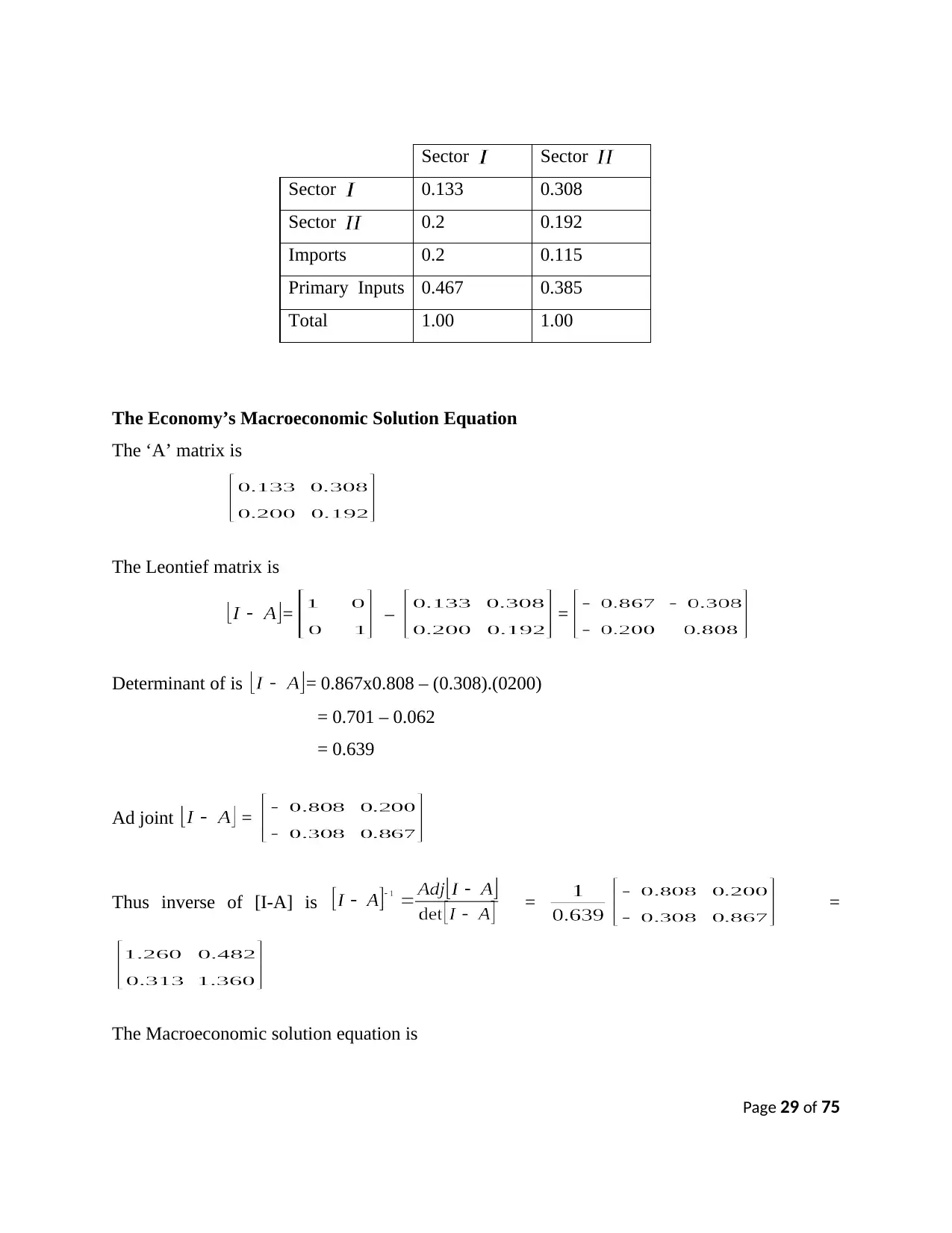
Sector Sector
Sector 0.133 0.308
Sector 0.2 0.192
Imports 0.2 0.115
Primary Inputs 0.467 0.385
Total 1.00 1.00
The Economy’s Macroeconomic Solution Equation
The ‘A’ matrix is
The Leontief matrix is
= – =
Determinant of is = 0.867x0.808 – (0.308).(0200)
= 0.701 – 0.062
= 0.639
Ad joint =
Thus inverse of [I-A] is = =
The Macroeconomic solution equation is
Page 29 of 75
Sector 0.133 0.308
Sector 0.2 0.192
Imports 0.2 0.115
Primary Inputs 0.467 0.385
Total 1.00 1.00
The Economy’s Macroeconomic Solution Equation
The ‘A’ matrix is
The Leontief matrix is
= – =
Determinant of is = 0.867x0.808 – (0.308).(0200)
= 0.701 – 0.062
= 0.639
Ad joint =
Thus inverse of [I-A] is = =
The Macroeconomic solution equation is
Page 29 of 75
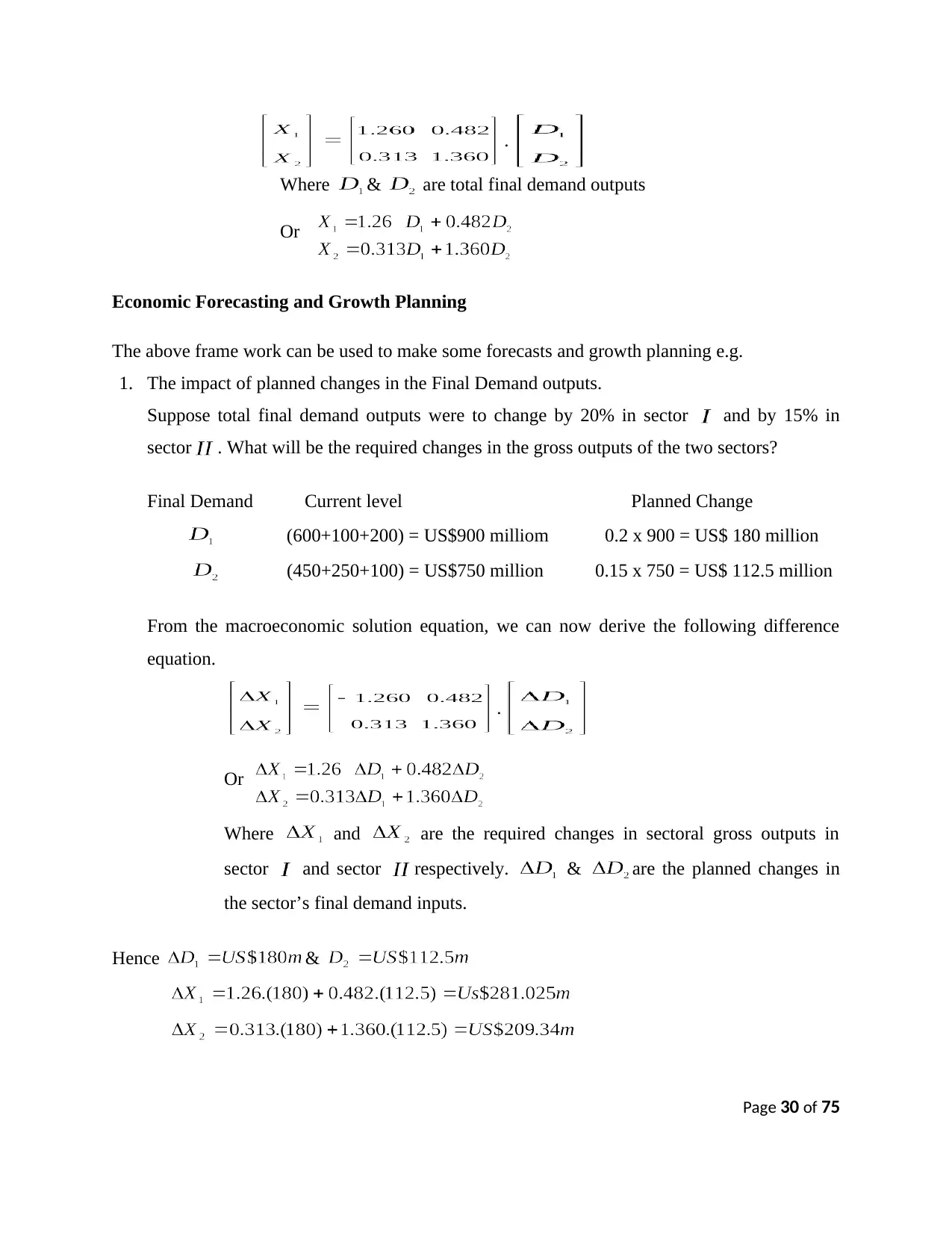
.
Where & are total final demand outputs
Or
Economic Forecasting and Growth Planning
The above frame work can be used to make some forecasts and growth planning e.g.
1. The impact of planned changes in the Final Demand outputs.
Suppose total final demand outputs were to change by 20% in sector and by 15% in
sector . What will be the required changes in the gross outputs of the two sectors?
Final Demand Current level Planned Change
(600+100+200) = US$900 milliom 0.2 x 900 = US$ 180 million
(450+250+100) = US$750 million 0.15 x 750 = US$ 112.5 million
From the macroeconomic solution equation, we can now derive the following difference
equation.
.
Or
Where and are the required changes in sectoral gross outputs in
sector and sector respectively. & are the planned changes in
the sector’s final demand inputs.
Hence &
Page 30 of 75
Where & are total final demand outputs
Or
Economic Forecasting and Growth Planning
The above frame work can be used to make some forecasts and growth planning e.g.
1. The impact of planned changes in the Final Demand outputs.
Suppose total final demand outputs were to change by 20% in sector and by 15% in
sector . What will be the required changes in the gross outputs of the two sectors?
Final Demand Current level Planned Change
(600+100+200) = US$900 milliom 0.2 x 900 = US$ 180 million
(450+250+100) = US$750 million 0.15 x 750 = US$ 112.5 million
From the macroeconomic solution equation, we can now derive the following difference
equation.
.
Or
Where and are the required changes in sectoral gross outputs in
sector and sector respectively. & are the planned changes in
the sector’s final demand inputs.
Hence &
Page 30 of 75
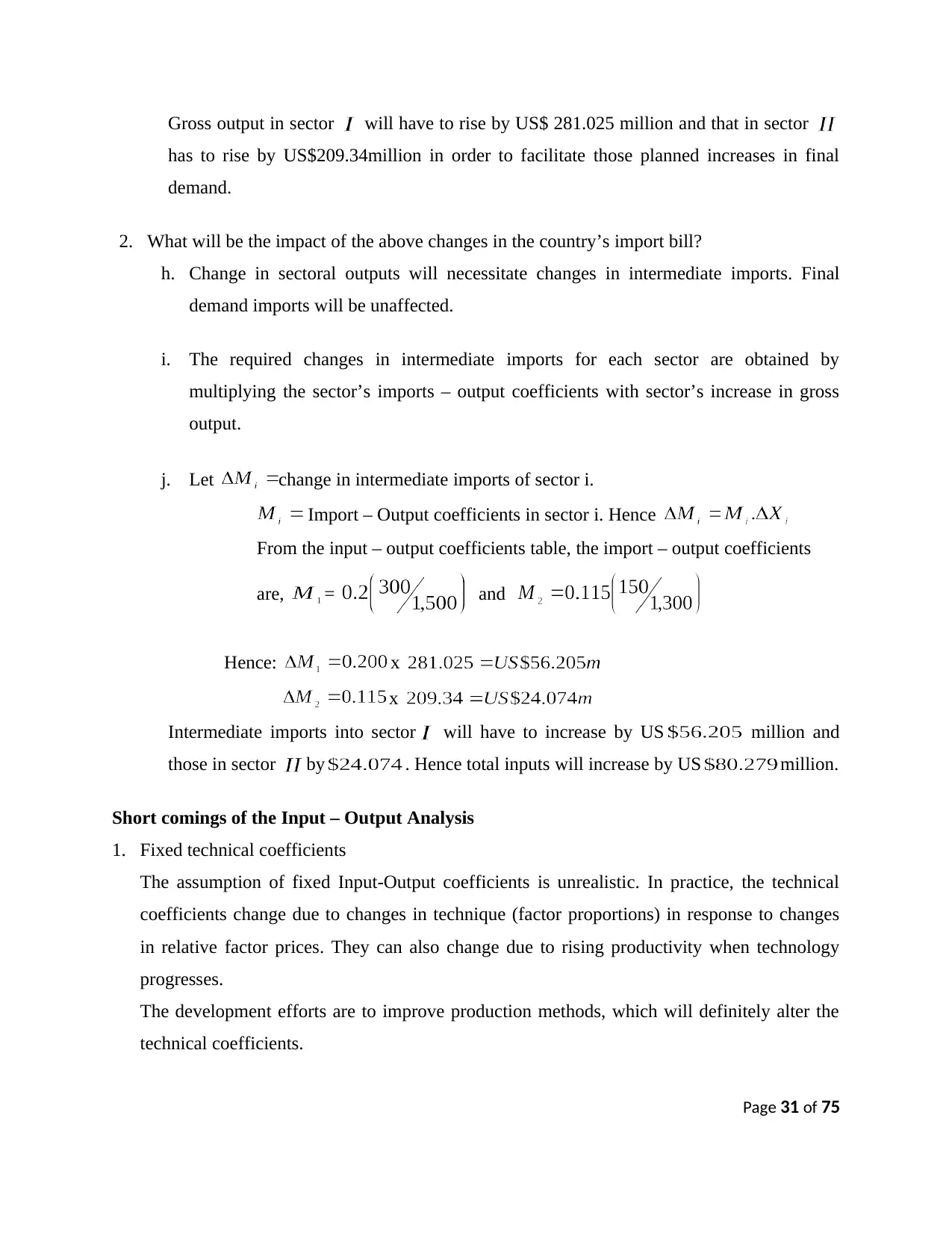
Gross output in sector will have to rise by US$ 281.025 million and that in sector
has to rise by US$209.34million in order to facilitate those planned increases in final
demand.
2. What will be the impact of the above changes in the country’s import bill?
h. Change in sectoral outputs will necessitate changes in intermediate imports. Final
demand imports will be unaffected.
i. The required changes in intermediate imports for each sector are obtained by
multiplying the sector’s imports – output coefficients with sector’s increase in gross
output.
j. Let change in intermediate imports of sector i.
Import – Output coefficients in sector i. Hence
From the input – output coefficients table, the import – output coefficients
are, = and
Hence: x
x
Intermediate imports into sector will have to increase by US million and
those in sector by . Hence total inputs will increase by US million.
Short comings of the Input – Output Analysis
1. Fixed technical coefficients
The assumption of fixed Input-Output coefficients is unrealistic. In practice, the technical
coefficients change due to changes in technique (factor proportions) in response to changes
in relative factor prices. They can also change due to rising productivity when technology
progresses.
The development efforts are to improve production methods, which will definitely alter the
technical coefficients.
Page 31 of 75
has to rise by US$209.34million in order to facilitate those planned increases in final
demand.
2. What will be the impact of the above changes in the country’s import bill?
h. Change in sectoral outputs will necessitate changes in intermediate imports. Final
demand imports will be unaffected.
i. The required changes in intermediate imports for each sector are obtained by
multiplying the sector’s imports – output coefficients with sector’s increase in gross
output.
j. Let change in intermediate imports of sector i.
Import – Output coefficients in sector i. Hence
From the input – output coefficients table, the import – output coefficients
are, = and
Hence: x
x
Intermediate imports into sector will have to increase by US million and
those in sector by . Hence total inputs will increase by US million.
Short comings of the Input – Output Analysis
1. Fixed technical coefficients
The assumption of fixed Input-Output coefficients is unrealistic. In practice, the technical
coefficients change due to changes in technique (factor proportions) in response to changes
in relative factor prices. They can also change due to rising productivity when technology
progresses.
The development efforts are to improve production methods, which will definitely alter the
technical coefficients.
Page 31 of 75
Paraphrase This Document
Need a fresh take? Get an instant paraphrase of this document with our AI Paraphraser

Thus the predictions and plans using this model carry some margin of error because of the
use of constant parameters.
2. High Aggregation.
Construction of a country’s Input – Output table entails a high degree of data aggregation.
Such aggregation hides away some details.
3. Assumption of Fixed Prices
The analysis does not allow for price adjustments. And when these are introduced into the
model it becomes very complicated.
4. Voluminous Data
Input – Output analysis requires collection, analysis, storage, and use of large quantities of
data. Before the advent of computer technology, this was a very cumbersome exercise.
However, computers have reduced the seriousness of this data measurement problem.
2: OTHER PLANNING TECHNIQUES
a) THE INCREMENTAL CAPITAL – OUTPUT RATIO (ICOR)
The Capital-Output Ratio (COR) is the ratio of the money value of capital in use to the money
value of the resultant output.
i.e.
It is the reciprocal of the average product of capital.
The incremental Capital-Output Ratio (ICOR) is an index of the ratio of the value of net
investment in any period to the value of the resultant increase in production that year.
Page 32 of 75
use of constant parameters.
2. High Aggregation.
Construction of a country’s Input – Output table entails a high degree of data aggregation.
Such aggregation hides away some details.
3. Assumption of Fixed Prices
The analysis does not allow for price adjustments. And when these are introduced into the
model it becomes very complicated.
4. Voluminous Data
Input – Output analysis requires collection, analysis, storage, and use of large quantities of
data. Before the advent of computer technology, this was a very cumbersome exercise.
However, computers have reduced the seriousness of this data measurement problem.
2: OTHER PLANNING TECHNIQUES
a) THE INCREMENTAL CAPITAL – OUTPUT RATIO (ICOR)
The Capital-Output Ratio (COR) is the ratio of the money value of capital in use to the money
value of the resultant output.
i.e.
It is the reciprocal of the average product of capital.
The incremental Capital-Output Ratio (ICOR) is an index of the ratio of the value of net
investment in any period to the value of the resultant increase in production that year.
Page 32 of 75

Where = total net investment in the year
is the reciprocal of the marginal productivity of capital, i.e.
Hence
Sectoral and National
1. Sectoral
The productivity of capital varies from sector to sector. It also varies over time in each
sector. ICOR varies over sectors and over time.
2. National
The for the entire economy is a weighted sum of the sectoral
Let = of sector i
= the national
= the share of sector i in the country’s GDP
= the total number of sectors in the economy
Hence = + +.....+ =
The national ICOR will change over time due to changes in the sectoral shares of GDP (
) and due to change in sectoral .
Determinants of the
differs between countries due to inter country differences in the productivity of
capital. The variations in productivity are due to the following factors:
k. Inter-country differences in endowments of other factors of production (besides
capital)
l. Differences in the conditions of the countries’ infrastructure
m. Differences in the level and application of science and technology.
Applications of ICOR in Growth Accounting
Page 33 of 75
is the reciprocal of the marginal productivity of capital, i.e.
Hence
Sectoral and National
1. Sectoral
The productivity of capital varies from sector to sector. It also varies over time in each
sector. ICOR varies over sectors and over time.
2. National
The for the entire economy is a weighted sum of the sectoral
Let = of sector i
= the national
= the share of sector i in the country’s GDP
= the total number of sectors in the economy
Hence = + +.....+ =
The national ICOR will change over time due to changes in the sectoral shares of GDP (
) and due to change in sectoral .
Determinants of the
differs between countries due to inter country differences in the productivity of
capital. The variations in productivity are due to the following factors:
k. Inter-country differences in endowments of other factors of production (besides
capital)
l. Differences in the conditions of the countries’ infrastructure
m. Differences in the level and application of science and technology.
Applications of ICOR in Growth Accounting
Page 33 of 75
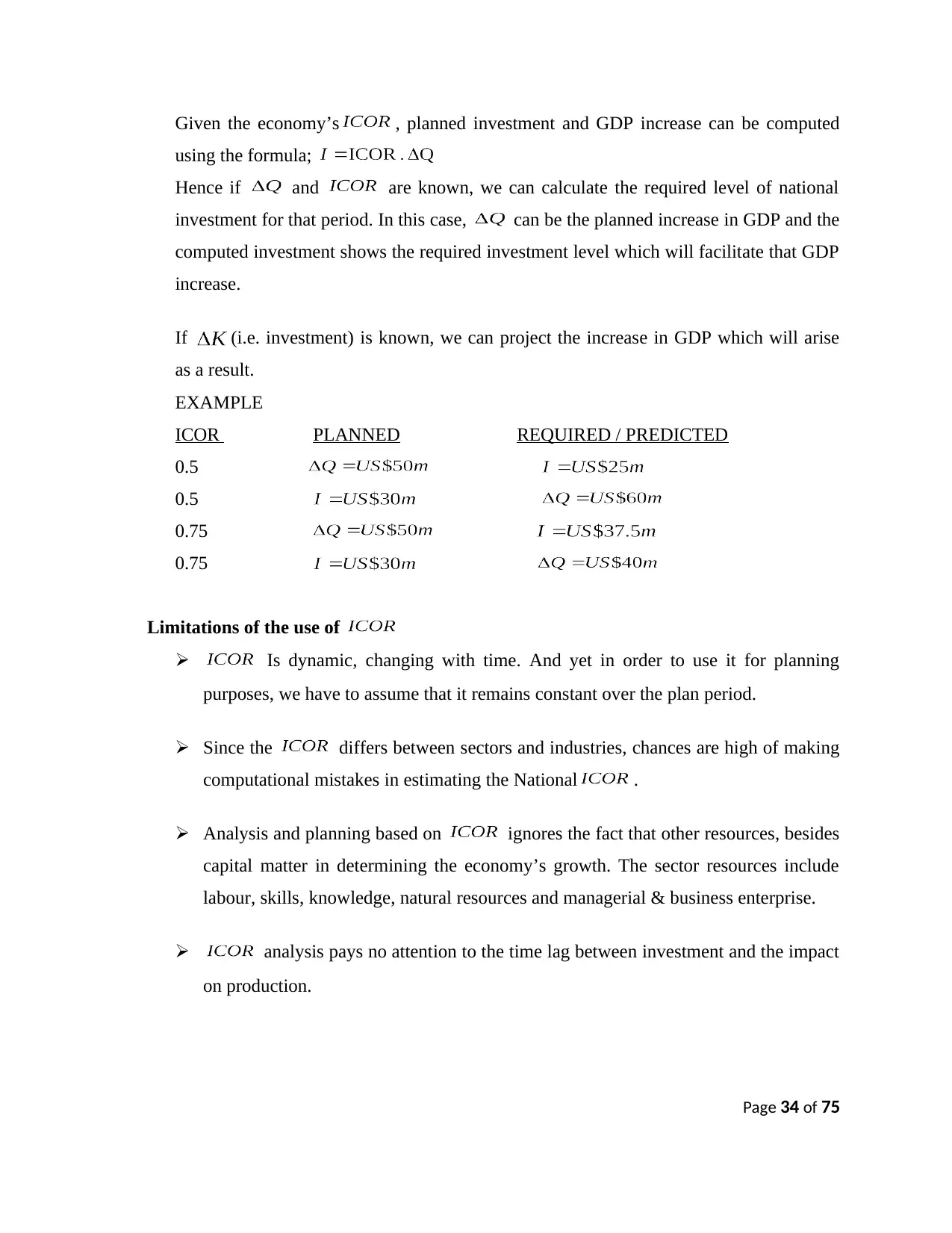
Given the economy’s , planned investment and GDP increase can be computed
using the formula;
Hence if and are known, we can calculate the required level of national
investment for that period. In this case, can be the planned increase in GDP and the
computed investment shows the required investment level which will facilitate that GDP
increase.
If (i.e. investment) is known, we can project the increase in GDP which will arise
as a result.
EXAMPLE
ICOR PLANNED REQUIRED / PREDICTED
0.5
0.5
0.75
0.75
Limitations of the use of
Is dynamic, changing with time. And yet in order to use it for planning
purposes, we have to assume that it remains constant over the plan period.
Since the differs between sectors and industries, chances are high of making
computational mistakes in estimating the National .
Analysis and planning based on ignores the fact that other resources, besides
capital matter in determining the economy’s growth. The sector resources include
labour, skills, knowledge, natural resources and managerial & business enterprise.
analysis pays no attention to the time lag between investment and the impact
on production.
Page 34 of 75
using the formula;
Hence if and are known, we can calculate the required level of national
investment for that period. In this case, can be the planned increase in GDP and the
computed investment shows the required investment level which will facilitate that GDP
increase.
If (i.e. investment) is known, we can project the increase in GDP which will arise
as a result.
EXAMPLE
ICOR PLANNED REQUIRED / PREDICTED
0.5
0.5
0.75
0.75
Limitations of the use of
Is dynamic, changing with time. And yet in order to use it for planning
purposes, we have to assume that it remains constant over the plan period.
Since the differs between sectors and industries, chances are high of making
computational mistakes in estimating the National .
Analysis and planning based on ignores the fact that other resources, besides
capital matter in determining the economy’s growth. The sector resources include
labour, skills, knowledge, natural resources and managerial & business enterprise.
analysis pays no attention to the time lag between investment and the impact
on production.
Page 34 of 75
Secure Best Marks with AI Grader
Need help grading? Try our AI Grader for instant feedback on your assignments.
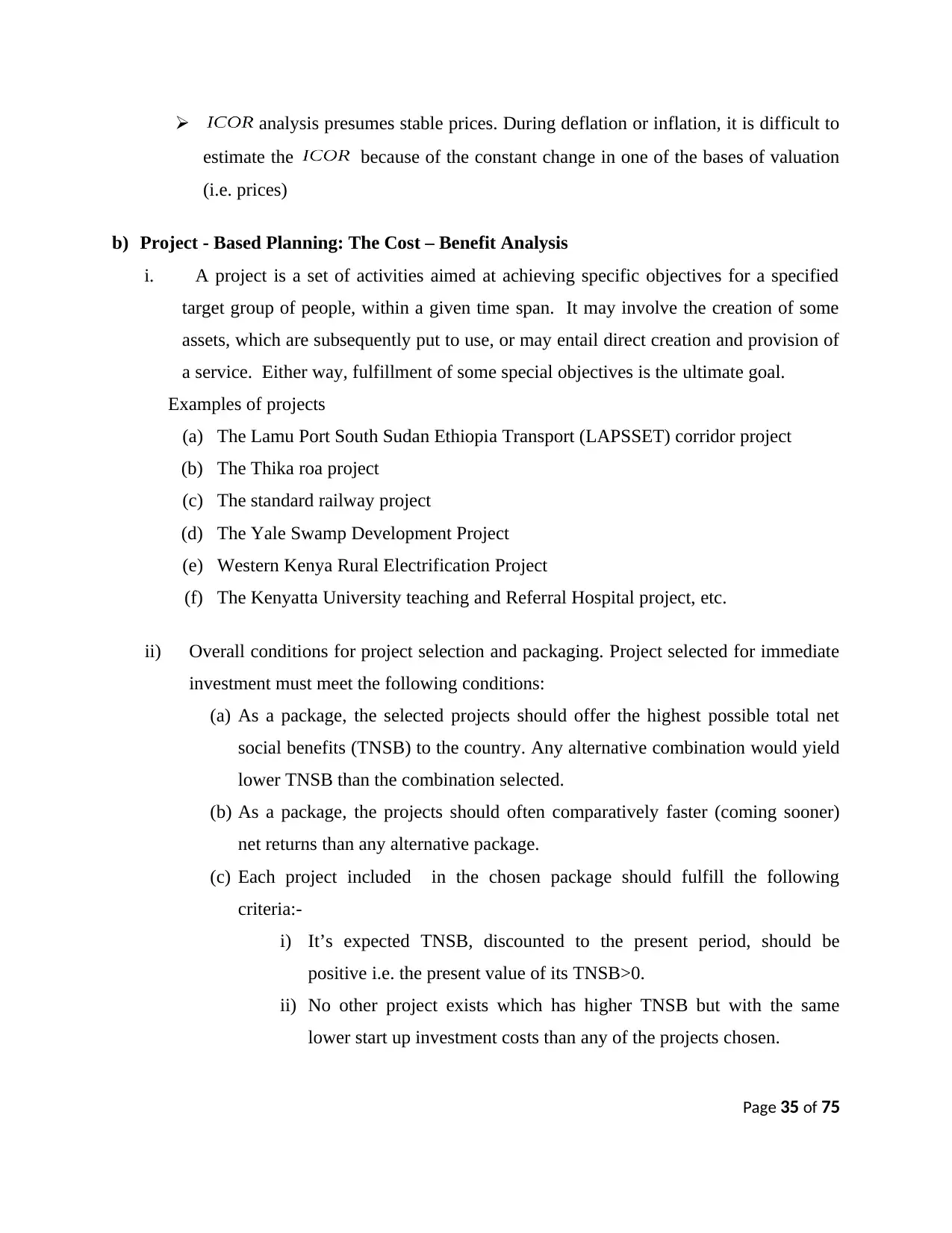
analysis presumes stable prices. During deflation or inflation, it is difficult to
estimate the because of the constant change in one of the bases of valuation
(i.e. prices)
b) Project - Based Planning: The Cost – Benefit Analysis
i. A project is a set of activities aimed at achieving specific objectives for a specified
target group of people, within a given time span. It may involve the creation of some
assets, which are subsequently put to use, or may entail direct creation and provision of
a service. Either way, fulfillment of some special objectives is the ultimate goal.
Examples of projects
(a) The Lamu Port South Sudan Ethiopia Transport (LAPSSET) corridor project
(b) The Thika roa project
(c) The standard railway project
(d) The Yale Swamp Development Project
(e) Western Kenya Rural Electrification Project
(f) The Kenyatta University teaching and Referral Hospital project, etc.
ii) Overall conditions for project selection and packaging. Project selected for immediate
investment must meet the following conditions:
(a) As a package, the selected projects should offer the highest possible total net
social benefits (TNSB) to the country. Any alternative combination would yield
lower TNSB than the combination selected.
(b) As a package, the projects should often comparatively faster (coming sooner)
net returns than any alternative package.
(c) Each project included in the chosen package should fulfill the following
criteria:-
i) It’s expected TNSB, discounted to the present period, should be
positive i.e. the present value of its TNSB>0.
ii) No other project exists which has higher TNSB but with the same
lower start up investment costs than any of the projects chosen.
Page 35 of 75
estimate the because of the constant change in one of the bases of valuation
(i.e. prices)
b) Project - Based Planning: The Cost – Benefit Analysis
i. A project is a set of activities aimed at achieving specific objectives for a specified
target group of people, within a given time span. It may involve the creation of some
assets, which are subsequently put to use, or may entail direct creation and provision of
a service. Either way, fulfillment of some special objectives is the ultimate goal.
Examples of projects
(a) The Lamu Port South Sudan Ethiopia Transport (LAPSSET) corridor project
(b) The Thika roa project
(c) The standard railway project
(d) The Yale Swamp Development Project
(e) Western Kenya Rural Electrification Project
(f) The Kenyatta University teaching and Referral Hospital project, etc.
ii) Overall conditions for project selection and packaging. Project selected for immediate
investment must meet the following conditions:
(a) As a package, the selected projects should offer the highest possible total net
social benefits (TNSB) to the country. Any alternative combination would yield
lower TNSB than the combination selected.
(b) As a package, the projects should often comparatively faster (coming sooner)
net returns than any alternative package.
(c) Each project included in the chosen package should fulfill the following
criteria:-
i) It’s expected TNSB, discounted to the present period, should be
positive i.e. the present value of its TNSB>0.
ii) No other project exists which has higher TNSB but with the same
lower start up investment costs than any of the projects chosen.
Page 35 of 75

i. Project Appraisal & Selection.
It involves identifying and measuring all the costs and benefits of each prospective project
throughout its productive times pan. In gauging these costs and benefits, use is made of market
prices where markets are reasonably efficient. Otherwise, shadow prices are computed and used.
For each project, its entire net social benefit (the difference between benefits and costs for all the
years of its productivity are discounted to obtain their present values (i.e. current period value
equivalent). It is the total of these discounted net social benefits that enter the calculus of
selecting which projects to undertake during a given plan period.
The question is, given that projects differ in their startup capital, and in their magnitude and their
time-spread of costs and benefits to society, how can we reasonably choose between them?
The net present value criterion
If a development project is viable, it’s expected that total net social benefits (TNSB) discounted
to the present period is positive.
The appraisal entails calculating the present value as follows
Let
be social benefits anticipated during year ‘t’
be social costs anticipated during year ‘t’
be the social discount rate, reflecting society’s trade-off between
current and future consumption
T be the productive lifespan of the project
be the discounted net social benefit in year ‘t’
be the project’s net social benefit in year ‘t’ and
be the project’s discounted total net social benefits over its entire anticipated
productive lifespan.
Calculation:
1. = -
Page 36 of 75
It involves identifying and measuring all the costs and benefits of each prospective project
throughout its productive times pan. In gauging these costs and benefits, use is made of market
prices where markets are reasonably efficient. Otherwise, shadow prices are computed and used.
For each project, its entire net social benefit (the difference between benefits and costs for all the
years of its productivity are discounted to obtain their present values (i.e. current period value
equivalent). It is the total of these discounted net social benefits that enter the calculus of
selecting which projects to undertake during a given plan period.
The question is, given that projects differ in their startup capital, and in their magnitude and their
time-spread of costs and benefits to society, how can we reasonably choose between them?
The net present value criterion
If a development project is viable, it’s expected that total net social benefits (TNSB) discounted
to the present period is positive.
The appraisal entails calculating the present value as follows
Let
be social benefits anticipated during year ‘t’
be social costs anticipated during year ‘t’
be the social discount rate, reflecting society’s trade-off between
current and future consumption
T be the productive lifespan of the project
be the discounted net social benefit in year ‘t’
be the project’s net social benefit in year ‘t’ and
be the project’s discounted total net social benefits over its entire anticipated
productive lifespan.
Calculation:
1. = -
Page 36 of 75
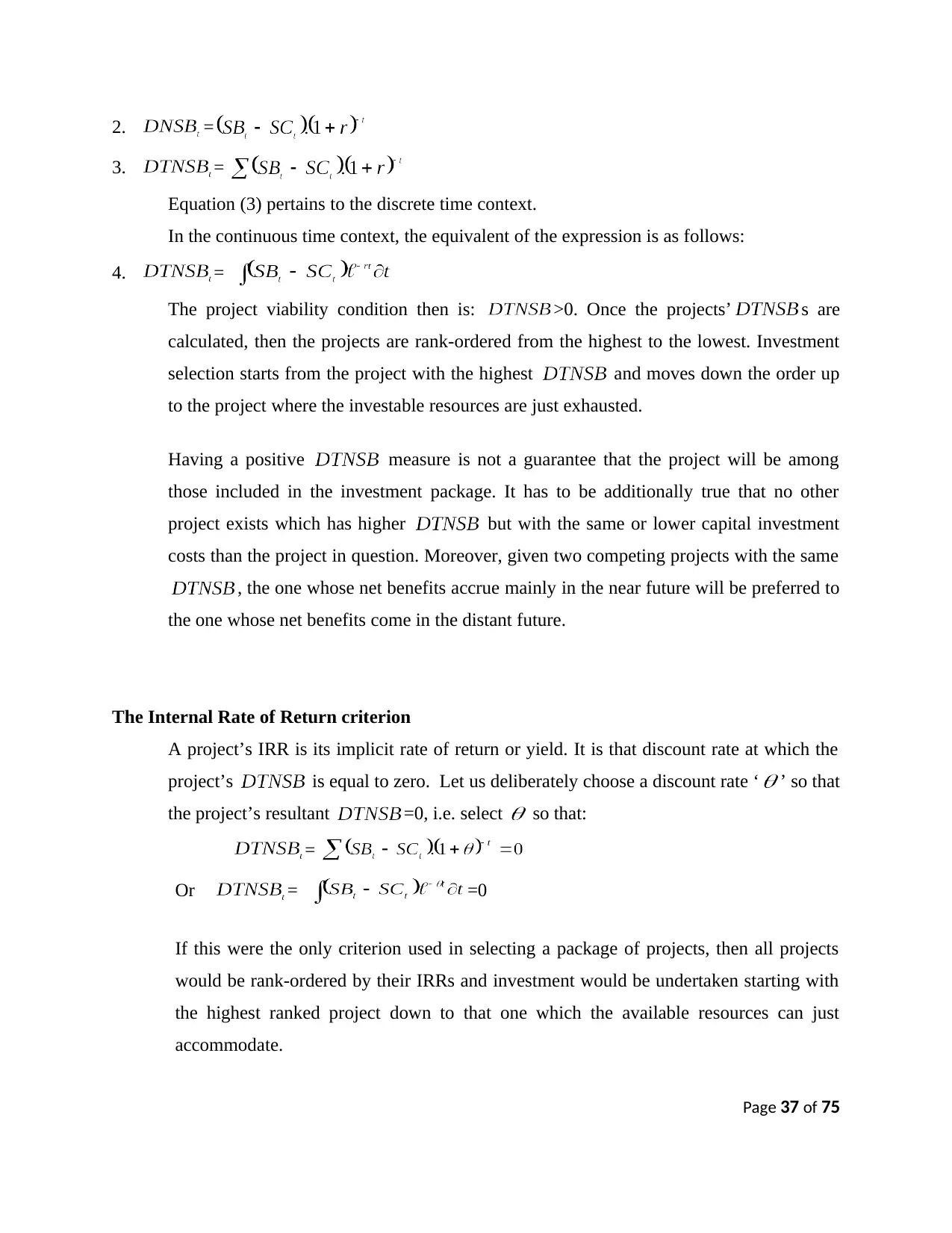
2. =
3. =
Equation (3) pertains to the discrete time context.
In the continuous time context, the equivalent of the expression is as follows:
4. =
The project viability condition then is: >0. Once the projects’ s are
calculated, then the projects are rank-ordered from the highest to the lowest. Investment
selection starts from the project with the highest and moves down the order up
to the project where the investable resources are just exhausted.
Having a positive measure is not a guarantee that the project will be among
those included in the investment package. It has to be additionally true that no other
project exists which has higher but with the same or lower capital investment
costs than the project in question. Moreover, given two competing projects with the same
, the one whose net benefits accrue mainly in the near future will be preferred to
the one whose net benefits come in the distant future.
The Internal Rate of Return criterion
A project’s IRR is its implicit rate of return or yield. It is that discount rate at which the
project’s is equal to zero. Let us deliberately choose a discount rate ‘ ’ so that
the project’s resultant =0, i.e. select so that:
=
Or = =0
If this were the only criterion used in selecting a package of projects, then all projects
would be rank-ordered by their IRRs and investment would be undertaken starting with
the highest ranked project down to that one which the available resources can just
accommodate.
Page 37 of 75
3. =
Equation (3) pertains to the discrete time context.
In the continuous time context, the equivalent of the expression is as follows:
4. =
The project viability condition then is: >0. Once the projects’ s are
calculated, then the projects are rank-ordered from the highest to the lowest. Investment
selection starts from the project with the highest and moves down the order up
to the project where the investable resources are just exhausted.
Having a positive measure is not a guarantee that the project will be among
those included in the investment package. It has to be additionally true that no other
project exists which has higher but with the same or lower capital investment
costs than the project in question. Moreover, given two competing projects with the same
, the one whose net benefits accrue mainly in the near future will be preferred to
the one whose net benefits come in the distant future.
The Internal Rate of Return criterion
A project’s IRR is its implicit rate of return or yield. It is that discount rate at which the
project’s is equal to zero. Let us deliberately choose a discount rate ‘ ’ so that
the project’s resultant =0, i.e. select so that:
=
Or = =0
If this were the only criterion used in selecting a package of projects, then all projects
would be rank-ordered by their IRRs and investment would be undertaken starting with
the highest ranked project down to that one which the available resources can just
accommodate.
Page 37 of 75
Paraphrase This Document
Need a fresh take? Get an instant paraphrase of this document with our AI Paraphraser
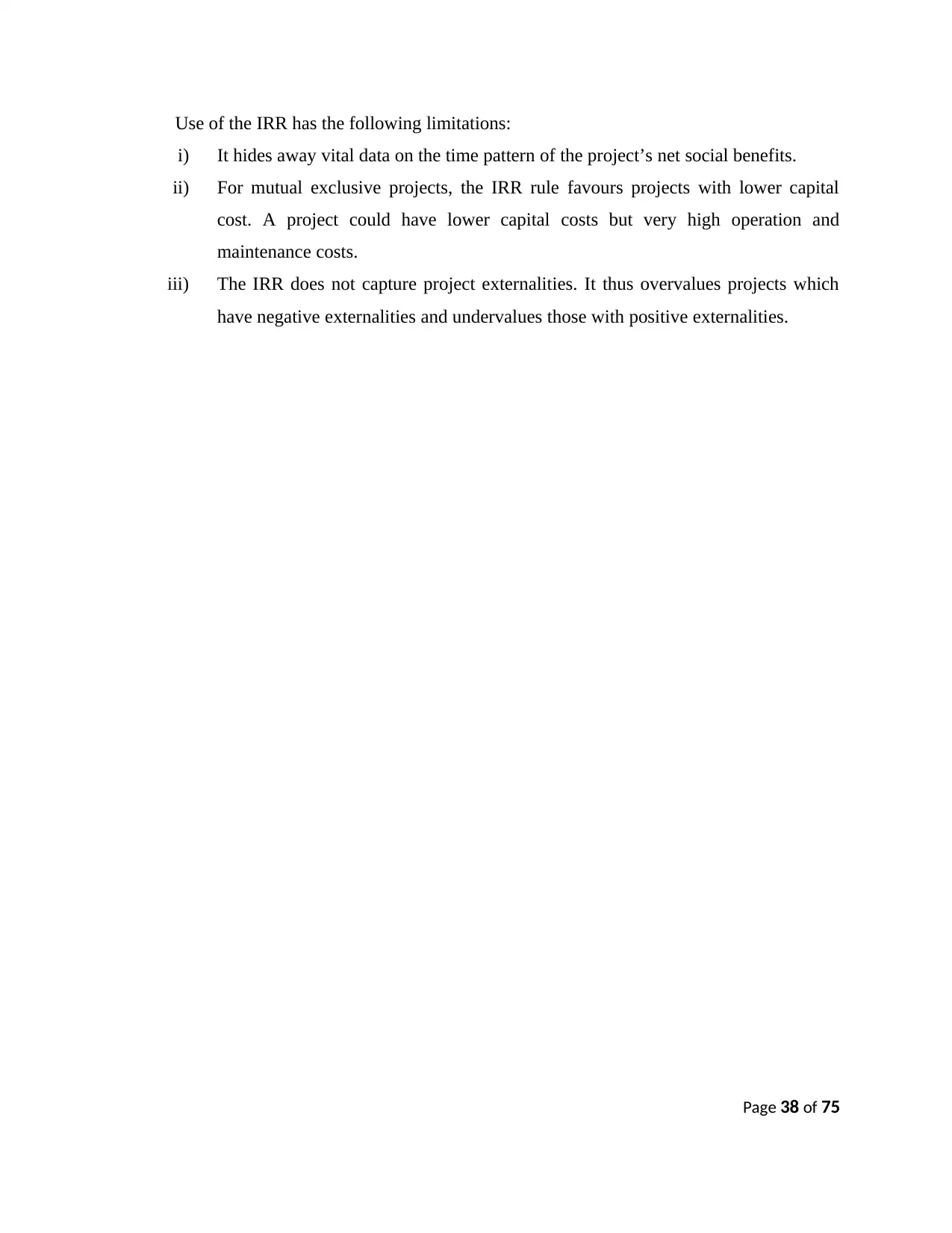
Use of the IRR has the following limitations:
i) It hides away vital data on the time pattern of the project’s net social benefits.
ii) For mutual exclusive projects, the IRR rule favours projects with lower capital
cost. A project could have lower capital costs but very high operation and
maintenance costs.
iii) The IRR does not capture project externalities. It thus overvalues projects which
have negative externalities and undervalues those with positive externalities.
Page 38 of 75
i) It hides away vital data on the time pattern of the project’s net social benefits.
ii) For mutual exclusive projects, the IRR rule favours projects with lower capital
cost. A project could have lower capital costs but very high operation and
maintenance costs.
iii) The IRR does not capture project externalities. It thus overvalues projects which
have negative externalities and undervalues those with positive externalities.
Page 38 of 75
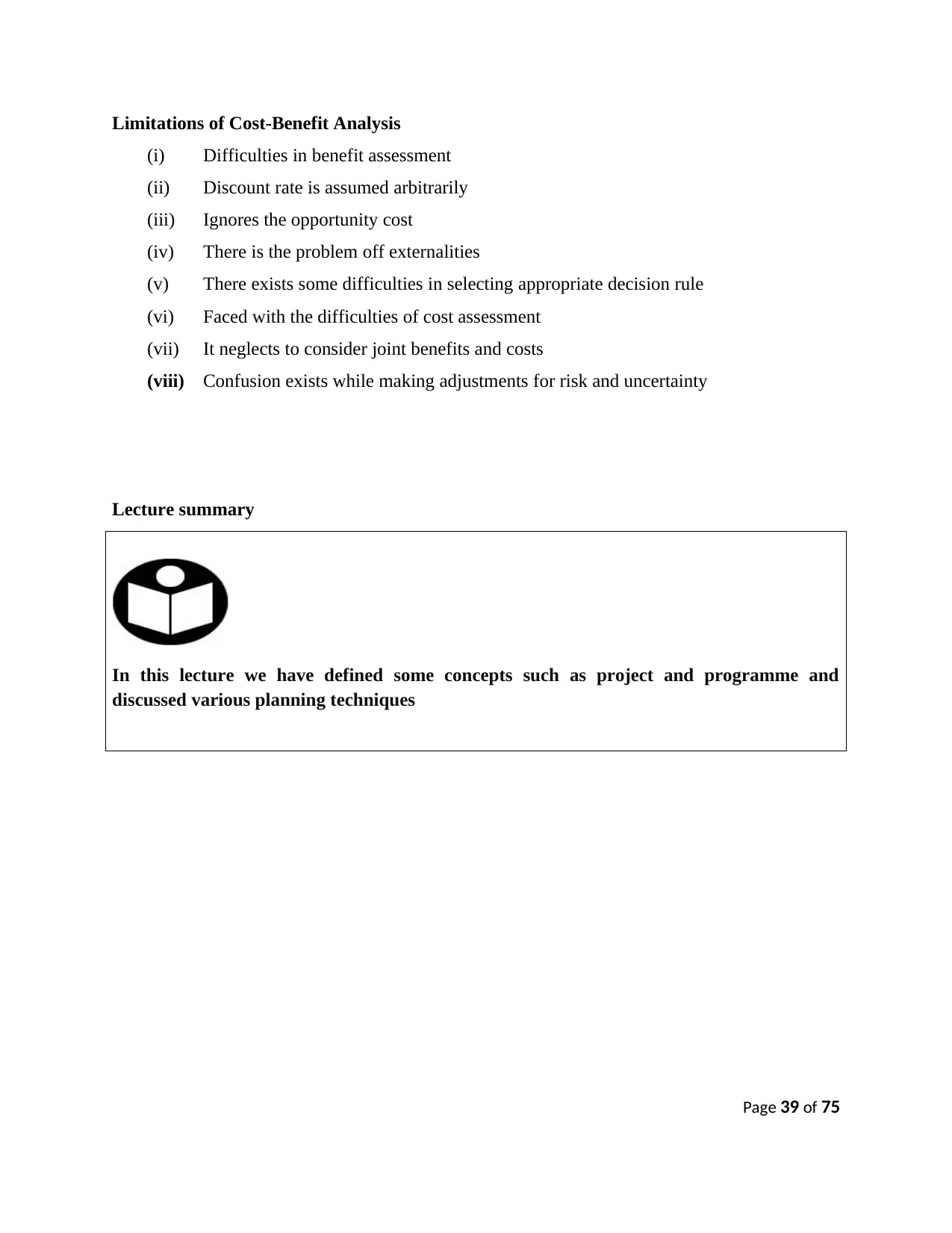
Limitations of Cost-Benefit Analysis
(i) Difficulties in benefit assessment
(ii) Discount rate is assumed arbitrarily
(iii) Ignores the opportunity cost
(iv) There is the problem off externalities
(v) There exists some difficulties in selecting appropriate decision rule
(vi) Faced with the difficulties of cost assessment
(vii) It neglects to consider joint benefits and costs
(viii) Confusion exists while making adjustments for risk and uncertainty
Lecture summary
In this lecture we have defined some concepts such as project and programme and
discussed various planning techniques
Page 39 of 75
(i) Difficulties in benefit assessment
(ii) Discount rate is assumed arbitrarily
(iii) Ignores the opportunity cost
(iv) There is the problem off externalities
(v) There exists some difficulties in selecting appropriate decision rule
(vi) Faced with the difficulties of cost assessment
(vii) It neglects to consider joint benefits and costs
(viii) Confusion exists while making adjustments for risk and uncertainty
Lecture summary
In this lecture we have defined some concepts such as project and programme and
discussed various planning techniques
Page 39 of 75

Work to do
An economy has three sectors: Agriculture, Tourism and Construction.
The technology matrix (A) and the final demand matrix (F) in year 2013 were as:
A = F =
i) Find the output levels in the three sectors that are required to satisfy the input and
final demand
ii) Find the proportion of primary inputs required in each of the sectors
iii) If the final demand in year 2013 are expected to change by the following
ΔF =
Calculate the change in sectoral output in the three sectors so as to satisfy the
change in demand
Page 40 of 75
An economy has three sectors: Agriculture, Tourism and Construction.
The technology matrix (A) and the final demand matrix (F) in year 2013 were as:
A = F =
i) Find the output levels in the three sectors that are required to satisfy the input and
final demand
ii) Find the proportion of primary inputs required in each of the sectors
iii) If the final demand in year 2013 are expected to change by the following
ΔF =
Calculate the change in sectoral output in the three sectors so as to satisfy the
change in demand
Page 40 of 75
Secure Best Marks with AI Grader
Need help grading? Try our AI Grader for instant feedback on your assignments.
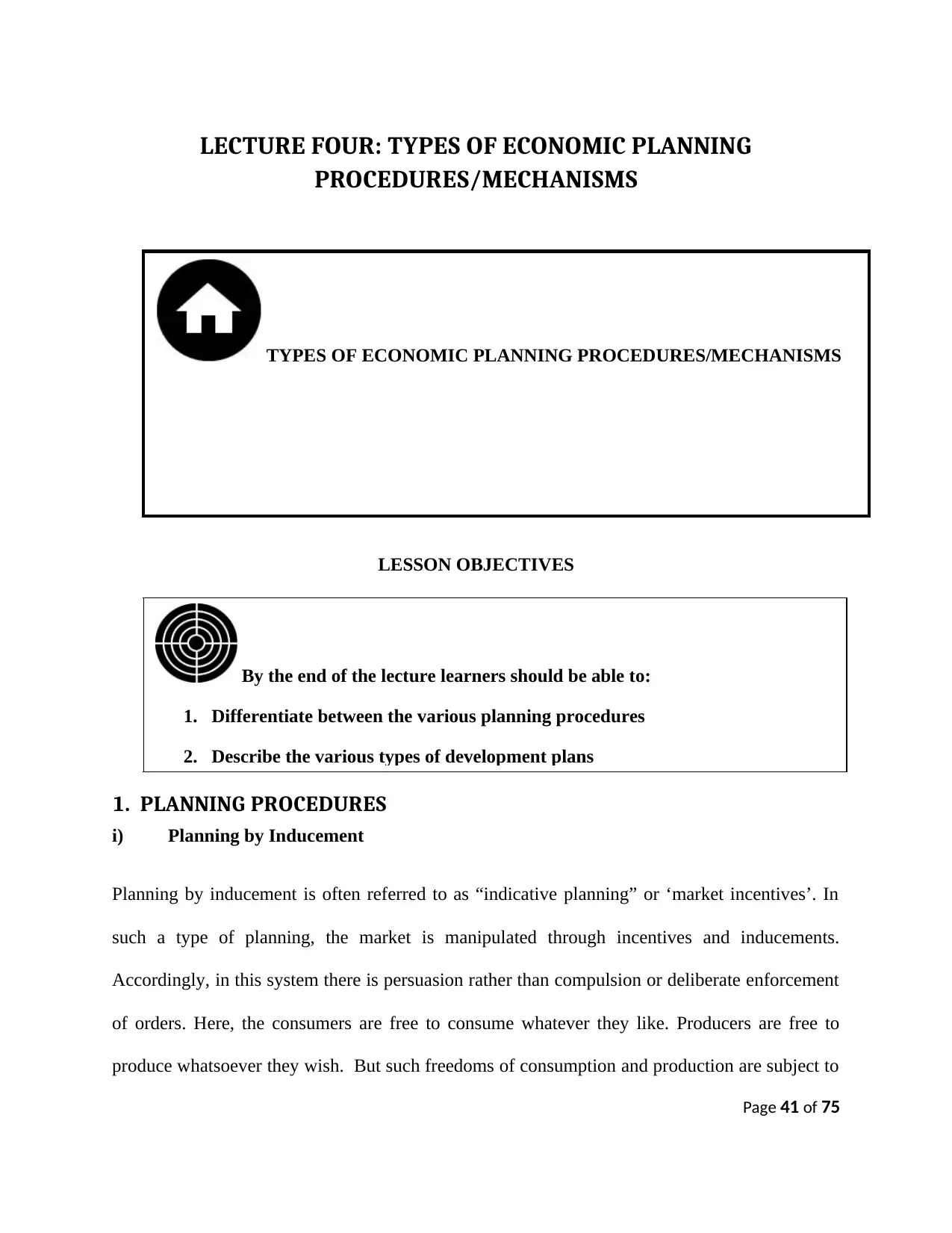
LECTURE FOUR: TYPES OF ECONOMIC PLANNING
PROCEDURES/MECHANISMS
LESSON OBJECTIVES
1. PLANNING PROCEDURES
i) Planning by Inducement
Planning by inducement is often referred to as “indicative planning” or ‘market incentives’. In
such a type of planning, the market is manipulated through incentives and inducements.
Accordingly, in this system there is persuasion rather than compulsion or deliberate enforcement
of orders. Here, the consumers are free to consume whatever they like. Producers are free to
produce whatsoever they wish. But such freedoms of consumption and production are subject to
Page 41 of 75
TYPES OF ECONOMIC PLANNING PROCEDURES/MECHANISMS
By the end of the lecture learners should be able to:
1. Differentiate between the various planning procedures
2. Describe the various types of development plans
PROCEDURES/MECHANISMS
LESSON OBJECTIVES
1. PLANNING PROCEDURES
i) Planning by Inducement
Planning by inducement is often referred to as “indicative planning” or ‘market incentives’. In
such a type of planning, the market is manipulated through incentives and inducements.
Accordingly, in this system there is persuasion rather than compulsion or deliberate enforcement
of orders. Here, the consumers are free to consume whatever they like. Producers are free to
produce whatsoever they wish. But such freedoms of consumption and production are subject to
Page 41 of 75
TYPES OF ECONOMIC PLANNING PROCEDURES/MECHANISMS
By the end of the lecture learners should be able to:
1. Differentiate between the various planning procedures
2. Describe the various types of development plans

certain controls and regulations. The consumers, producers and other factors of production are
induced with the help of various fiscal and monetary devices. For example, if the planning
authority wishes to boost the production of maize in Kenya it will provide subsidies, tax holidays
and loans to the firms involved in production of maize. To encourage savings and investment and
discourage consumption, a suitable package of fiscal and monetary policies can be introduced in
the market. Therefore, the desirable results can be attained with the help of incentives and
without the imposition of orders and instructions. Moreover, in such planning there is less
sacrifice and less of economic and non-economic liberty.
Indicative or planning by inducement has three components or approaches:
a) Forecasting Approach
Under forecasting approach, the individuals are provided with the information, through
making certain forecasts. Such forecasting serves as a guide to their decision making. The
forecasting not only indicates about the feasible future, but they also specify a desirable
future in terms of growth rate of the economy.
b) Policy Approach
The second component of the indicative planning is concerned with policy approach.
Through policy approach, the inconsistent policies of Government departments are
coordinated within a coherent model framework keeping in view the set objectives.
Moreover, once the policies are coordinated, they will provide guidelines to the people,
consumers, and producers.
Page 42 of 75
induced with the help of various fiscal and monetary devices. For example, if the planning
authority wishes to boost the production of maize in Kenya it will provide subsidies, tax holidays
and loans to the firms involved in production of maize. To encourage savings and investment and
discourage consumption, a suitable package of fiscal and monetary policies can be introduced in
the market. Therefore, the desirable results can be attained with the help of incentives and
without the imposition of orders and instructions. Moreover, in such planning there is less
sacrifice and less of economic and non-economic liberty.
Indicative or planning by inducement has three components or approaches:
a) Forecasting Approach
Under forecasting approach, the individuals are provided with the information, through
making certain forecasts. Such forecasting serves as a guide to their decision making. The
forecasting not only indicates about the feasible future, but they also specify a desirable
future in terms of growth rate of the economy.
b) Policy Approach
The second component of the indicative planning is concerned with policy approach.
Through policy approach, the inconsistent policies of Government departments are
coordinated within a coherent model framework keeping in view the set objectives.
Moreover, once the policies are coordinated, they will provide guidelines to the people,
consumers, and producers.
Page 42 of 75
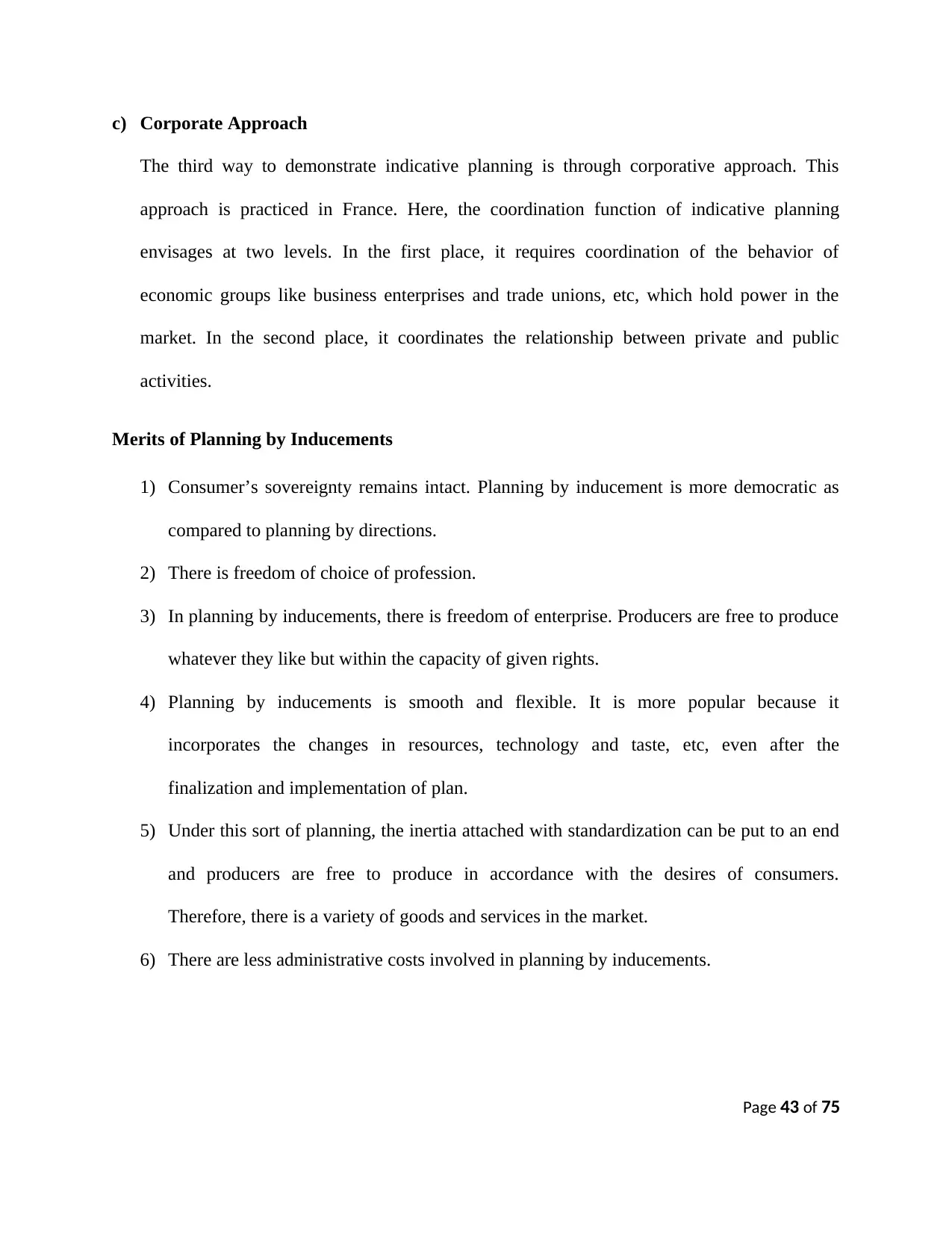
c) Corporate Approach
The third way to demonstrate indicative planning is through corporative approach. This
approach is practiced in France. Here, the coordination function of indicative planning
envisages at two levels. In the first place, it requires coordination of the behavior of
economic groups like business enterprises and trade unions, etc, which hold power in the
market. In the second place, it coordinates the relationship between private and public
activities.
Merits of Planning by Inducements
1) Consumer’s sovereignty remains intact. Planning by inducement is more democratic as
compared to planning by directions.
2) There is freedom of choice of profession.
3) In planning by inducements, there is freedom of enterprise. Producers are free to produce
whatever they like but within the capacity of given rights.
4) Planning by inducements is smooth and flexible. It is more popular because it
incorporates the changes in resources, technology and taste, etc, even after the
finalization and implementation of plan.
5) Under this sort of planning, the inertia attached with standardization can be put to an end
and producers are free to produce in accordance with the desires of consumers.
Therefore, there is a variety of goods and services in the market.
6) There are less administrative costs involved in planning by inducements.
Page 43 of 75
The third way to demonstrate indicative planning is through corporative approach. This
approach is practiced in France. Here, the coordination function of indicative planning
envisages at two levels. In the first place, it requires coordination of the behavior of
economic groups like business enterprises and trade unions, etc, which hold power in the
market. In the second place, it coordinates the relationship between private and public
activities.
Merits of Planning by Inducements
1) Consumer’s sovereignty remains intact. Planning by inducement is more democratic as
compared to planning by directions.
2) There is freedom of choice of profession.
3) In planning by inducements, there is freedom of enterprise. Producers are free to produce
whatever they like but within the capacity of given rights.
4) Planning by inducements is smooth and flexible. It is more popular because it
incorporates the changes in resources, technology and taste, etc, even after the
finalization and implementation of plan.
5) Under this sort of planning, the inertia attached with standardization can be put to an end
and producers are free to produce in accordance with the desires of consumers.
Therefore, there is a variety of goods and services in the market.
6) There are less administrative costs involved in planning by inducements.
Page 43 of 75
Paraphrase This Document
Need a fresh take? Get an instant paraphrase of this document with our AI Paraphraser

7) The problem of shortages and surpluses is solved as there is existence of automated
market system. The demand and supply is automatically adjusted and remain in balance
under market economy.
Demerits of Planning by Inducements
a) It also to achieve 100% targets of economic planning
b) Under planning by inducements, there are profit motives more than welfare of public.
Private entrepreneurs care for those products which yield high profits. Products or services
with less profit or no profit do not attract private entrepreneurs. Such products or services
include education, health, defense, security, etc.
c) The producers may find the government policies regarding economic affairs not attractive
enough to follow. There may be disputes among entrepreneurs and Government regarding
tax rate, investment policies, interest rates, etc.
d) The mechanism of market economy may cause the prices to inflate especially with reference
to under-developed countries or in the case of oligopoly where there is a shortage of certain
products like petroleum and gas
e) There may be disharmony between labour and producers, and there may be serious
industrial disputes.
ii) Planning by directions
It is also referred to as imperative planning. This type of planning is practiced in socialist
countries like China, the former USSR, Cuba, North Korea, etc. Under planning by direction,
there is one central body / authority which plans, directs and orders execution of the plan in
Page 44 of 75
market system. The demand and supply is automatically adjusted and remain in balance
under market economy.
Demerits of Planning by Inducements
a) It also to achieve 100% targets of economic planning
b) Under planning by inducements, there are profit motives more than welfare of public.
Private entrepreneurs care for those products which yield high profits. Products or services
with less profit or no profit do not attract private entrepreneurs. Such products or services
include education, health, defense, security, etc.
c) The producers may find the government policies regarding economic affairs not attractive
enough to follow. There may be disputes among entrepreneurs and Government regarding
tax rate, investment policies, interest rates, etc.
d) The mechanism of market economy may cause the prices to inflate especially with reference
to under-developed countries or in the case of oligopoly where there is a shortage of certain
products like petroleum and gas
e) There may be disharmony between labour and producers, and there may be serious
industrial disputes.
ii) Planning by directions
It is also referred to as imperative planning. This type of planning is practiced in socialist
countries like China, the former USSR, Cuba, North Korea, etc. Under planning by direction,
there is one central body / authority which plans, directs and orders execution of the plan in
Page 44 of 75
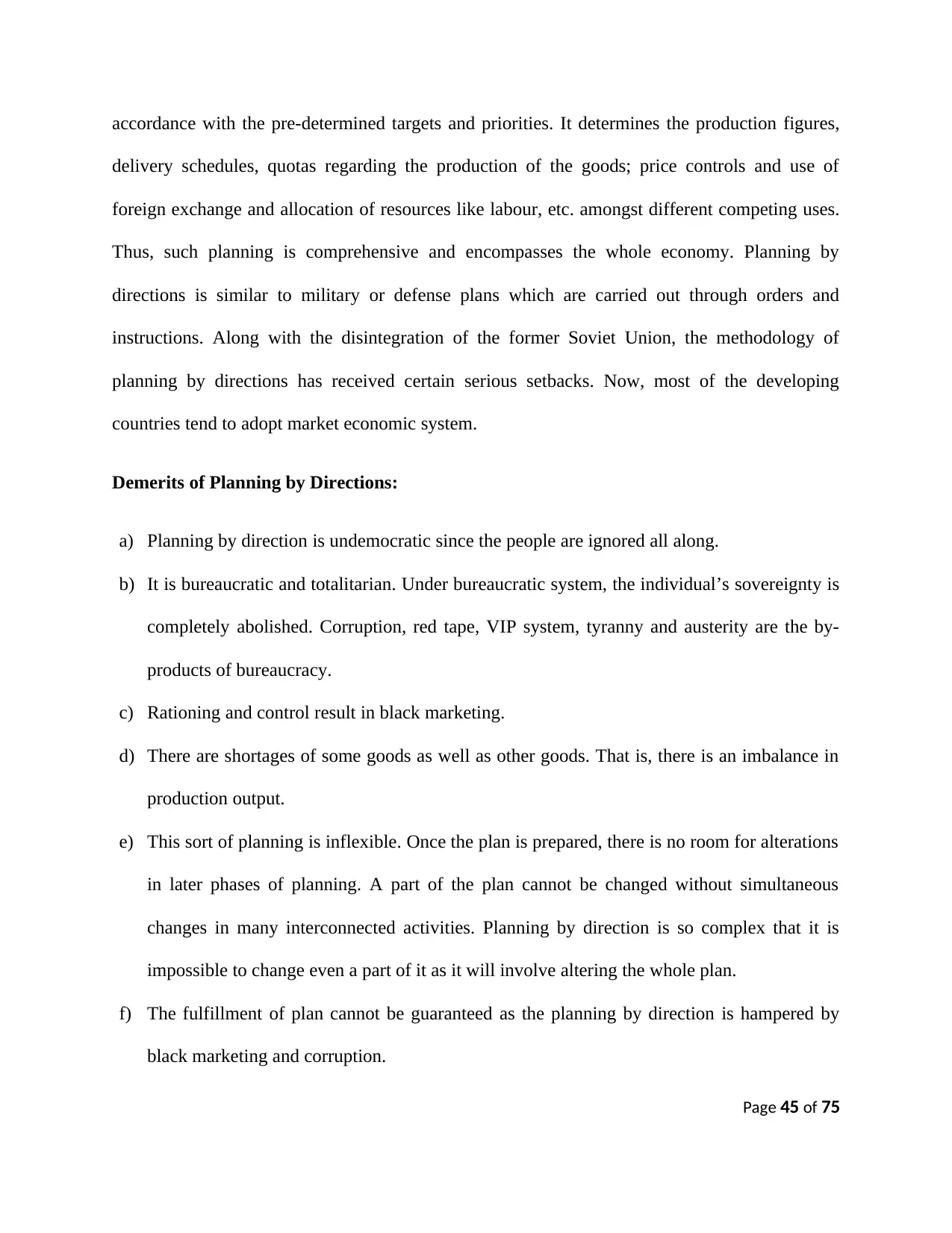
accordance with the pre-determined targets and priorities. It determines the production figures,
delivery schedules, quotas regarding the production of the goods; price controls and use of
foreign exchange and allocation of resources like labour, etc. amongst different competing uses.
Thus, such planning is comprehensive and encompasses the whole economy. Planning by
directions is similar to military or defense plans which are carried out through orders and
instructions. Along with the disintegration of the former Soviet Union, the methodology of
planning by directions has received certain serious setbacks. Now, most of the developing
countries tend to adopt market economic system.
Demerits of Planning by Directions:
a) Planning by direction is undemocratic since the people are ignored all along.
b) It is bureaucratic and totalitarian. Under bureaucratic system, the individual’s sovereignty is
completely abolished. Corruption, red tape, VIP system, tyranny and austerity are the by-
products of bureaucracy.
c) Rationing and control result in black marketing.
d) There are shortages of some goods as well as other goods. That is, there is an imbalance in
production output.
e) This sort of planning is inflexible. Once the plan is prepared, there is no room for alterations
in later phases of planning. A part of the plan cannot be changed without simultaneous
changes in many interconnected activities. Planning by direction is so complex that it is
impossible to change even a part of it as it will involve altering the whole plan.
f) The fulfillment of plan cannot be guaranteed as the planning by direction is hampered by
black marketing and corruption.
Page 45 of 75
delivery schedules, quotas regarding the production of the goods; price controls and use of
foreign exchange and allocation of resources like labour, etc. amongst different competing uses.
Thus, such planning is comprehensive and encompasses the whole economy. Planning by
directions is similar to military or defense plans which are carried out through orders and
instructions. Along with the disintegration of the former Soviet Union, the methodology of
planning by directions has received certain serious setbacks. Now, most of the developing
countries tend to adopt market economic system.
Demerits of Planning by Directions:
a) Planning by direction is undemocratic since the people are ignored all along.
b) It is bureaucratic and totalitarian. Under bureaucratic system, the individual’s sovereignty is
completely abolished. Corruption, red tape, VIP system, tyranny and austerity are the by-
products of bureaucracy.
c) Rationing and control result in black marketing.
d) There are shortages of some goods as well as other goods. That is, there is an imbalance in
production output.
e) This sort of planning is inflexible. Once the plan is prepared, there is no room for alterations
in later phases of planning. A part of the plan cannot be changed without simultaneous
changes in many interconnected activities. Planning by direction is so complex that it is
impossible to change even a part of it as it will involve altering the whole plan.
f) The fulfillment of plan cannot be guaranteed as the planning by direction is hampered by
black marketing and corruption.
Page 45 of 75
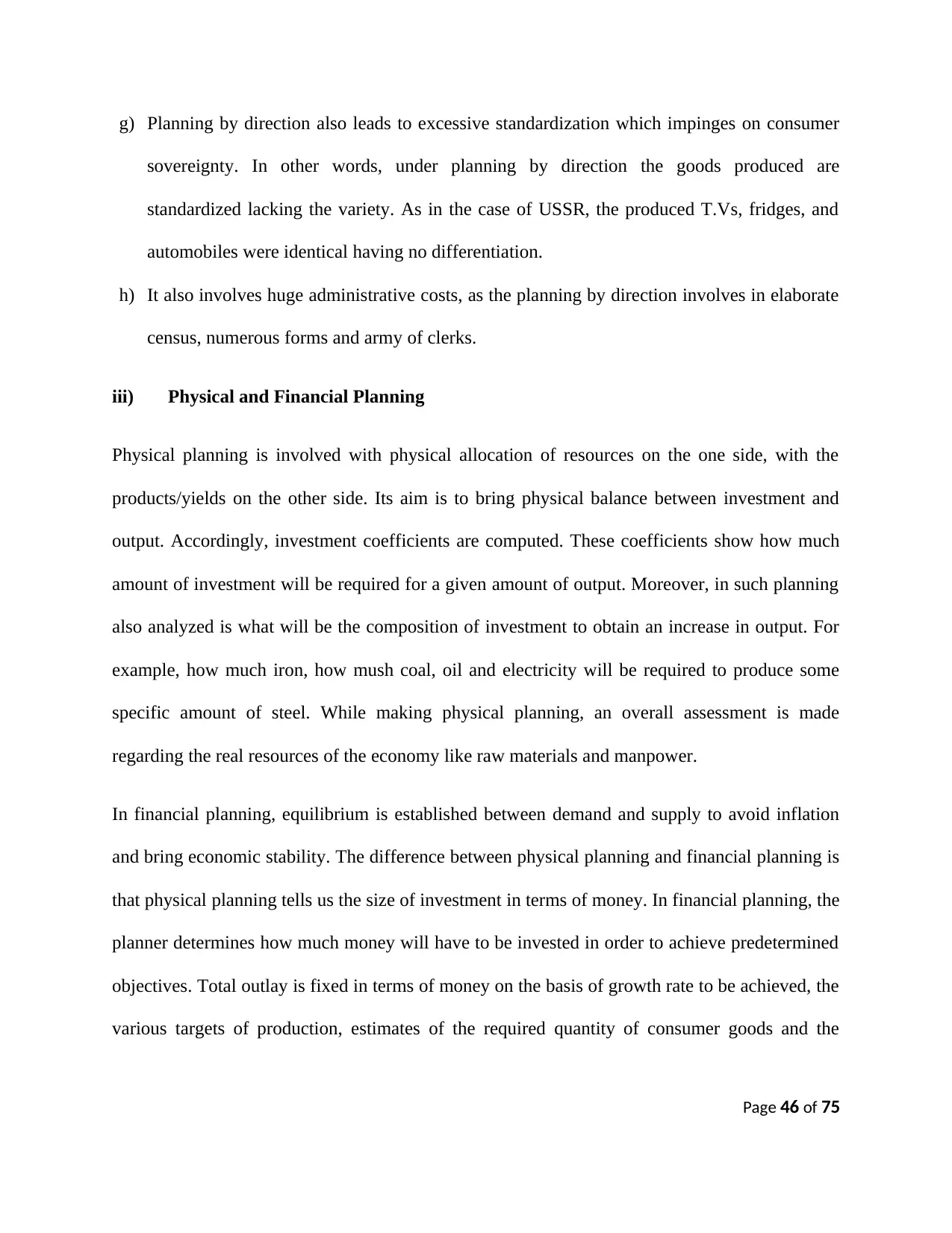
g) Planning by direction also leads to excessive standardization which impinges on consumer
sovereignty. In other words, under planning by direction the goods produced are
standardized lacking the variety. As in the case of USSR, the produced T.Vs, fridges, and
automobiles were identical having no differentiation.
h) It also involves huge administrative costs, as the planning by direction involves in elaborate
census, numerous forms and army of clerks.
iii) Physical and Financial Planning
Physical planning is involved with physical allocation of resources on the one side, with the
products/yields on the other side. Its aim is to bring physical balance between investment and
output. Accordingly, investment coefficients are computed. These coefficients show how much
amount of investment will be required for a given amount of output. Moreover, in such planning
also analyzed is what will be the composition of investment to obtain an increase in output. For
example, how much iron, how mush coal, oil and electricity will be required to produce some
specific amount of steel. While making physical planning, an overall assessment is made
regarding the real resources of the economy like raw materials and manpower.
In financial planning, equilibrium is established between demand and supply to avoid inflation
and bring economic stability. The difference between physical planning and financial planning is
that physical planning tells us the size of investment in terms of money. In financial planning, the
planner determines how much money will have to be invested in order to achieve predetermined
objectives. Total outlay is fixed in terms of money on the basis of growth rate to be achieved, the
various targets of production, estimates of the required quantity of consumer goods and the
Page 46 of 75
sovereignty. In other words, under planning by direction the goods produced are
standardized lacking the variety. As in the case of USSR, the produced T.Vs, fridges, and
automobiles were identical having no differentiation.
h) It also involves huge administrative costs, as the planning by direction involves in elaborate
census, numerous forms and army of clerks.
iii) Physical and Financial Planning
Physical planning is involved with physical allocation of resources on the one side, with the
products/yields on the other side. Its aim is to bring physical balance between investment and
output. Accordingly, investment coefficients are computed. These coefficients show how much
amount of investment will be required for a given amount of output. Moreover, in such planning
also analyzed is what will be the composition of investment to obtain an increase in output. For
example, how much iron, how mush coal, oil and electricity will be required to produce some
specific amount of steel. While making physical planning, an overall assessment is made
regarding the real resources of the economy like raw materials and manpower.
In financial planning, equilibrium is established between demand and supply to avoid inflation
and bring economic stability. The difference between physical planning and financial planning is
that physical planning tells us the size of investment in terms of money. In financial planning, the
planner determines how much money will have to be invested in order to achieve predetermined
objectives. Total outlay is fixed in terms of money on the basis of growth rate to be achieved, the
various targets of production, estimates of the required quantity of consumer goods and the
Page 46 of 75
Secure Best Marks with AI Grader
Need help grading? Try our AI Grader for instant feedback on your assignments.

various social services, expenditure on the necessary infrastructure, etc. as well as revenue from
taxations, borrowings and savings.
iv) Centralized Planning and Decentralized Planning.
Under centralized planning, all the economic decisions are undertaken by the central authority or
the Government. It is the Government which formulates economic plans, determines objectives,
and sets target and priorities. Every member has simply to carry out the instructions without
questioning about its viability. There are more chances of failure as the individuals are not
allowed to carry out the plans in accordance to their needs and preferences. It is the Government
which takes responsibility of the successes or failure of the plan. It is the Government which
takes all the decisions of consumption, production, wages and prices. What amount of
investment is to be made? What should the price? What should be the output? How the products
are to be distributed? How much amount of the loans is to be granted? What should be the rate of
interest, etc. Centralized planning is mostly executed in socialist or communist countries.
Decentralized planning is connected with capitalistic economies. The decentralized planning is
implemented through market mechanism. Decentralized planning empowers the individuals or
small groups to carry out their plans of achievement of a common goal. Under decentralized
planning, the operation is from bottom to top. The planning authority formulates the plan by
having made consultation with different administrative units of the economy. The plans
regarding different industries are designed by the representatives of these industries. In such a
type of planning, the planning authority issues the instructions to central and local bodies
regarding incentives given over to private sectors.
Page 47 of 75
taxations, borrowings and savings.
iv) Centralized Planning and Decentralized Planning.
Under centralized planning, all the economic decisions are undertaken by the central authority or
the Government. It is the Government which formulates economic plans, determines objectives,
and sets target and priorities. Every member has simply to carry out the instructions without
questioning about its viability. There are more chances of failure as the individuals are not
allowed to carry out the plans in accordance to their needs and preferences. It is the Government
which takes responsibility of the successes or failure of the plan. It is the Government which
takes all the decisions of consumption, production, wages and prices. What amount of
investment is to be made? What should the price? What should be the output? How the products
are to be distributed? How much amount of the loans is to be granted? What should be the rate of
interest, etc. Centralized planning is mostly executed in socialist or communist countries.
Decentralized planning is connected with capitalistic economies. The decentralized planning is
implemented through market mechanism. Decentralized planning empowers the individuals or
small groups to carry out their plans of achievement of a common goal. Under decentralized
planning, the operation is from bottom to top. The planning authority formulates the plan by
having made consultation with different administrative units of the economy. The plans
regarding different industries are designed by the representatives of these industries. In such a
type of planning, the planning authority issues the instructions to central and local bodies
regarding incentives given over to private sectors.
Page 47 of 75
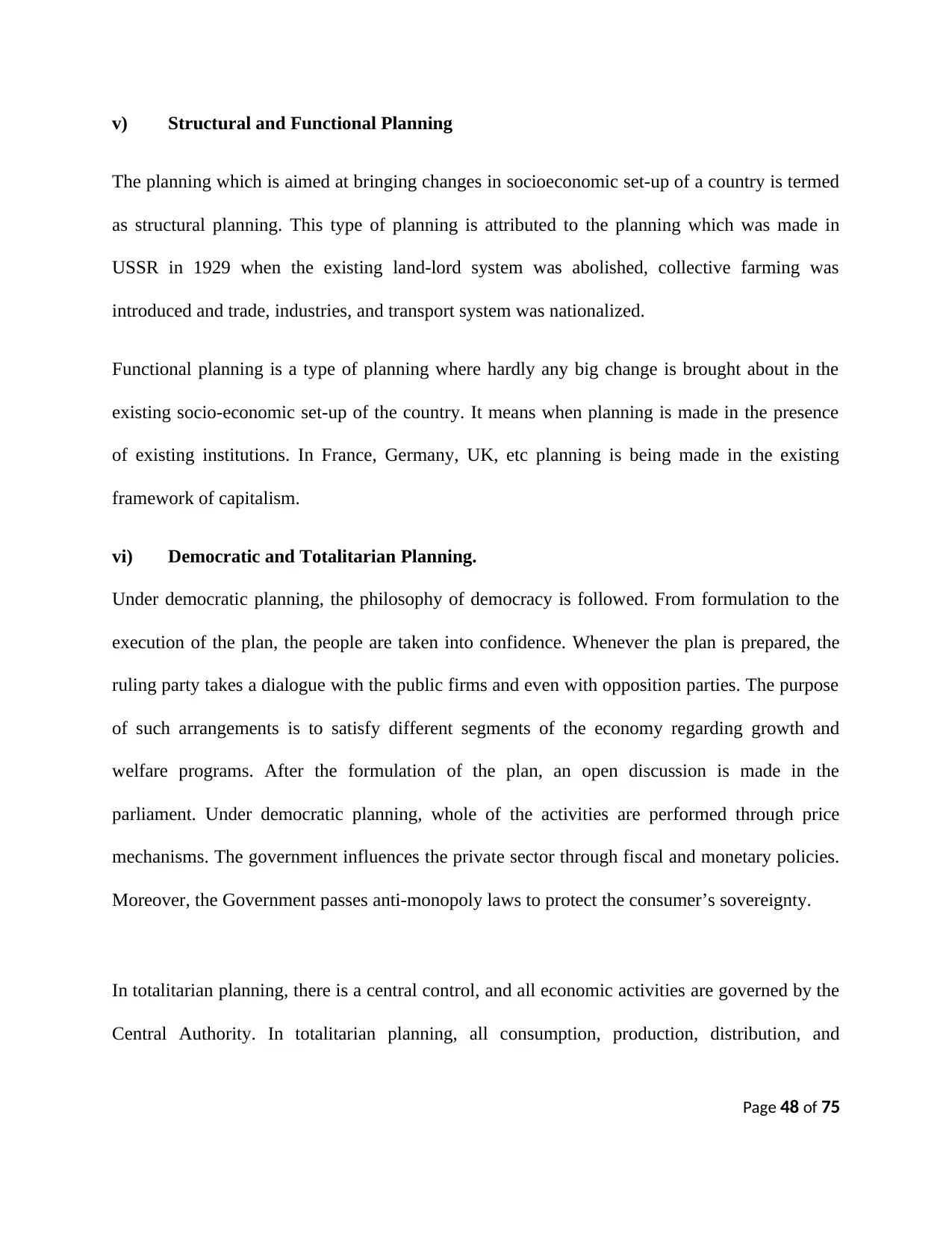
v) Structural and Functional Planning
The planning which is aimed at bringing changes in socioeconomic set-up of a country is termed
as structural planning. This type of planning is attributed to the planning which was made in
USSR in 1929 when the existing land-lord system was abolished, collective farming was
introduced and trade, industries, and transport system was nationalized.
Functional planning is a type of planning where hardly any big change is brought about in the
existing socio-economic set-up of the country. It means when planning is made in the presence
of existing institutions. In France, Germany, UK, etc planning is being made in the existing
framework of capitalism.
vi) Democratic and Totalitarian Planning.
Under democratic planning, the philosophy of democracy is followed. From formulation to the
execution of the plan, the people are taken into confidence. Whenever the plan is prepared, the
ruling party takes a dialogue with the public firms and even with opposition parties. The purpose
of such arrangements is to satisfy different segments of the economy regarding growth and
welfare programs. After the formulation of the plan, an open discussion is made in the
parliament. Under democratic planning, whole of the activities are performed through price
mechanisms. The government influences the private sector through fiscal and monetary policies.
Moreover, the Government passes anti-monopoly laws to protect the consumer’s sovereignty.
In totalitarian planning, there is a central control, and all economic activities are governed by the
Central Authority. In totalitarian planning, all consumption, production, distribution, and
Page 48 of 75
The planning which is aimed at bringing changes in socioeconomic set-up of a country is termed
as structural planning. This type of planning is attributed to the planning which was made in
USSR in 1929 when the existing land-lord system was abolished, collective farming was
introduced and trade, industries, and transport system was nationalized.
Functional planning is a type of planning where hardly any big change is brought about in the
existing socio-economic set-up of the country. It means when planning is made in the presence
of existing institutions. In France, Germany, UK, etc planning is being made in the existing
framework of capitalism.
vi) Democratic and Totalitarian Planning.
Under democratic planning, the philosophy of democracy is followed. From formulation to the
execution of the plan, the people are taken into confidence. Whenever the plan is prepared, the
ruling party takes a dialogue with the public firms and even with opposition parties. The purpose
of such arrangements is to satisfy different segments of the economy regarding growth and
welfare programs. After the formulation of the plan, an open discussion is made in the
parliament. Under democratic planning, whole of the activities are performed through price
mechanisms. The government influences the private sector through fiscal and monetary policies.
Moreover, the Government passes anti-monopoly laws to protect the consumer’s sovereignty.
In totalitarian planning, there is a central control, and all economic activities are governed by the
Central Authority. In totalitarian planning, all consumption, production, distribution, and
Page 48 of 75

exchange like activities are controlled by the Central Planning authority. Totalitarian allows no
consumer sovereignty and democratic freedom.
vii) Corrective and Developmental Planning
The planning consisting of fiscal and monetary measures with the aim of removing the
imbalances of the economy is known as ‘corrective’ planning. As to control inflation, if the
government follows a very strict fiscal and monetary package ; controls aggregate demand by
checking consumption, investment and government expenditure - this will be the case of
corrective planning. On the other hand, the planning which is aimed at developing the whole
economy is known as development planning. Development planning involves the application of
rational system of choices among feasible courses of investment and other development actions.
viii) Capitalist and Socialist Planning
A capitalist economy is also known as ‘a free-enterprise economy’. Under capitalism, there
was no authority governing the planning activity. All the economic activities were controlled
by the private sector. The state function was limited to tax collection and defense. There were
no public welfare measures, no developmental planning and no labour rights. But with the
capacity of time, especially after the great depression of the 1930s and development of
economic, social and political economic thoughts, the capitalist economies adopted the
modern functions like:
a) Formulating and implementing monetary, fiscal and trade policies.
b) Promulgating anti-monopoly and anti-cartel laws
c) Working for the sake of communities benefits
Page 49 of 75
consumer sovereignty and democratic freedom.
vii) Corrective and Developmental Planning
The planning consisting of fiscal and monetary measures with the aim of removing the
imbalances of the economy is known as ‘corrective’ planning. As to control inflation, if the
government follows a very strict fiscal and monetary package ; controls aggregate demand by
checking consumption, investment and government expenditure - this will be the case of
corrective planning. On the other hand, the planning which is aimed at developing the whole
economy is known as development planning. Development planning involves the application of
rational system of choices among feasible courses of investment and other development actions.
viii) Capitalist and Socialist Planning
A capitalist economy is also known as ‘a free-enterprise economy’. Under capitalism, there
was no authority governing the planning activity. All the economic activities were controlled
by the private sector. The state function was limited to tax collection and defense. There were
no public welfare measures, no developmental planning and no labour rights. But with the
capacity of time, especially after the great depression of the 1930s and development of
economic, social and political economic thoughts, the capitalist economies adopted the
modern functions like:
a) Formulating and implementing monetary, fiscal and trade policies.
b) Promulgating anti-monopoly and anti-cartel laws
c) Working for the sake of communities benefits
Page 49 of 75
Paraphrase This Document
Need a fresh take? Get an instant paraphrase of this document with our AI Paraphraser

d) Formulating and implementing development plans
e) Providing basic facilities of health, education, transportation, communication and
recreation, etc.
In socialism, the central planning board formulates the plan which covers the whole economy.
The Central planning board has unlimited powers regarding allocation of resources and
production of goods and services. The central planning authority determines the goals and
priorities regarding distribution of national income, employment, economic needs, capital
accumulation and economic growth. Under socialism all factories, resources, financial
institutions, shops, stores, ware houses, foreign and domestic trades, means of communication
and transportation are under government control.
ix) Planning Under Mixed Economy
Most economists suggest the operation of mixed economy because both extreme capitalistic and
socialistic system are not suitable. Capitalistic or free enterprise economy are characterized by
lots of problems including misallocation of resources, market imperfections, monopolies,
oligopolies, labour exploitation, widening gap between haves and have not, and consumer
exploitation. On the other hand, socialistic form of economy may create the problems like State’s
monopoly and supremacy, bureaucratic hold, corruption, red tape, VIP system, loss of
consumer’s sovereignty, standardization of products, poor quality of products, less foreign trade,
etc. While in the case of mixed economy, consumer’s sovereignty, private ownership, and
operation of price mechanism are ensured. The public sector also works parallel to private sector.
The public sector in a mixed economy consists of those projects which require heavy funds like
railways, air transportation, roads, bridges, flyovers, underpasses, power generation, irrigation,
Page 50 of 75
e) Providing basic facilities of health, education, transportation, communication and
recreation, etc.
In socialism, the central planning board formulates the plan which covers the whole economy.
The Central planning board has unlimited powers regarding allocation of resources and
production of goods and services. The central planning authority determines the goals and
priorities regarding distribution of national income, employment, economic needs, capital
accumulation and economic growth. Under socialism all factories, resources, financial
institutions, shops, stores, ware houses, foreign and domestic trades, means of communication
and transportation are under government control.
ix) Planning Under Mixed Economy
Most economists suggest the operation of mixed economy because both extreme capitalistic and
socialistic system are not suitable. Capitalistic or free enterprise economy are characterized by
lots of problems including misallocation of resources, market imperfections, monopolies,
oligopolies, labour exploitation, widening gap between haves and have not, and consumer
exploitation. On the other hand, socialistic form of economy may create the problems like State’s
monopoly and supremacy, bureaucratic hold, corruption, red tape, VIP system, loss of
consumer’s sovereignty, standardization of products, poor quality of products, less foreign trade,
etc. While in the case of mixed economy, consumer’s sovereignty, private ownership, and
operation of price mechanism are ensured. The public sector also works parallel to private sector.
The public sector in a mixed economy consists of those projects which require heavy funds like
railways, air transportation, roads, bridges, flyovers, underpasses, power generation, irrigation,
Page 50 of 75
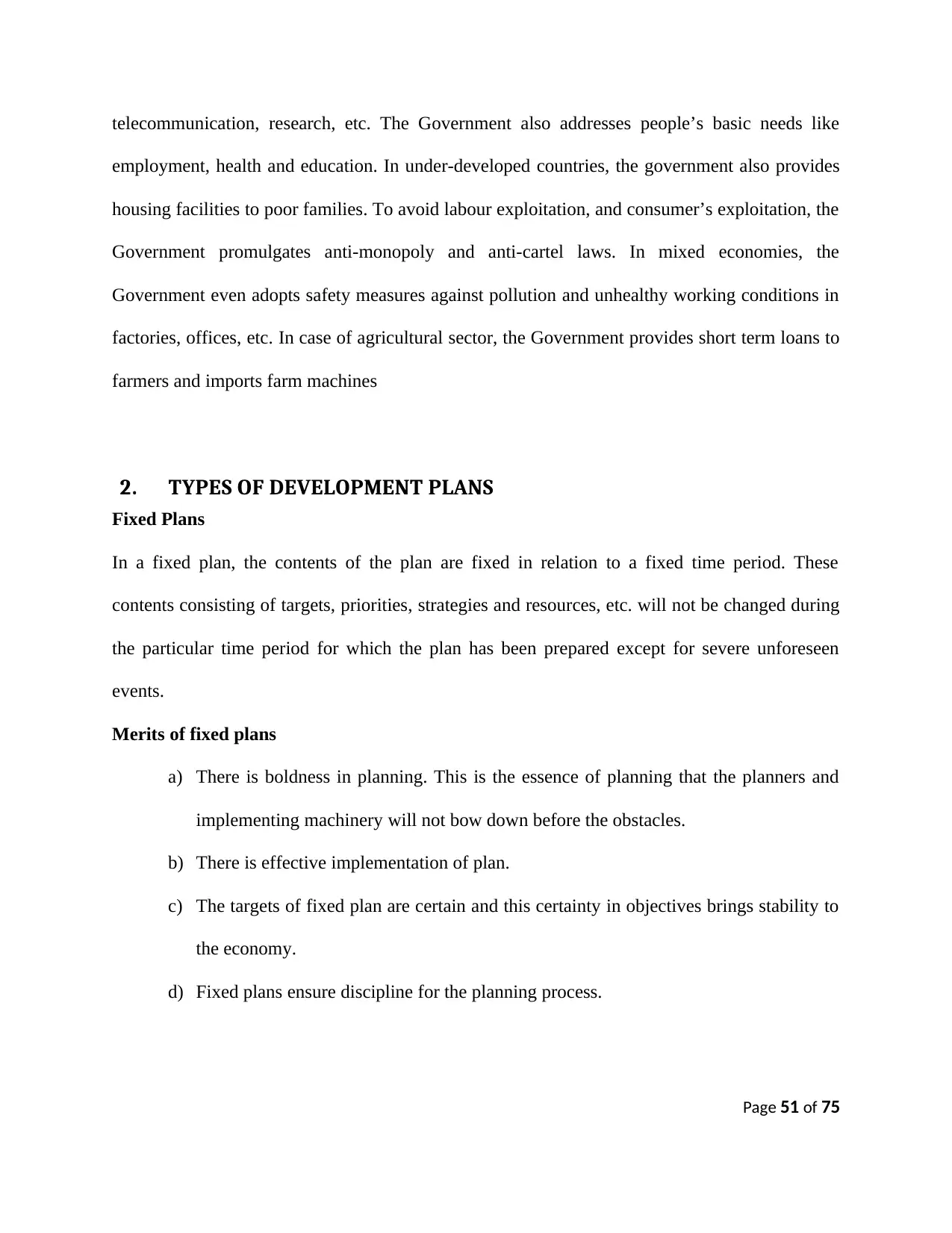
telecommunication, research, etc. The Government also addresses people’s basic needs like
employment, health and education. In under-developed countries, the government also provides
housing facilities to poor families. To avoid labour exploitation, and consumer’s exploitation, the
Government promulgates anti-monopoly and anti-cartel laws. In mixed economies, the
Government even adopts safety measures against pollution and unhealthy working conditions in
factories, offices, etc. In case of agricultural sector, the Government provides short term loans to
farmers and imports farm machines
2. TYPES OF DEVELOPMENT PLANS
Fixed Plans
In a fixed plan, the contents of the plan are fixed in relation to a fixed time period. These
contents consisting of targets, priorities, strategies and resources, etc. will not be changed during
the particular time period for which the plan has been prepared except for severe unforeseen
events.
Merits of fixed plans
a) There is boldness in planning. This is the essence of planning that the planners and
implementing machinery will not bow down before the obstacles.
b) There is effective implementation of plan.
c) The targets of fixed plan are certain and this certainty in objectives brings stability to
the economy.
d) Fixed plans ensure discipline for the planning process.
Page 51 of 75
employment, health and education. In under-developed countries, the government also provides
housing facilities to poor families. To avoid labour exploitation, and consumer’s exploitation, the
Government promulgates anti-monopoly and anti-cartel laws. In mixed economies, the
Government even adopts safety measures against pollution and unhealthy working conditions in
factories, offices, etc. In case of agricultural sector, the Government provides short term loans to
farmers and imports farm machines
2. TYPES OF DEVELOPMENT PLANS
Fixed Plans
In a fixed plan, the contents of the plan are fixed in relation to a fixed time period. These
contents consisting of targets, priorities, strategies and resources, etc. will not be changed during
the particular time period for which the plan has been prepared except for severe unforeseen
events.
Merits of fixed plans
a) There is boldness in planning. This is the essence of planning that the planners and
implementing machinery will not bow down before the obstacles.
b) There is effective implementation of plan.
c) The targets of fixed plan are certain and this certainty in objectives brings stability to
the economy.
d) Fixed plans ensure discipline for the planning process.
Page 51 of 75
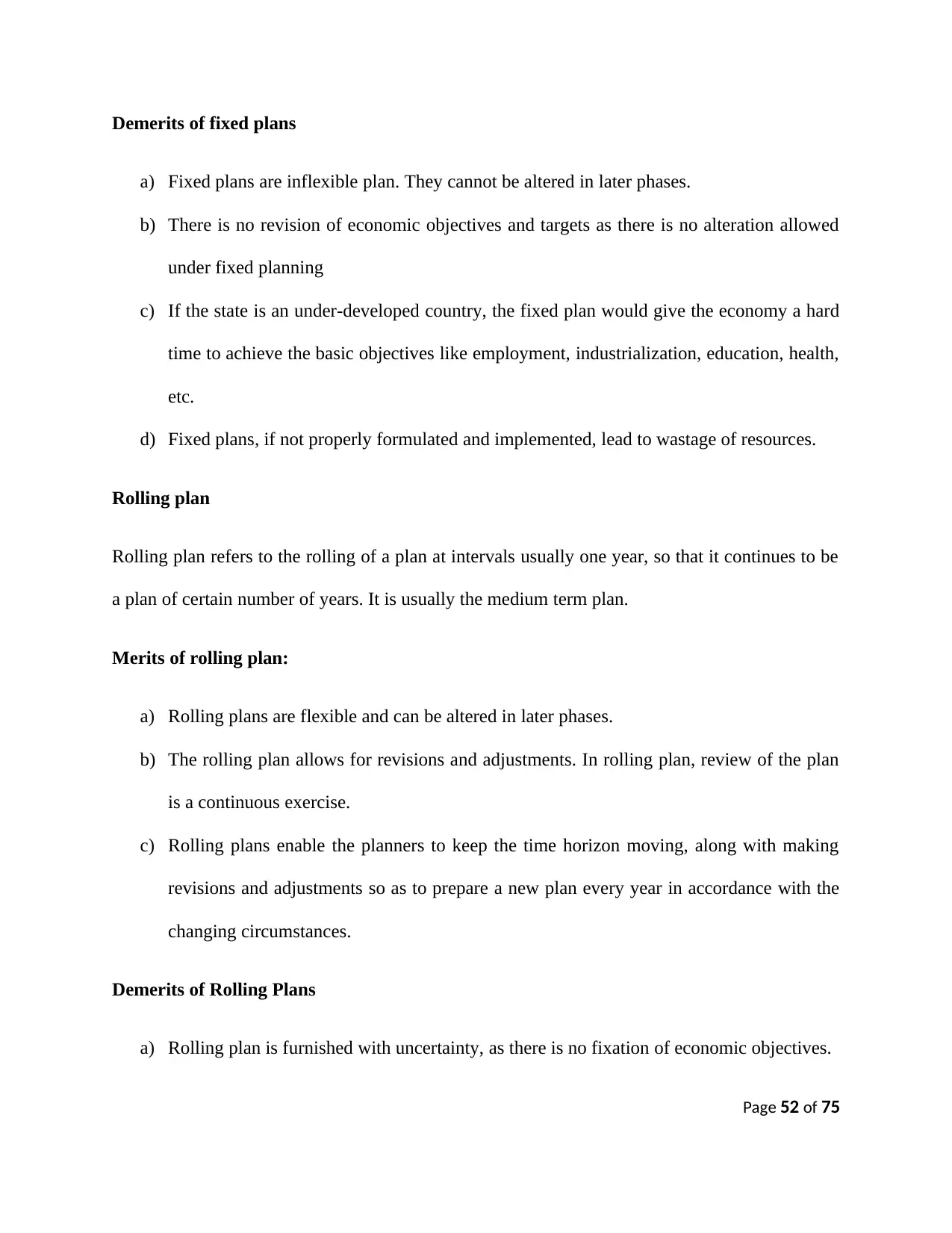
Demerits of fixed plans
a) Fixed plans are inflexible plan. They cannot be altered in later phases.
b) There is no revision of economic objectives and targets as there is no alteration allowed
under fixed planning
c) If the state is an under-developed country, the fixed plan would give the economy a hard
time to achieve the basic objectives like employment, industrialization, education, health,
etc.
d) Fixed plans, if not properly formulated and implemented, lead to wastage of resources.
Rolling plan
Rolling plan refers to the rolling of a plan at intervals usually one year, so that it continues to be
a plan of certain number of years. It is usually the medium term plan.
Merits of rolling plan:
a) Rolling plans are flexible and can be altered in later phases.
b) The rolling plan allows for revisions and adjustments. In rolling plan, review of the plan
is a continuous exercise.
c) Rolling plans enable the planners to keep the time horizon moving, along with making
revisions and adjustments so as to prepare a new plan every year in accordance with the
changing circumstances.
Demerits of Rolling Plans
a) Rolling plan is furnished with uncertainty, as there is no fixation of economic objectives.
Page 52 of 75
a) Fixed plans are inflexible plan. They cannot be altered in later phases.
b) There is no revision of economic objectives and targets as there is no alteration allowed
under fixed planning
c) If the state is an under-developed country, the fixed plan would give the economy a hard
time to achieve the basic objectives like employment, industrialization, education, health,
etc.
d) Fixed plans, if not properly formulated and implemented, lead to wastage of resources.
Rolling plan
Rolling plan refers to the rolling of a plan at intervals usually one year, so that it continues to be
a plan of certain number of years. It is usually the medium term plan.
Merits of rolling plan:
a) Rolling plans are flexible and can be altered in later phases.
b) The rolling plan allows for revisions and adjustments. In rolling plan, review of the plan
is a continuous exercise.
c) Rolling plans enable the planners to keep the time horizon moving, along with making
revisions and adjustments so as to prepare a new plan every year in accordance with the
changing circumstances.
Demerits of Rolling Plans
a) Rolling plan is furnished with uncertainty, as there is no fixation of economic objectives.
Page 52 of 75
Secure Best Marks with AI Grader
Need help grading? Try our AI Grader for instant feedback on your assignments.

b) In rolling plans, the planners are always reluctant in taking difficult decisions or taking
courageous decisions.
c) Under rolling plan, there is lack of commitment. As there is no fixity attached with the
plans, the enthusiasm on the part o planning and administrative machinery will be hardly
found.
Short – term, Medium and long term plans
Short term plans are also known as ‘controlling’ plans. They encompass the period of one year,
therefore, they are also known as “annual plans”. In annual plans or budgets, the financial
aspects of the plan, i.e. financial sources and applications are shown. In the annual development
plans the items pertaining to capital budgets, i.e. the capital revenue and expenditure are listed.
The main objective of short- term planning is to raise the revenue, attain the short–term
economic targets, and bring price stability, and remove deficit in BOP.
The medium–term plans last for the period of 3 to 7 years. But normally, the medium term plan
is made for periods of 5 years. The medium term planning is not only related to allocation of
financial resources but also physical resources. The main objectives of medium- term economic
planning is to raise per capita income, raise the level of employment, create self –sufficiency in
the economy, reduce dependence over foreign aid and raise revenues through domestic sources,
and to remove regional and intra-regional disparities.
Long–term plans last for the period of 10 to 30 years. They are also known as ‘perspective
plans’. The origin of long-term planning goes back to USSR where Goelro plan 1920 – 35 was
formulated and implemented in 1920. The basic purpose of that plan was to electrify the rural
Page 53 of 75
courageous decisions.
c) Under rolling plan, there is lack of commitment. As there is no fixity attached with the
plans, the enthusiasm on the part o planning and administrative machinery will be hardly
found.
Short – term, Medium and long term plans
Short term plans are also known as ‘controlling’ plans. They encompass the period of one year,
therefore, they are also known as “annual plans”. In annual plans or budgets, the financial
aspects of the plan, i.e. financial sources and applications are shown. In the annual development
plans the items pertaining to capital budgets, i.e. the capital revenue and expenditure are listed.
The main objective of short- term planning is to raise the revenue, attain the short–term
economic targets, and bring price stability, and remove deficit in BOP.
The medium–term plans last for the period of 3 to 7 years. But normally, the medium term plan
is made for periods of 5 years. The medium term planning is not only related to allocation of
financial resources but also physical resources. The main objectives of medium- term economic
planning is to raise per capita income, raise the level of employment, create self –sufficiency in
the economy, reduce dependence over foreign aid and raise revenues through domestic sources,
and to remove regional and intra-regional disparities.
Long–term plans last for the period of 10 to 30 years. They are also known as ‘perspective
plans’. The origin of long-term planning goes back to USSR where Goelro plan 1920 – 35 was
formulated and implemented in 1920. The basic purpose of that plan was to electrify the rural
Page 53 of 75
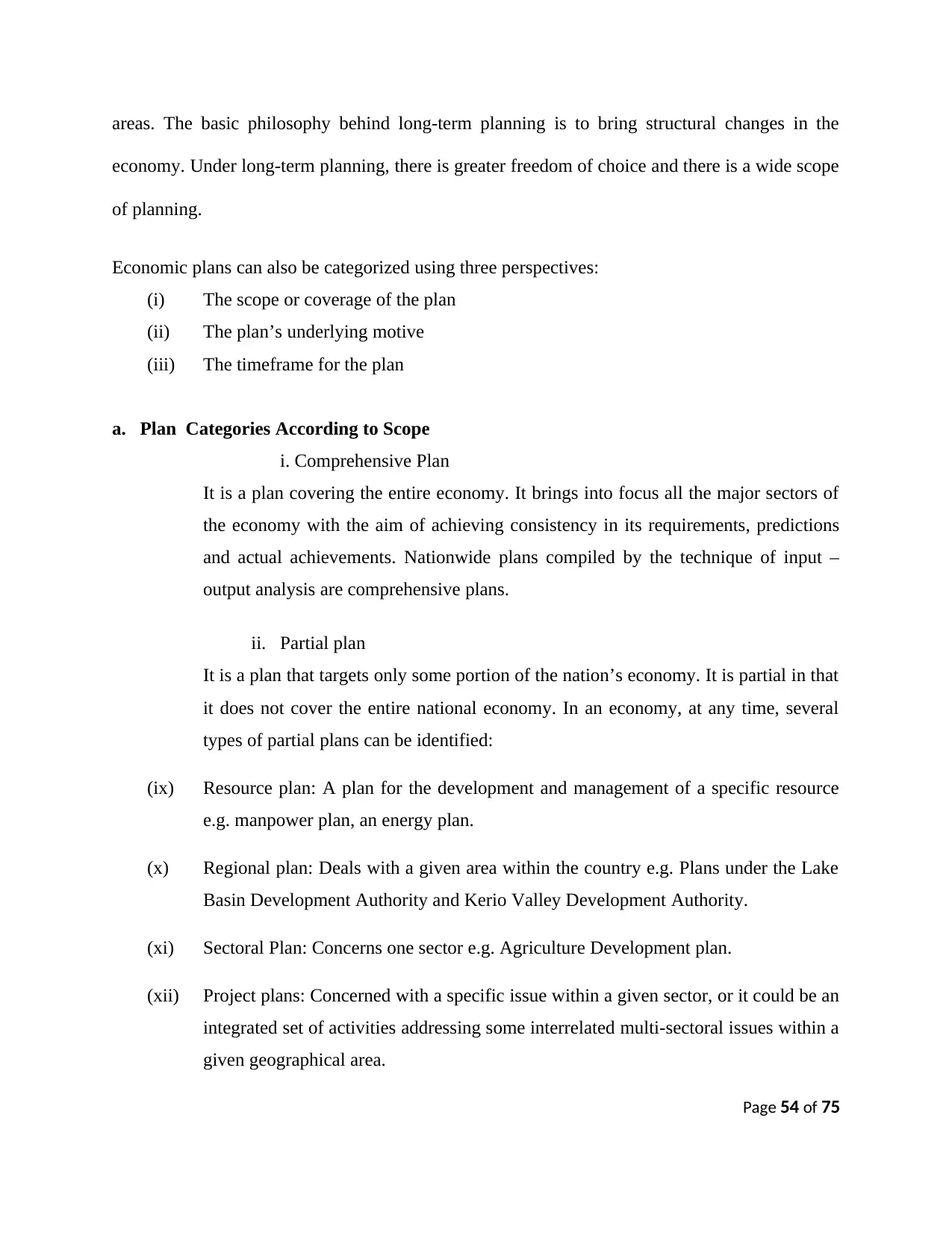
areas. The basic philosophy behind long-term planning is to bring structural changes in the
economy. Under long-term planning, there is greater freedom of choice and there is a wide scope
of planning.
Economic plans can also be categorized using three perspectives:
(i) The scope or coverage of the plan
(ii) The plan’s underlying motive
(iii) The timeframe for the plan
a. Plan Categories According to Scope
i. Comprehensive Plan
It is a plan covering the entire economy. It brings into focus all the major sectors of
the economy with the aim of achieving consistency in its requirements, predictions
and actual achievements. Nationwide plans compiled by the technique of input –
output analysis are comprehensive plans.
ii. Partial plan
It is a plan that targets only some portion of the nation’s economy. It is partial in that
it does not cover the entire national economy. In an economy, at any time, several
types of partial plans can be identified:
(ix) Resource plan: A plan for the development and management of a specific resource
e.g. manpower plan, an energy plan.
(x) Regional plan: Deals with a given area within the country e.g. Plans under the Lake
Basin Development Authority and Kerio Valley Development Authority.
(xi) Sectoral Plan: Concerns one sector e.g. Agriculture Development plan.
(xii) Project plans: Concerned with a specific issue within a given sector, or it could be an
integrated set of activities addressing some interrelated multi-sectoral issues within a
given geographical area.
Page 54 of 75
economy. Under long-term planning, there is greater freedom of choice and there is a wide scope
of planning.
Economic plans can also be categorized using three perspectives:
(i) The scope or coverage of the plan
(ii) The plan’s underlying motive
(iii) The timeframe for the plan
a. Plan Categories According to Scope
i. Comprehensive Plan
It is a plan covering the entire economy. It brings into focus all the major sectors of
the economy with the aim of achieving consistency in its requirements, predictions
and actual achievements. Nationwide plans compiled by the technique of input –
output analysis are comprehensive plans.
ii. Partial plan
It is a plan that targets only some portion of the nation’s economy. It is partial in that
it does not cover the entire national economy. In an economy, at any time, several
types of partial plans can be identified:
(ix) Resource plan: A plan for the development and management of a specific resource
e.g. manpower plan, an energy plan.
(x) Regional plan: Deals with a given area within the country e.g. Plans under the Lake
Basin Development Authority and Kerio Valley Development Authority.
(xi) Sectoral Plan: Concerns one sector e.g. Agriculture Development plan.
(xii) Project plans: Concerned with a specific issue within a given sector, or it could be an
integrated set of activities addressing some interrelated multi-sectoral issues within a
given geographical area.
Page 54 of 75
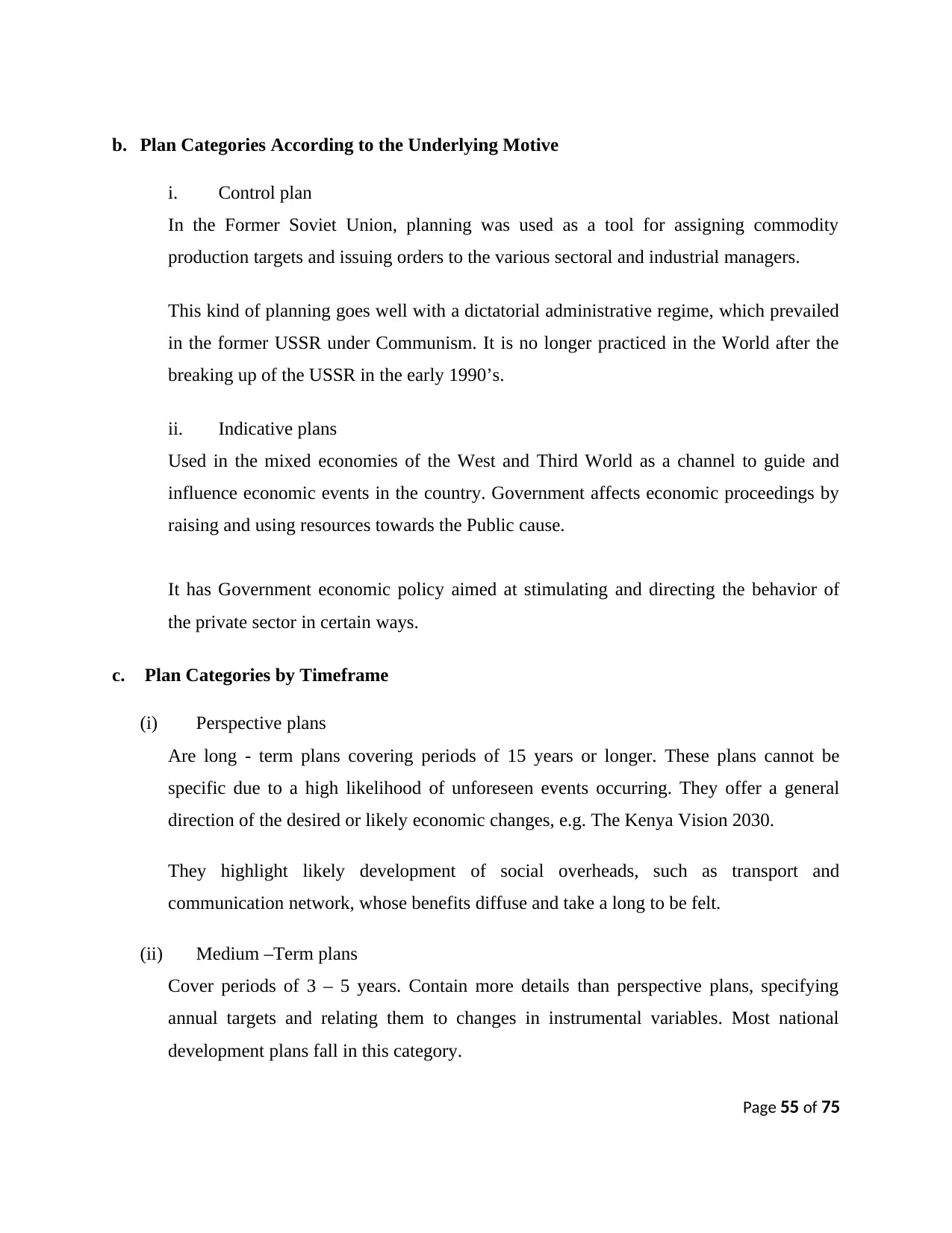
b. Plan Categories According to the Underlying Motive
i. Control plan
In the Former Soviet Union, planning was used as a tool for assigning commodity
production targets and issuing orders to the various sectoral and industrial managers.
This kind of planning goes well with a dictatorial administrative regime, which prevailed
in the former USSR under Communism. It is no longer practiced in the World after the
breaking up of the USSR in the early 1990’s.
ii. Indicative plans
Used in the mixed economies of the West and Third World as a channel to guide and
influence economic events in the country. Government affects economic proceedings by
raising and using resources towards the Public cause.
It has Government economic policy aimed at stimulating and directing the behavior of
the private sector in certain ways.
c. Plan Categories by Timeframe
(i) Perspective plans
Are long - term plans covering periods of 15 years or longer. These plans cannot be
specific due to a high likelihood of unforeseen events occurring. They offer a general
direction of the desired or likely economic changes, e.g. The Kenya Vision 2030.
They highlight likely development of social overheads, such as transport and
communication network, whose benefits diffuse and take a long to be felt.
(ii) Medium –Term plans
Cover periods of 3 – 5 years. Contain more details than perspective plans, specifying
annual targets and relating them to changes in instrumental variables. Most national
development plans fall in this category.
Page 55 of 75
i. Control plan
In the Former Soviet Union, planning was used as a tool for assigning commodity
production targets and issuing orders to the various sectoral and industrial managers.
This kind of planning goes well with a dictatorial administrative regime, which prevailed
in the former USSR under Communism. It is no longer practiced in the World after the
breaking up of the USSR in the early 1990’s.
ii. Indicative plans
Used in the mixed economies of the West and Third World as a channel to guide and
influence economic events in the country. Government affects economic proceedings by
raising and using resources towards the Public cause.
It has Government economic policy aimed at stimulating and directing the behavior of
the private sector in certain ways.
c. Plan Categories by Timeframe
(i) Perspective plans
Are long - term plans covering periods of 15 years or longer. These plans cannot be
specific due to a high likelihood of unforeseen events occurring. They offer a general
direction of the desired or likely economic changes, e.g. The Kenya Vision 2030.
They highlight likely development of social overheads, such as transport and
communication network, whose benefits diffuse and take a long to be felt.
(ii) Medium –Term plans
Cover periods of 3 – 5 years. Contain more details than perspective plans, specifying
annual targets and relating them to changes in instrumental variables. Most national
development plans fall in this category.
Page 55 of 75
Paraphrase This Document
Need a fresh take? Get an instant paraphrase of this document with our AI Paraphraser

(iii) Annual (Operational) plans
They break a medium – term plan into operational (i.e. actionable) components, with
specific targets and resource allocations. The state’s annual budget and its sectoral
(ministerial) components is such a plan.
Lecture summary
In this lecture we have discussed planning procedures and types of
development plans
Work to do
Citing relevant examples from Kenya differentiate between perspective, medium-term
and annual plans.
Page 56 of 75
They break a medium – term plan into operational (i.e. actionable) components, with
specific targets and resource allocations. The state’s annual budget and its sectoral
(ministerial) components is such a plan.
Lecture summary
In this lecture we have discussed planning procedures and types of
development plans
Work to do
Citing relevant examples from Kenya differentiate between perspective, medium-term
and annual plans.
Page 56 of 75
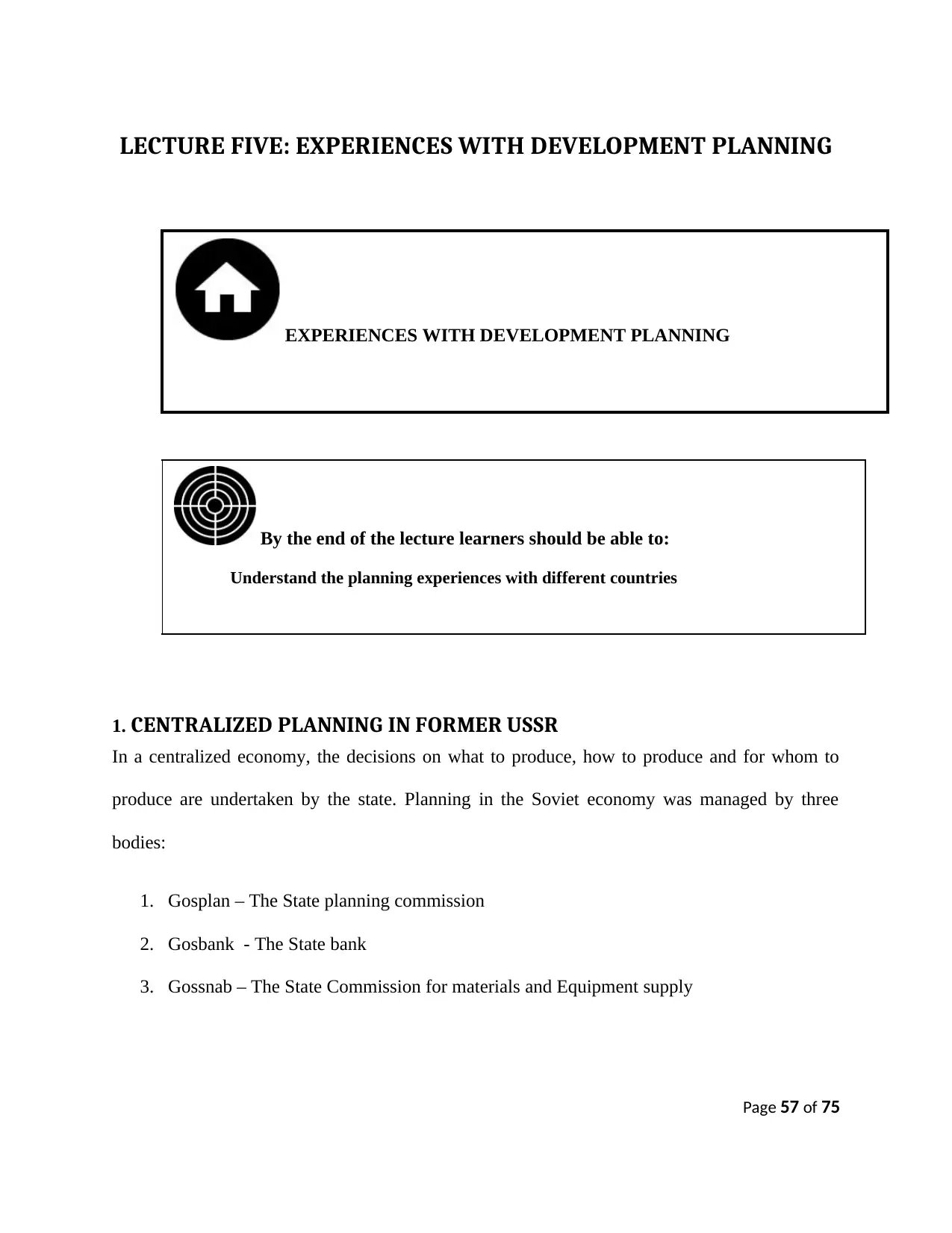
LECTURE FIVE: EXPERIENCES WITH DEVELOPMENT PLANNING
1. CENTRALIZED PLANNING IN FORMER USSR
In a centralized economy, the decisions on what to produce, how to produce and for whom to
produce are undertaken by the state. Planning in the Soviet economy was managed by three
bodies:
1. Gosplan – The State planning commission
2. Gosbank - The State bank
3. Gossnab – The State Commission for materials and Equipment supply
Page 57 of 75
EXPERIENCES WITH DEVELOPMENT PLANNING
By the end of the lecture learners should be able to:
Understand the planning experiences with different countries
1. CENTRALIZED PLANNING IN FORMER USSR
In a centralized economy, the decisions on what to produce, how to produce and for whom to
produce are undertaken by the state. Planning in the Soviet economy was managed by three
bodies:
1. Gosplan – The State planning commission
2. Gosbank - The State bank
3. Gossnab – The State Commission for materials and Equipment supply
Page 57 of 75
EXPERIENCES WITH DEVELOPMENT PLANNING
By the end of the lecture learners should be able to:
Understand the planning experiences with different countries

The economy was guided by five-year plans. Planning ministries defined the mix of economic
inputs, a schedule for completion, all wholesale prices and almost all retail prices. There was a
balance between inputs and output targets for the planning period.
In the early years, (from 1928) emphasis was on production of capital goods (they were referred
to as group A goods) for they were considered means of production. Capital goods were
perceived as a necessity for fast industrialization. It is after 1953 (after Stalin’s death) that
emphasis was laid on consumer goods.
Most information flowed from the top down. There was in place a mechanism for producers and
consumers to provide input and information that would help in drafting the economic plans. But
due to the political climate then, few people ever provided negative input or criticism of the plan.
This meant that the planners didn’t have reliable information to assist the planning process
making planning to rely on faulty and outdated information. As a result, some goods were
overproduced, whereas others were under produced.
Because the Soviet Union laid emphasis on Capital goods, it became one of the leading industrial
nations of the World. There was disproportionately low production of consumer goods, resulting
in severe shortages of many of these goods. This led to consumers lining for the goods, rationing,
and development of the black market (For example in the case of cigarettes).
The Drafting of the Five Year Plan
The periods covered by the five year plan coincided with those covered by the gatherings of the
Communist Party of the Soviet Union (CPSU) congress. At each CPSU congress, the party’s
leadership presented targets for the next five year plan. Thus, the Central Committee of the
Page 58 of 75
inputs, a schedule for completion, all wholesale prices and almost all retail prices. There was a
balance between inputs and output targets for the planning period.
In the early years, (from 1928) emphasis was on production of capital goods (they were referred
to as group A goods) for they were considered means of production. Capital goods were
perceived as a necessity for fast industrialization. It is after 1953 (after Stalin’s death) that
emphasis was laid on consumer goods.
Most information flowed from the top down. There was in place a mechanism for producers and
consumers to provide input and information that would help in drafting the economic plans. But
due to the political climate then, few people ever provided negative input or criticism of the plan.
This meant that the planners didn’t have reliable information to assist the planning process
making planning to rely on faulty and outdated information. As a result, some goods were
overproduced, whereas others were under produced.
Because the Soviet Union laid emphasis on Capital goods, it became one of the leading industrial
nations of the World. There was disproportionately low production of consumer goods, resulting
in severe shortages of many of these goods. This led to consumers lining for the goods, rationing,
and development of the black market (For example in the case of cigarettes).
The Drafting of the Five Year Plan
The periods covered by the five year plan coincided with those covered by the gatherings of the
Communist Party of the Soviet Union (CPSU) congress. At each CPSU congress, the party’s
leadership presented targets for the next five year plan. Thus, the Central Committee of the
Page 58 of 75
Secure Best Marks with AI Grader
Need help grading? Try our AI Grader for instant feedback on your assignments.
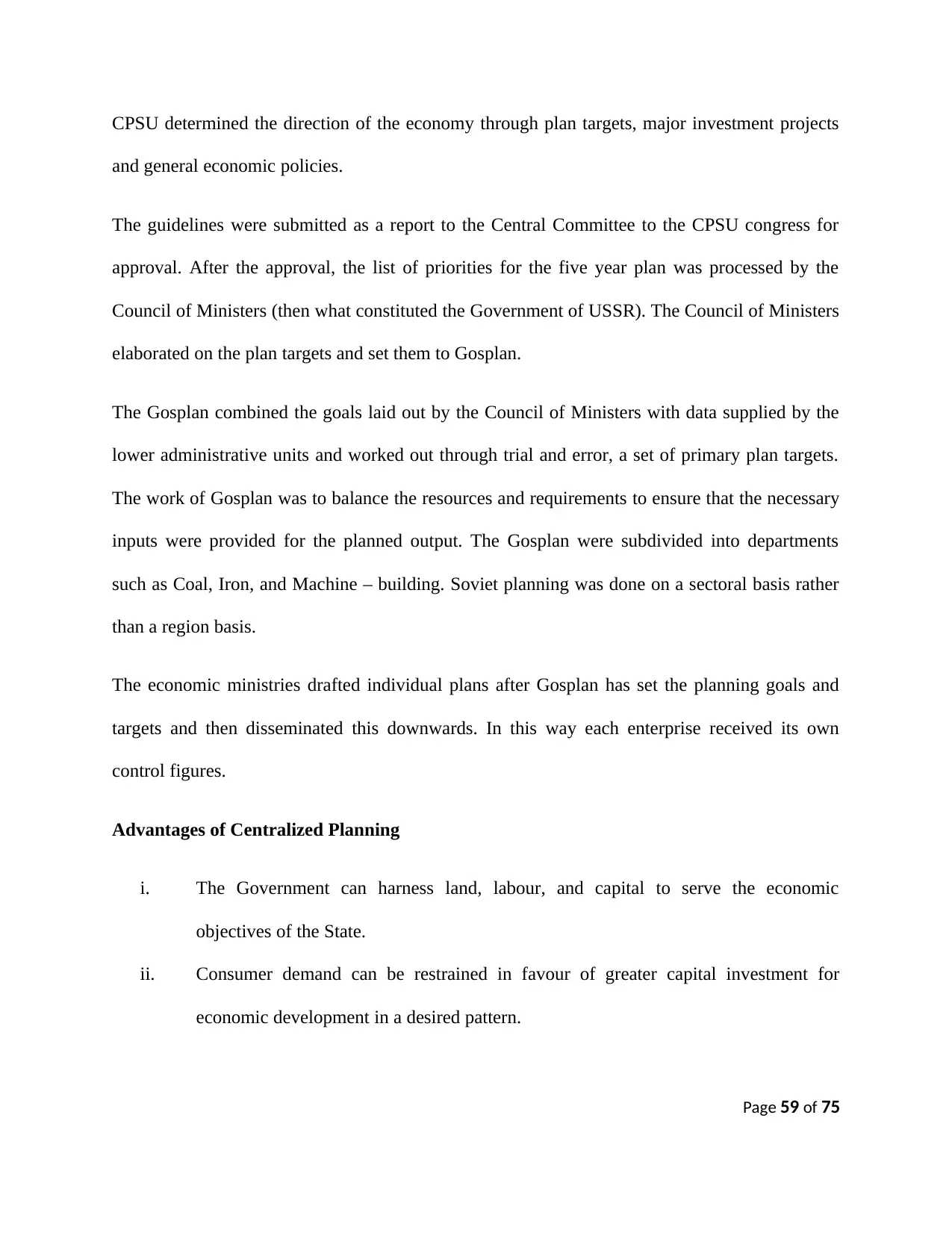
CPSU determined the direction of the economy through plan targets, major investment projects
and general economic policies.
The guidelines were submitted as a report to the Central Committee to the CPSU congress for
approval. After the approval, the list of priorities for the five year plan was processed by the
Council of Ministers (then what constituted the Government of USSR). The Council of Ministers
elaborated on the plan targets and set them to Gosplan.
The Gosplan combined the goals laid out by the Council of Ministers with data supplied by the
lower administrative units and worked out through trial and error, a set of primary plan targets.
The work of Gosplan was to balance the resources and requirements to ensure that the necessary
inputs were provided for the planned output. The Gosplan were subdivided into departments
such as Coal, Iron, and Machine – building. Soviet planning was done on a sectoral basis rather
than a region basis.
The economic ministries drafted individual plans after Gosplan has set the planning goals and
targets and then disseminated this downwards. In this way each enterprise received its own
control figures.
Advantages of Centralized Planning
i. The Government can harness land, labour, and capital to serve the economic
objectives of the State.
ii. Consumer demand can be restrained in favour of greater capital investment for
economic development in a desired pattern.
Page 59 of 75
and general economic policies.
The guidelines were submitted as a report to the Central Committee to the CPSU congress for
approval. After the approval, the list of priorities for the five year plan was processed by the
Council of Ministers (then what constituted the Government of USSR). The Council of Ministers
elaborated on the plan targets and set them to Gosplan.
The Gosplan combined the goals laid out by the Council of Ministers with data supplied by the
lower administrative units and worked out through trial and error, a set of primary plan targets.
The work of Gosplan was to balance the resources and requirements to ensure that the necessary
inputs were provided for the planned output. The Gosplan were subdivided into departments
such as Coal, Iron, and Machine – building. Soviet planning was done on a sectoral basis rather
than a region basis.
The economic ministries drafted individual plans after Gosplan has set the planning goals and
targets and then disseminated this downwards. In this way each enterprise received its own
control figures.
Advantages of Centralized Planning
i. The Government can harness land, labour, and capital to serve the economic
objectives of the State.
ii. Consumer demand can be restrained in favour of greater capital investment for
economic development in a desired pattern.
Page 59 of 75
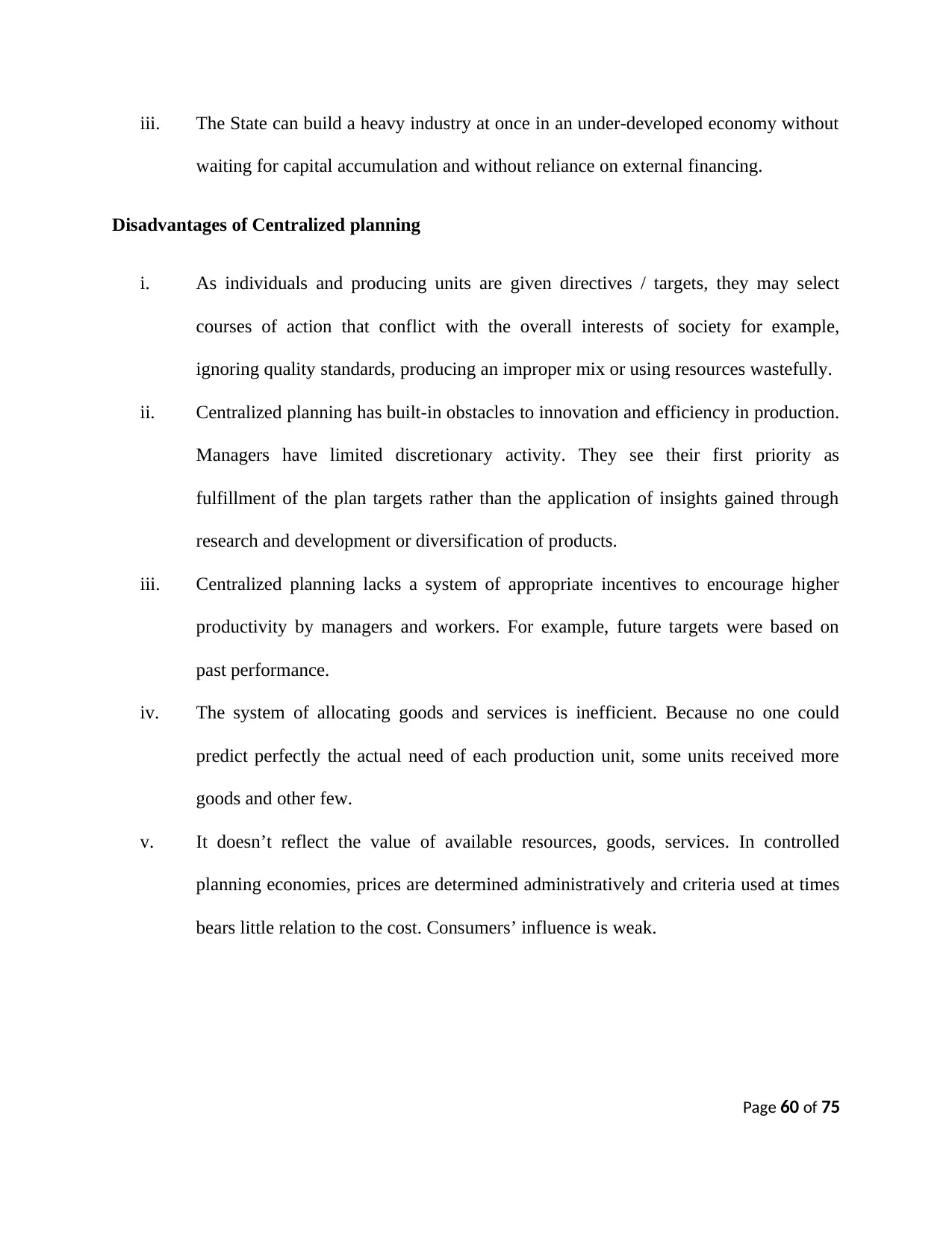
iii. The State can build a heavy industry at once in an under-developed economy without
waiting for capital accumulation and without reliance on external financing.
Disadvantages of Centralized planning
i. As individuals and producing units are given directives / targets, they may select
courses of action that conflict with the overall interests of society for example,
ignoring quality standards, producing an improper mix or using resources wastefully.
ii. Centralized planning has built-in obstacles to innovation and efficiency in production.
Managers have limited discretionary activity. They see their first priority as
fulfillment of the plan targets rather than the application of insights gained through
research and development or diversification of products.
iii. Centralized planning lacks a system of appropriate incentives to encourage higher
productivity by managers and workers. For example, future targets were based on
past performance.
iv. The system of allocating goods and services is inefficient. Because no one could
predict perfectly the actual need of each production unit, some units received more
goods and other few.
v. It doesn’t reflect the value of available resources, goods, services. In controlled
planning economies, prices are determined administratively and criteria used at times
bears little relation to the cost. Consumers’ influence is weak.
Page 60 of 75
waiting for capital accumulation and without reliance on external financing.
Disadvantages of Centralized planning
i. As individuals and producing units are given directives / targets, they may select
courses of action that conflict with the overall interests of society for example,
ignoring quality standards, producing an improper mix or using resources wastefully.
ii. Centralized planning has built-in obstacles to innovation and efficiency in production.
Managers have limited discretionary activity. They see their first priority as
fulfillment of the plan targets rather than the application of insights gained through
research and development or diversification of products.
iii. Centralized planning lacks a system of appropriate incentives to encourage higher
productivity by managers and workers. For example, future targets were based on
past performance.
iv. The system of allocating goods and services is inefficient. Because no one could
predict perfectly the actual need of each production unit, some units received more
goods and other few.
v. It doesn’t reflect the value of available resources, goods, services. In controlled
planning economies, prices are determined administratively and criteria used at times
bears little relation to the cost. Consumers’ influence is weak.
Page 60 of 75
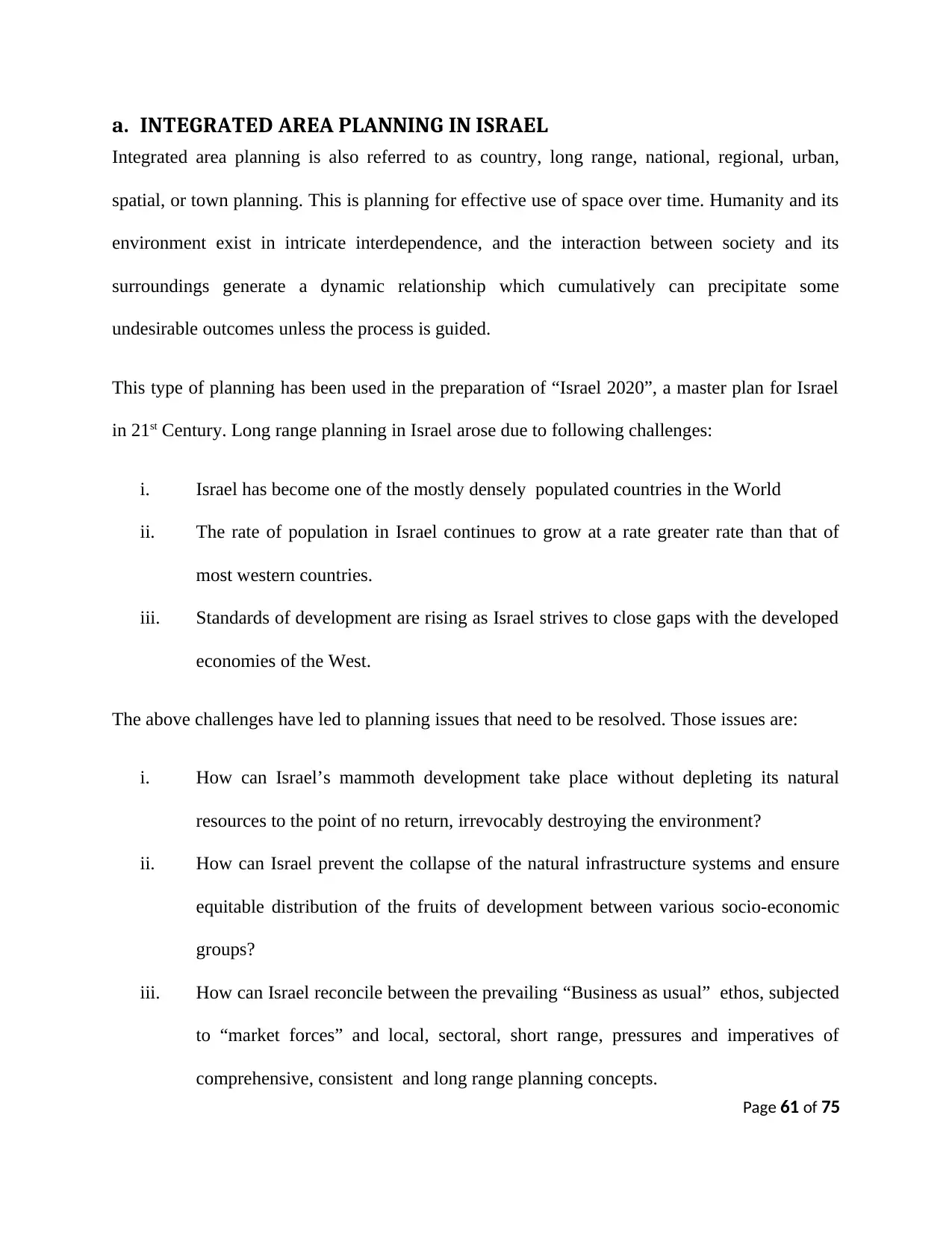
a. INTEGRATED AREA PLANNING IN ISRAEL
Integrated area planning is also referred to as country, long range, national, regional, urban,
spatial, or town planning. This is planning for effective use of space over time. Humanity and its
environment exist in intricate interdependence, and the interaction between society and its
surroundings generate a dynamic relationship which cumulatively can precipitate some
undesirable outcomes unless the process is guided.
This type of planning has been used in the preparation of “Israel 2020”, a master plan for Israel
in 21st Century. Long range planning in Israel arose due to following challenges:
i. Israel has become one of the mostly densely populated countries in the World
ii. The rate of population in Israel continues to grow at a rate greater rate than that of
most western countries.
iii. Standards of development are rising as Israel strives to close gaps with the developed
economies of the West.
The above challenges have led to planning issues that need to be resolved. Those issues are:
i. How can Israel’s mammoth development take place without depleting its natural
resources to the point of no return, irrevocably destroying the environment?
ii. How can Israel prevent the collapse of the natural infrastructure systems and ensure
equitable distribution of the fruits of development between various socio-economic
groups?
iii. How can Israel reconcile between the prevailing “Business as usual” ethos, subjected
to “market forces” and local, sectoral, short range, pressures and imperatives of
comprehensive, consistent and long range planning concepts.
Page 61 of 75
Integrated area planning is also referred to as country, long range, national, regional, urban,
spatial, or town planning. This is planning for effective use of space over time. Humanity and its
environment exist in intricate interdependence, and the interaction between society and its
surroundings generate a dynamic relationship which cumulatively can precipitate some
undesirable outcomes unless the process is guided.
This type of planning has been used in the preparation of “Israel 2020”, a master plan for Israel
in 21st Century. Long range planning in Israel arose due to following challenges:
i. Israel has become one of the mostly densely populated countries in the World
ii. The rate of population in Israel continues to grow at a rate greater rate than that of
most western countries.
iii. Standards of development are rising as Israel strives to close gaps with the developed
economies of the West.
The above challenges have led to planning issues that need to be resolved. Those issues are:
i. How can Israel’s mammoth development take place without depleting its natural
resources to the point of no return, irrevocably destroying the environment?
ii. How can Israel prevent the collapse of the natural infrastructure systems and ensure
equitable distribution of the fruits of development between various socio-economic
groups?
iii. How can Israel reconcile between the prevailing “Business as usual” ethos, subjected
to “market forces” and local, sectoral, short range, pressures and imperatives of
comprehensive, consistent and long range planning concepts.
Page 61 of 75
Paraphrase This Document
Need a fresh take? Get an instant paraphrase of this document with our AI Paraphraser

To focus on the range of options for Israel’s master plan, four principle alternatives were
developed:
i. The “business as usual” alternative assumes that the existing trends of development will
continue with no major planning interventions influencing the expected outcome of
market forces and other motivations dominating the Israel society.
ii. The economic alternative: highlights industry promotions endeavors directed at
achieving growth of knowledge and inter service endeavours directed at achieving
growth by promoting productive services coupled with research and technological
development.
iii. Social alternative: Advocates of value of “quality of life for all” by motivation strategies
between opposition social groups and deviating existing gaps in the Israel society.
iv. The physical-environment alternative supports sustainable development in the face of
increasing spatial density, and the depletion of land resources. It concentrates on the
need to preserve the scenic and environmental uniqueness of various regions of the
country.
The Spatial Organization plan for Israel
The national spatial plan directs the future organization development according to the principles
of concentrated – Dispersal; on the national level development is dispersed, whereas on the
regional level it is concentrated. The implementation of the principle of concentrated – dispersal,
within the country’s division into seven regions as follows:-
a) Three urban regions
Page 62 of 75
developed:
i. The “business as usual” alternative assumes that the existing trends of development will
continue with no major planning interventions influencing the expected outcome of
market forces and other motivations dominating the Israel society.
ii. The economic alternative: highlights industry promotions endeavors directed at
achieving growth of knowledge and inter service endeavours directed at achieving
growth by promoting productive services coupled with research and technological
development.
iii. Social alternative: Advocates of value of “quality of life for all” by motivation strategies
between opposition social groups and deviating existing gaps in the Israel society.
iv. The physical-environment alternative supports sustainable development in the face of
increasing spatial density, and the depletion of land resources. It concentrates on the
need to preserve the scenic and environmental uniqueness of various regions of the
country.
The Spatial Organization plan for Israel
The national spatial plan directs the future organization development according to the principles
of concentrated – Dispersal; on the national level development is dispersed, whereas on the
regional level it is concentrated. The implementation of the principle of concentrated – dispersal,
within the country’s division into seven regions as follows:-
a) Three urban regions
Page 62 of 75

b) Two intermediate region
c) Two open regions
The Urban regions
They are differentiated by special characteristics and functions in the national arena.
Transportation systems are planned so as to establish a “region of choices” that promotes
diversity and spatial specialization.
Two Intermediate regions
This combines the existing rural areas and sites, chosen as worthy preservation. Planning efforts
in the intermediate regions are geared to prevent sub-urban sprawl and metropolitan overspill
between urban centers.
Two Open regions
These are areas that span over extensive environments. Planning efforts here are aimed at
preservation, limiting urban development to the intersections of the main roads where centers of
the scattered rural communities are located.
b. PLANNING IN KENYA
Over the years, Kenya has been practicing a decentralized system of planning: an execution of
the planning from the grassroots. Under this, a plan is formulated by the Central Planning
Authority in consultation with the different administration units in the country.
After independence development planning was informed by the Sessional paper No. 10 of 1965
on “African Socialism”. The sessional paper lay emphasis on economic growth, assuming that
Page 63 of 75
c) Two open regions
The Urban regions
They are differentiated by special characteristics and functions in the national arena.
Transportation systems are planned so as to establish a “region of choices” that promotes
diversity and spatial specialization.
Two Intermediate regions
This combines the existing rural areas and sites, chosen as worthy preservation. Planning efforts
in the intermediate regions are geared to prevent sub-urban sprawl and metropolitan overspill
between urban centers.
Two Open regions
These are areas that span over extensive environments. Planning efforts here are aimed at
preservation, limiting urban development to the intersections of the main roads where centers of
the scattered rural communities are located.
b. PLANNING IN KENYA
Over the years, Kenya has been practicing a decentralized system of planning: an execution of
the planning from the grassroots. Under this, a plan is formulated by the Central Planning
Authority in consultation with the different administration units in the country.
After independence development planning was informed by the Sessional paper No. 10 of 1965
on “African Socialism”. The sessional paper lay emphasis on economic growth, assuming that
Page 63 of 75
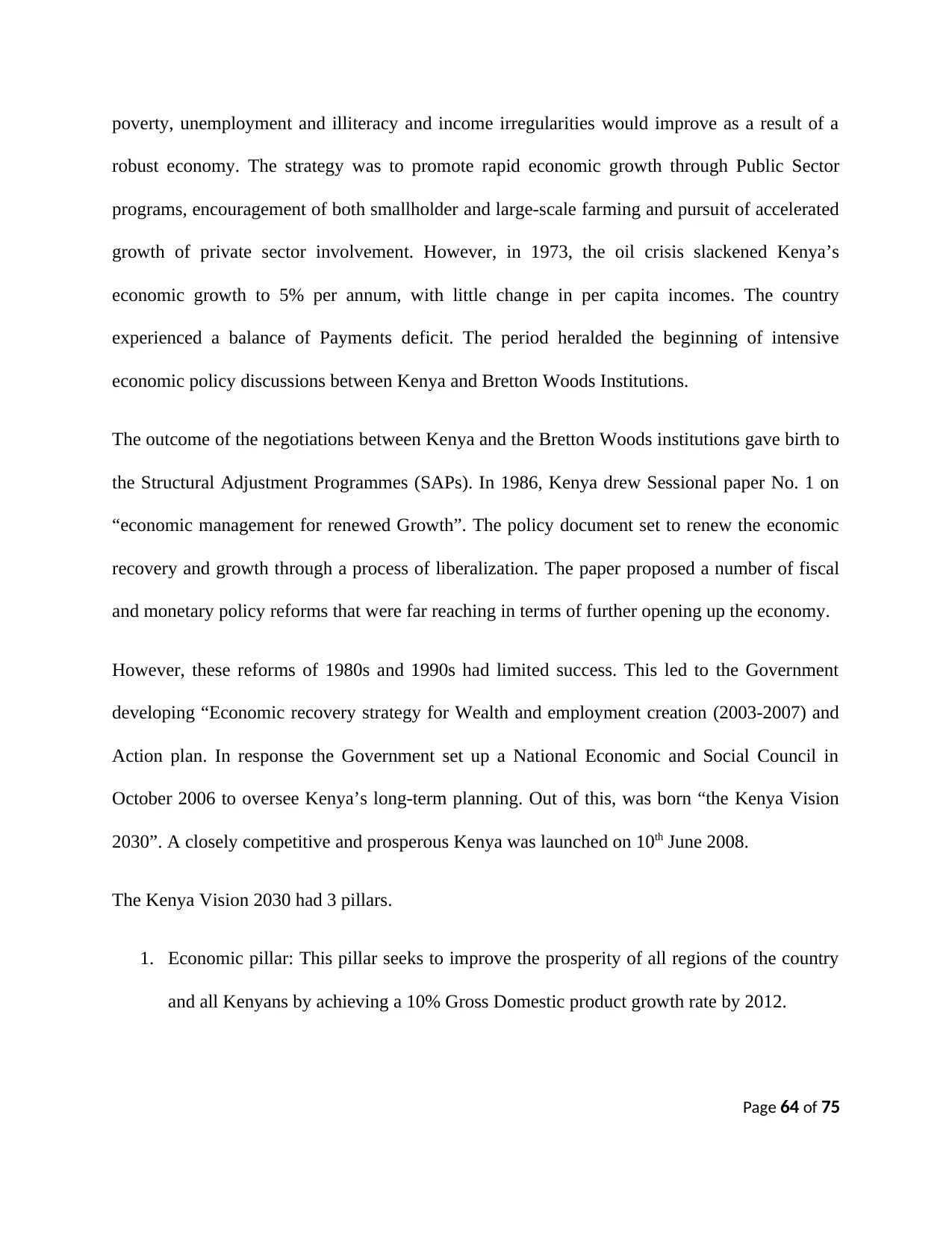
poverty, unemployment and illiteracy and income irregularities would improve as a result of a
robust economy. The strategy was to promote rapid economic growth through Public Sector
programs, encouragement of both smallholder and large-scale farming and pursuit of accelerated
growth of private sector involvement. However, in 1973, the oil crisis slackened Kenya’s
economic growth to 5% per annum, with little change in per capita incomes. The country
experienced a balance of Payments deficit. The period heralded the beginning of intensive
economic policy discussions between Kenya and Bretton Woods Institutions.
The outcome of the negotiations between Kenya and the Bretton Woods institutions gave birth to
the Structural Adjustment Programmes (SAPs). In 1986, Kenya drew Sessional paper No. 1 on
“economic management for renewed Growth”. The policy document set to renew the economic
recovery and growth through a process of liberalization. The paper proposed a number of fiscal
and monetary policy reforms that were far reaching in terms of further opening up the economy.
However, these reforms of 1980s and 1990s had limited success. This led to the Government
developing “Economic recovery strategy for Wealth and employment creation (2003-2007) and
Action plan. In response the Government set up a National Economic and Social Council in
October 2006 to oversee Kenya’s long-term planning. Out of this, was born “the Kenya Vision
2030”. A closely competitive and prosperous Kenya was launched on 10th June 2008.
The Kenya Vision 2030 had 3 pillars.
1. Economic pillar: This pillar seeks to improve the prosperity of all regions of the country
and all Kenyans by achieving a 10% Gross Domestic product growth rate by 2012.
Page 64 of 75
robust economy. The strategy was to promote rapid economic growth through Public Sector
programs, encouragement of both smallholder and large-scale farming and pursuit of accelerated
growth of private sector involvement. However, in 1973, the oil crisis slackened Kenya’s
economic growth to 5% per annum, with little change in per capita incomes. The country
experienced a balance of Payments deficit. The period heralded the beginning of intensive
economic policy discussions between Kenya and Bretton Woods Institutions.
The outcome of the negotiations between Kenya and the Bretton Woods institutions gave birth to
the Structural Adjustment Programmes (SAPs). In 1986, Kenya drew Sessional paper No. 1 on
“economic management for renewed Growth”. The policy document set to renew the economic
recovery and growth through a process of liberalization. The paper proposed a number of fiscal
and monetary policy reforms that were far reaching in terms of further opening up the economy.
However, these reforms of 1980s and 1990s had limited success. This led to the Government
developing “Economic recovery strategy for Wealth and employment creation (2003-2007) and
Action plan. In response the Government set up a National Economic and Social Council in
October 2006 to oversee Kenya’s long-term planning. Out of this, was born “the Kenya Vision
2030”. A closely competitive and prosperous Kenya was launched on 10th June 2008.
The Kenya Vision 2030 had 3 pillars.
1. Economic pillar: This pillar seeks to improve the prosperity of all regions of the country
and all Kenyans by achieving a 10% Gross Domestic product growth rate by 2012.
Page 64 of 75
Secure Best Marks with AI Grader
Need help grading? Try our AI Grader for instant feedback on your assignments.

2. The Social pillar: The pillar aims at investing in the people of Kenya in order to improve
quality of life for all Kenyans. It targets a cross section of human and social welfare
projects and programs.
3. Political pillar: Aims at Kenya moving into the future as one nation and envisions a
democratic system that is issue based, people centered, results oriented, and accountable
to the public.
Under each pillar, we have flagship projects / growth drivers. For example, the economic pillar
has identified 6 growth drivers:- Agriculture, Tourism, manufacturing, ICT, Business process
outsourcing.
NB.
A new constitutional order was voted for by Kenyans in August 2010. The 2010 Constitution
created 47 counties each with its own government. This has the effect of decentralizing planning,
where each county Government develops its own plan as the National Government does the
overall planning of the national economy. All these plans are prepared in line with the Kenya
Vision 2030.
Lecture summary
This lecture has looked at the planning experiences of three countries; former USSR, Israel and
Kenya
Page 65 of 75
quality of life for all Kenyans. It targets a cross section of human and social welfare
projects and programs.
3. Political pillar: Aims at Kenya moving into the future as one nation and envisions a
democratic system that is issue based, people centered, results oriented, and accountable
to the public.
Under each pillar, we have flagship projects / growth drivers. For example, the economic pillar
has identified 6 growth drivers:- Agriculture, Tourism, manufacturing, ICT, Business process
outsourcing.
NB.
A new constitutional order was voted for by Kenyans in August 2010. The 2010 Constitution
created 47 counties each with its own government. This has the effect of decentralizing planning,
where each county Government develops its own plan as the National Government does the
overall planning of the national economy. All these plans are prepared in line with the Kenya
Vision 2030.
Lecture summary
This lecture has looked at the planning experiences of three countries; former USSR, Israel and
Kenya
Page 65 of 75

Work to do
What are the similarities and differences between planning in Israel?
Page 66 of 75
What are the similarities and differences between planning in Israel?
Page 66 of 75

LECTURE SIX: ISSUES IN DEVLOMENT PLANNING
1. CAUSES OF FAILURE OF PLANS IN DEVELOPING COUNTRIES
Introduction
Planning simply involves the process and activities taken to drive the economic outcomes to
expected levels. At the national level, planning is part of Government activities. Therefore,
planning requires adequate framework to effectively deliver its desired outcomes.
Page 67 of 75
By the end of the lecture learners should be able to:
1. Understand the causes of failure of development plans
2. Appreciate the impact of socio-economic integration on development planning
ISSUES IN DEVLOMENT PLANNING
1. CAUSES OF FAILURE OF PLANS IN DEVELOPING COUNTRIES
Introduction
Planning simply involves the process and activities taken to drive the economic outcomes to
expected levels. At the national level, planning is part of Government activities. Therefore,
planning requires adequate framework to effectively deliver its desired outcomes.
Page 67 of 75
By the end of the lecture learners should be able to:
1. Understand the causes of failure of development plans
2. Appreciate the impact of socio-economic integration on development planning
ISSUES IN DEVLOMENT PLANNING
Paraphrase This Document
Need a fresh take? Get an instant paraphrase of this document with our AI Paraphraser
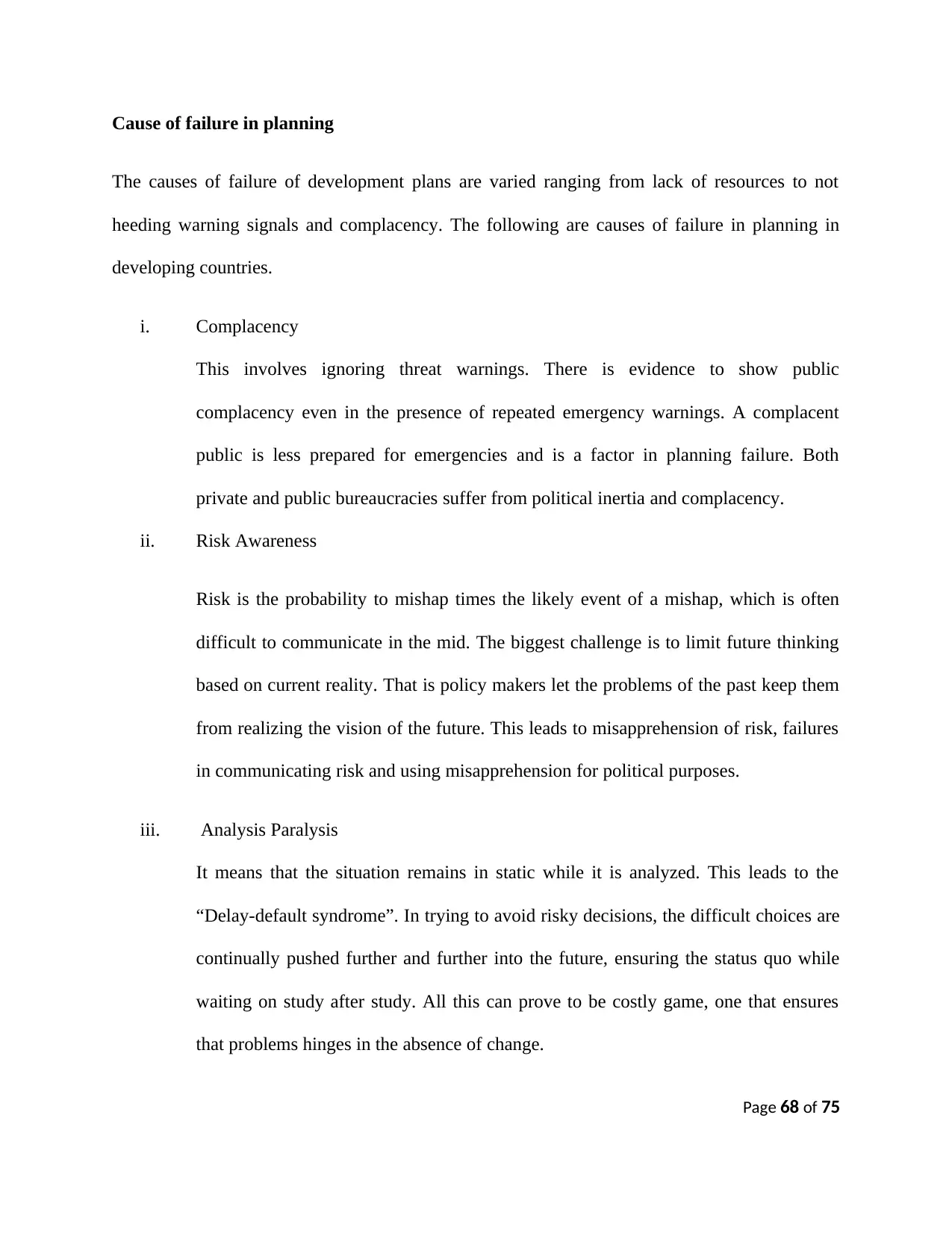
Cause of failure in planning
The causes of failure of development plans are varied ranging from lack of resources to not
heeding warning signals and complacency. The following are causes of failure in planning in
developing countries.
i. Complacency
This involves ignoring threat warnings. There is evidence to show public
complacency even in the presence of repeated emergency warnings. A complacent
public is less prepared for emergencies and is a factor in planning failure. Both
private and public bureaucracies suffer from political inertia and complacency.
ii. Risk Awareness
Risk is the probability to mishap times the likely event of a mishap, which is often
difficult to communicate in the mid. The biggest challenge is to limit future thinking
based on current reality. That is policy makers let the problems of the past keep them
from realizing the vision of the future. This leads to misapprehension of risk, failures
in communicating risk and using misapprehension for political purposes.
iii. Analysis Paralysis
It means that the situation remains in static while it is analyzed. This leads to the
“Delay-default syndrome”. In trying to avoid risky decisions, the difficult choices are
continually pushed further and further into the future, ensuring the status quo while
waiting on study after study. All this can prove to be costly game, one that ensures
that problems hinges in the absence of change.
Page 68 of 75
The causes of failure of development plans are varied ranging from lack of resources to not
heeding warning signals and complacency. The following are causes of failure in planning in
developing countries.
i. Complacency
This involves ignoring threat warnings. There is evidence to show public
complacency even in the presence of repeated emergency warnings. A complacent
public is less prepared for emergencies and is a factor in planning failure. Both
private and public bureaucracies suffer from political inertia and complacency.
ii. Risk Awareness
Risk is the probability to mishap times the likely event of a mishap, which is often
difficult to communicate in the mid. The biggest challenge is to limit future thinking
based on current reality. That is policy makers let the problems of the past keep them
from realizing the vision of the future. This leads to misapprehension of risk, failures
in communicating risk and using misapprehension for political purposes.
iii. Analysis Paralysis
It means that the situation remains in static while it is analyzed. This leads to the
“Delay-default syndrome”. In trying to avoid risky decisions, the difficult choices are
continually pushed further and further into the future, ensuring the status quo while
waiting on study after study. All this can prove to be costly game, one that ensures
that problems hinges in the absence of change.
Page 68 of 75
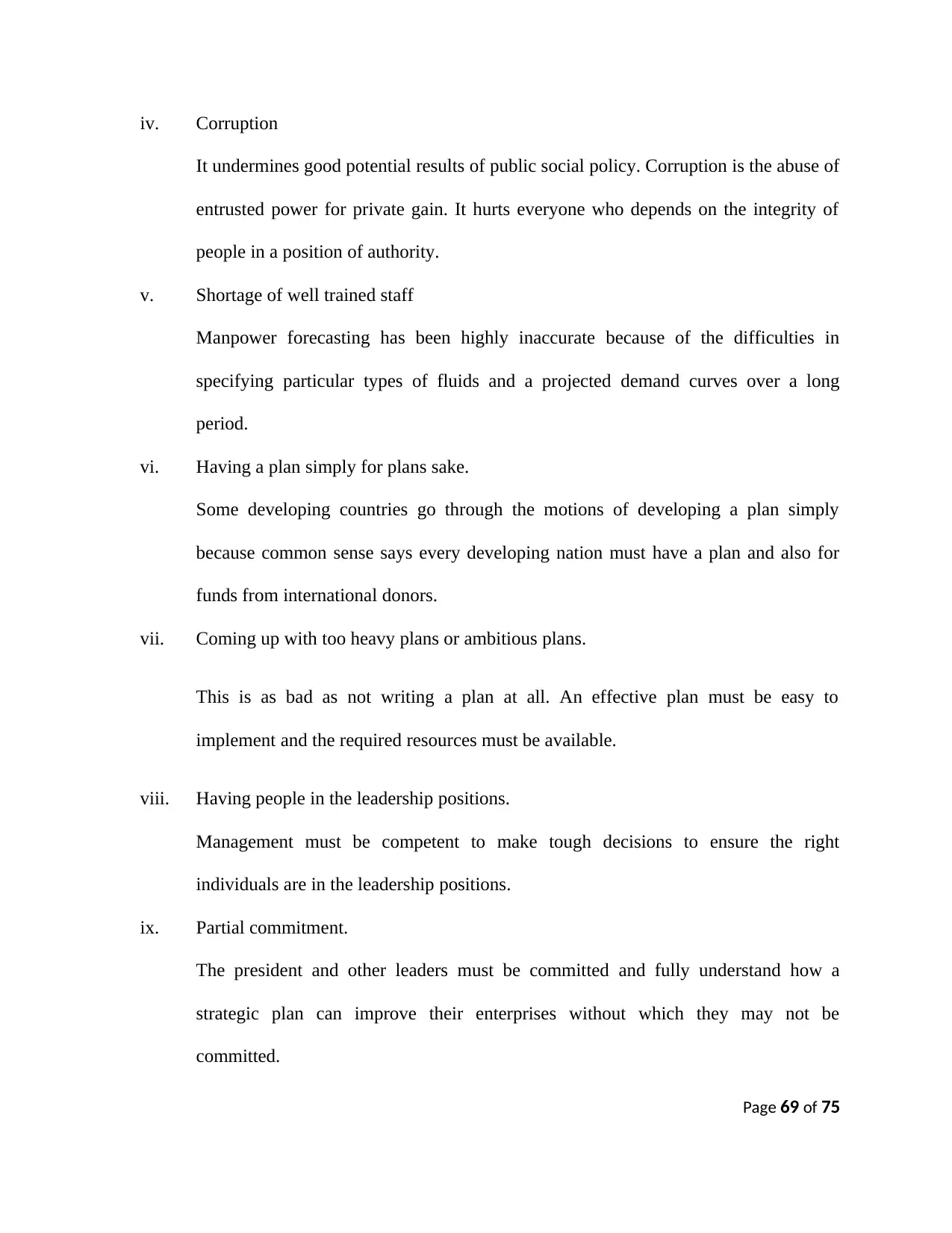
iv. Corruption
It undermines good potential results of public social policy. Corruption is the abuse of
entrusted power for private gain. It hurts everyone who depends on the integrity of
people in a position of authority.
v. Shortage of well trained staff
Manpower forecasting has been highly inaccurate because of the difficulties in
specifying particular types of fluids and a projected demand curves over a long
period.
vi. Having a plan simply for plans sake.
Some developing countries go through the motions of developing a plan simply
because common sense says every developing nation must have a plan and also for
funds from international donors.
vii. Coming up with too heavy plans or ambitious plans.
This is as bad as not writing a plan at all. An effective plan must be easy to
implement and the required resources must be available.
viii. Having people in the leadership positions.
Management must be competent to make tough decisions to ensure the right
individuals are in the leadership positions.
ix. Partial commitment.
The president and other leaders must be committed and fully understand how a
strategic plan can improve their enterprises without which they may not be
committed.
Page 69 of 75
It undermines good potential results of public social policy. Corruption is the abuse of
entrusted power for private gain. It hurts everyone who depends on the integrity of
people in a position of authority.
v. Shortage of well trained staff
Manpower forecasting has been highly inaccurate because of the difficulties in
specifying particular types of fluids and a projected demand curves over a long
period.
vi. Having a plan simply for plans sake.
Some developing countries go through the motions of developing a plan simply
because common sense says every developing nation must have a plan and also for
funds from international donors.
vii. Coming up with too heavy plans or ambitious plans.
This is as bad as not writing a plan at all. An effective plan must be easy to
implement and the required resources must be available.
viii. Having people in the leadership positions.
Management must be competent to make tough decisions to ensure the right
individuals are in the leadership positions.
ix. Partial commitment.
The president and other leaders must be committed and fully understand how a
strategic plan can improve their enterprises without which they may not be
committed.
Page 69 of 75

x. No understanding of the environment.
Planning must pay attention to changes in the economic environment, set meaningful
priorities and understand the need to pursue results.
xi. No accountability or follow up through.
There is need to be tough once the plan is developed and resources are committed and
ensure there are consequences for not delivering on the strategy.
xii. Unrealistic goals or lack of focus and resources
Strategic plans must be focused and include a manageable number of goals,
objectives and programs. There is need to assign adequate resources to accomplish
those goals and objectives.
xiii. Dominance of politics and self interest and focus of key players on personal needs
and goals often related to playing politics, with symptoms like infighting, resistance
where loss of power is feared.
xiv. Lack of vision and strategy. Lack of long-term view, code of guidance, and lack of
link between ends and means.
xv. The ability to identify potential risks at a stage when they are still considered
harmless by most companies and the ability to respond forcefully to warning signals
even when they are weak are Central to avoiding planning failure.
2. THE IMPACT OF SOCIO-ECONOMIC INTEGRATION
What is Socio-economic integration?
Is the process of creating unity, inclusion and participation at all levels of society within
the diversity of countries’(s) attributes so that every country is free to be the country it
Page 70 of 75
Planning must pay attention to changes in the economic environment, set meaningful
priorities and understand the need to pursue results.
xi. No accountability or follow up through.
There is need to be tough once the plan is developed and resources are committed and
ensure there are consequences for not delivering on the strategy.
xii. Unrealistic goals or lack of focus and resources
Strategic plans must be focused and include a manageable number of goals,
objectives and programs. There is need to assign adequate resources to accomplish
those goals and objectives.
xiii. Dominance of politics and self interest and focus of key players on personal needs
and goals often related to playing politics, with symptoms like infighting, resistance
where loss of power is feared.
xiv. Lack of vision and strategy. Lack of long-term view, code of guidance, and lack of
link between ends and means.
xv. The ability to identify potential risks at a stage when they are still considered
harmless by most companies and the ability to respond forcefully to warning signals
even when they are weak are Central to avoiding planning failure.
2. THE IMPACT OF SOCIO-ECONOMIC INTEGRATION
What is Socio-economic integration?
Is the process of creating unity, inclusion and participation at all levels of society within
the diversity of countries’(s) attributes so that every country is free to be the country it
Page 70 of 75
Secure Best Marks with AI Grader
Need help grading? Try our AI Grader for instant feedback on your assignments.
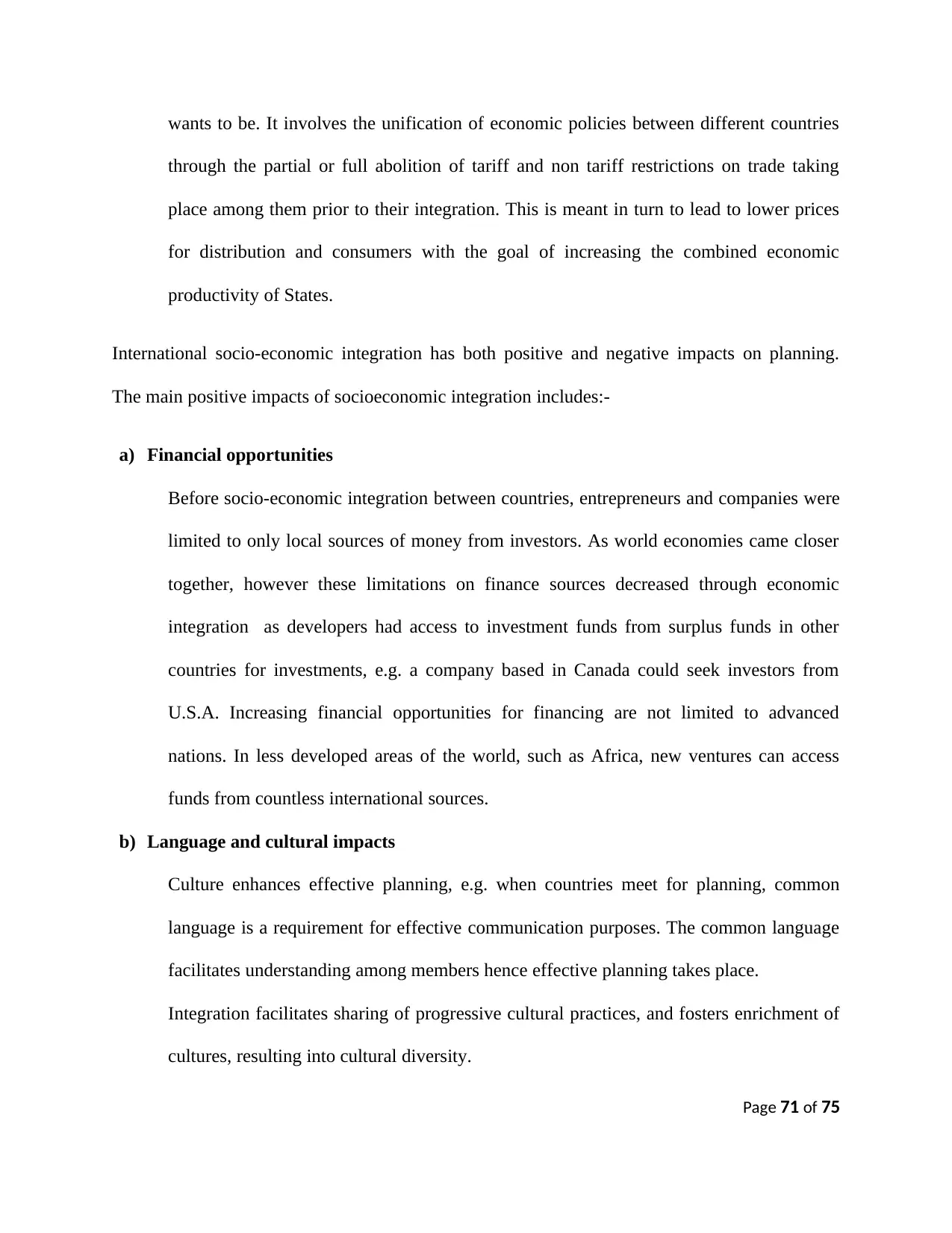
wants to be. It involves the unification of economic policies between different countries
through the partial or full abolition of tariff and non tariff restrictions on trade taking
place among them prior to their integration. This is meant in turn to lead to lower prices
for distribution and consumers with the goal of increasing the combined economic
productivity of States.
International socio-economic integration has both positive and negative impacts on planning.
The main positive impacts of socioeconomic integration includes:-
a) Financial opportunities
Before socio-economic integration between countries, entrepreneurs and companies were
limited to only local sources of money from investors. As world economies came closer
together, however these limitations on finance sources decreased through economic
integration as developers had access to investment funds from surplus funds in other
countries for investments, e.g. a company based in Canada could seek investors from
U.S.A. Increasing financial opportunities for financing are not limited to advanced
nations. In less developed areas of the world, such as Africa, new ventures can access
funds from countless international sources.
b) Language and cultural impacts
Culture enhances effective planning, e.g. when countries meet for planning, common
language is a requirement for effective communication purposes. The common language
facilitates understanding among members hence effective planning takes place.
Integration facilitates sharing of progressive cultural practices, and fosters enrichment of
cultures, resulting into cultural diversity.
Page 71 of 75
through the partial or full abolition of tariff and non tariff restrictions on trade taking
place among them prior to their integration. This is meant in turn to lead to lower prices
for distribution and consumers with the goal of increasing the combined economic
productivity of States.
International socio-economic integration has both positive and negative impacts on planning.
The main positive impacts of socioeconomic integration includes:-
a) Financial opportunities
Before socio-economic integration between countries, entrepreneurs and companies were
limited to only local sources of money from investors. As world economies came closer
together, however these limitations on finance sources decreased through economic
integration as developers had access to investment funds from surplus funds in other
countries for investments, e.g. a company based in Canada could seek investors from
U.S.A. Increasing financial opportunities for financing are not limited to advanced
nations. In less developed areas of the world, such as Africa, new ventures can access
funds from countless international sources.
b) Language and cultural impacts
Culture enhances effective planning, e.g. when countries meet for planning, common
language is a requirement for effective communication purposes. The common language
facilitates understanding among members hence effective planning takes place.
Integration facilitates sharing of progressive cultural practices, and fosters enrichment of
cultures, resulting into cultural diversity.
Page 71 of 75
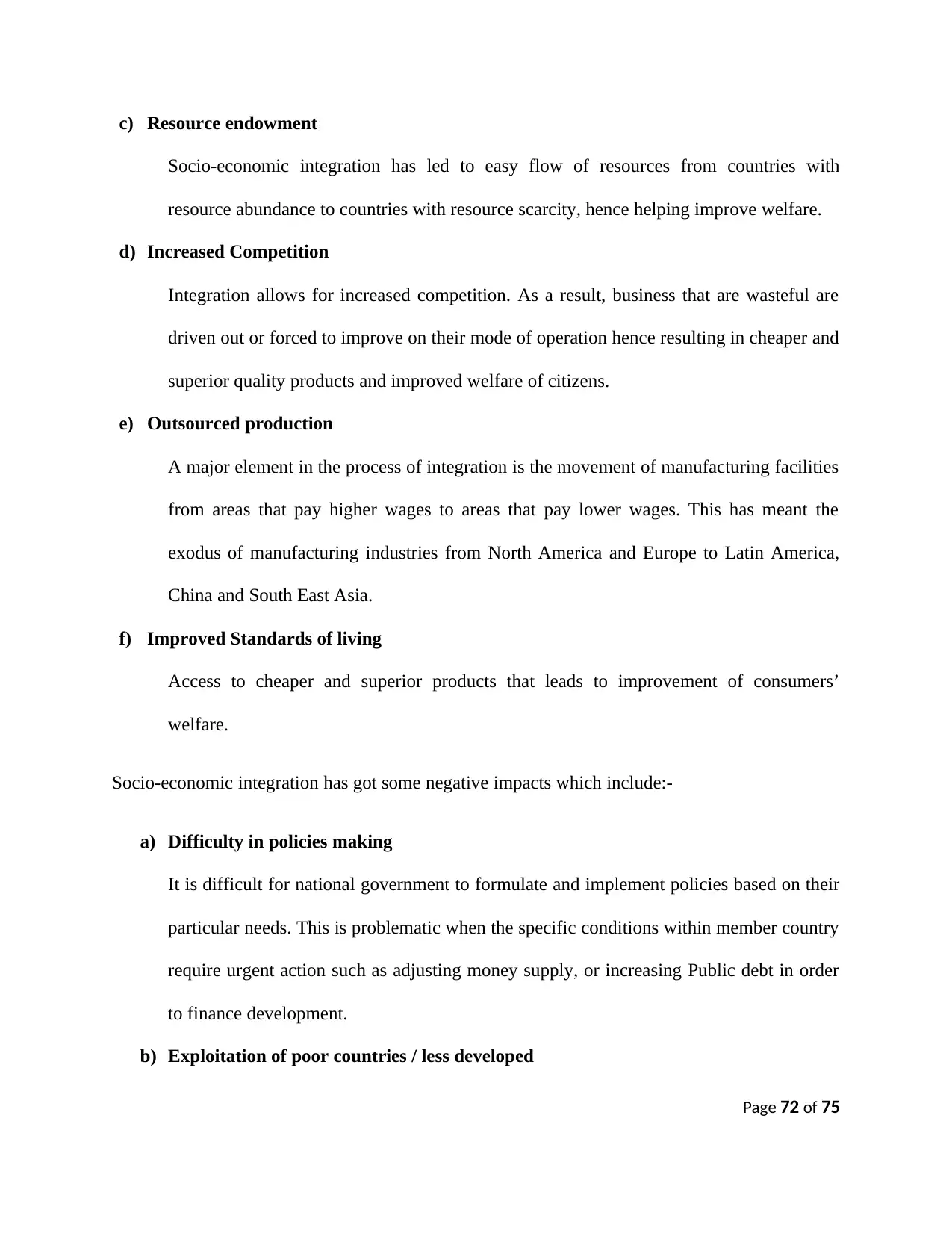
c) Resource endowment
Socio-economic integration has led to easy flow of resources from countries with
resource abundance to countries with resource scarcity, hence helping improve welfare.
d) Increased Competition
Integration allows for increased competition. As a result, business that are wasteful are
driven out or forced to improve on their mode of operation hence resulting in cheaper and
superior quality products and improved welfare of citizens.
e) Outsourced production
A major element in the process of integration is the movement of manufacturing facilities
from areas that pay higher wages to areas that pay lower wages. This has meant the
exodus of manufacturing industries from North America and Europe to Latin America,
China and South East Asia.
f) Improved Standards of living
Access to cheaper and superior products that leads to improvement of consumers’
welfare.
Socio-economic integration has got some negative impacts which include:-
a) Difficulty in policies making
It is difficult for national government to formulate and implement policies based on their
particular needs. This is problematic when the specific conditions within member country
require urgent action such as adjusting money supply, or increasing Public debt in order
to finance development.
b) Exploitation of poor countries / less developed
Page 72 of 75
Socio-economic integration has led to easy flow of resources from countries with
resource abundance to countries with resource scarcity, hence helping improve welfare.
d) Increased Competition
Integration allows for increased competition. As a result, business that are wasteful are
driven out or forced to improve on their mode of operation hence resulting in cheaper and
superior quality products and improved welfare of citizens.
e) Outsourced production
A major element in the process of integration is the movement of manufacturing facilities
from areas that pay higher wages to areas that pay lower wages. This has meant the
exodus of manufacturing industries from North America and Europe to Latin America,
China and South East Asia.
f) Improved Standards of living
Access to cheaper and superior products that leads to improvement of consumers’
welfare.
Socio-economic integration has got some negative impacts which include:-
a) Difficulty in policies making
It is difficult for national government to formulate and implement policies based on their
particular needs. This is problematic when the specific conditions within member country
require urgent action such as adjusting money supply, or increasing Public debt in order
to finance development.
b) Exploitation of poor countries / less developed
Page 72 of 75
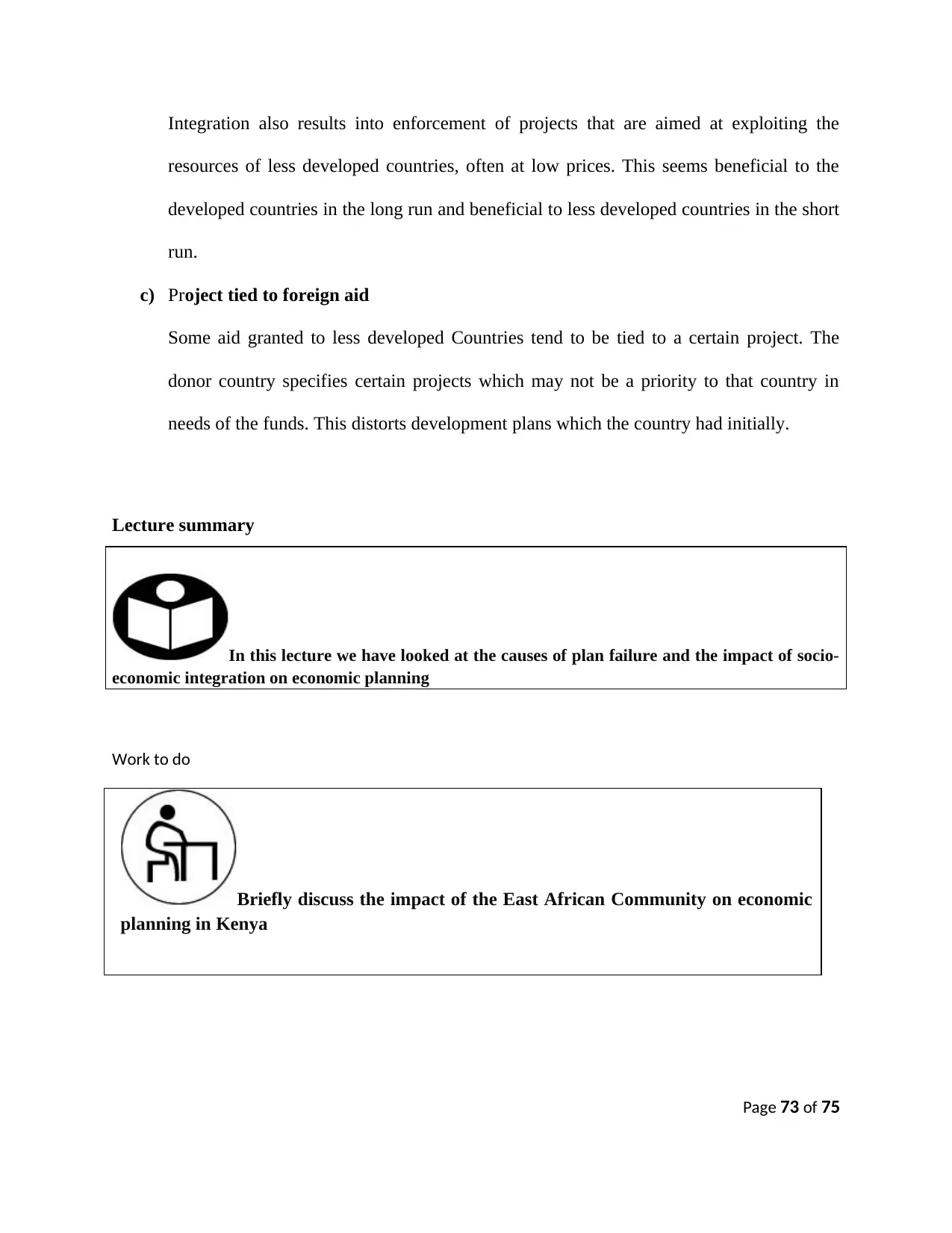
Integration also results into enforcement of projects that are aimed at exploiting the
resources of less developed countries, often at low prices. This seems beneficial to the
developed countries in the long run and beneficial to less developed countries in the short
run.
c) Project tied to foreign aid
Some aid granted to less developed Countries tend to be tied to a certain project. The
donor country specifies certain projects which may not be a priority to that country in
needs of the funds. This distorts development plans which the country had initially.
Lecture summary
In this lecture we have looked at the causes of plan failure and the impact of socio-
economic integration on economic planning
Work to do
Briefly discuss the impact of the East African Community on economic
planning in Kenya
Page 73 of 75
resources of less developed countries, often at low prices. This seems beneficial to the
developed countries in the long run and beneficial to less developed countries in the short
run.
c) Project tied to foreign aid
Some aid granted to less developed Countries tend to be tied to a certain project. The
donor country specifies certain projects which may not be a priority to that country in
needs of the funds. This distorts development plans which the country had initially.
Lecture summary
In this lecture we have looked at the causes of plan failure and the impact of socio-
economic integration on economic planning
Work to do
Briefly discuss the impact of the East African Community on economic
planning in Kenya
Page 73 of 75
Paraphrase This Document
Need a fresh take? Get an instant paraphrase of this document with our AI Paraphraser
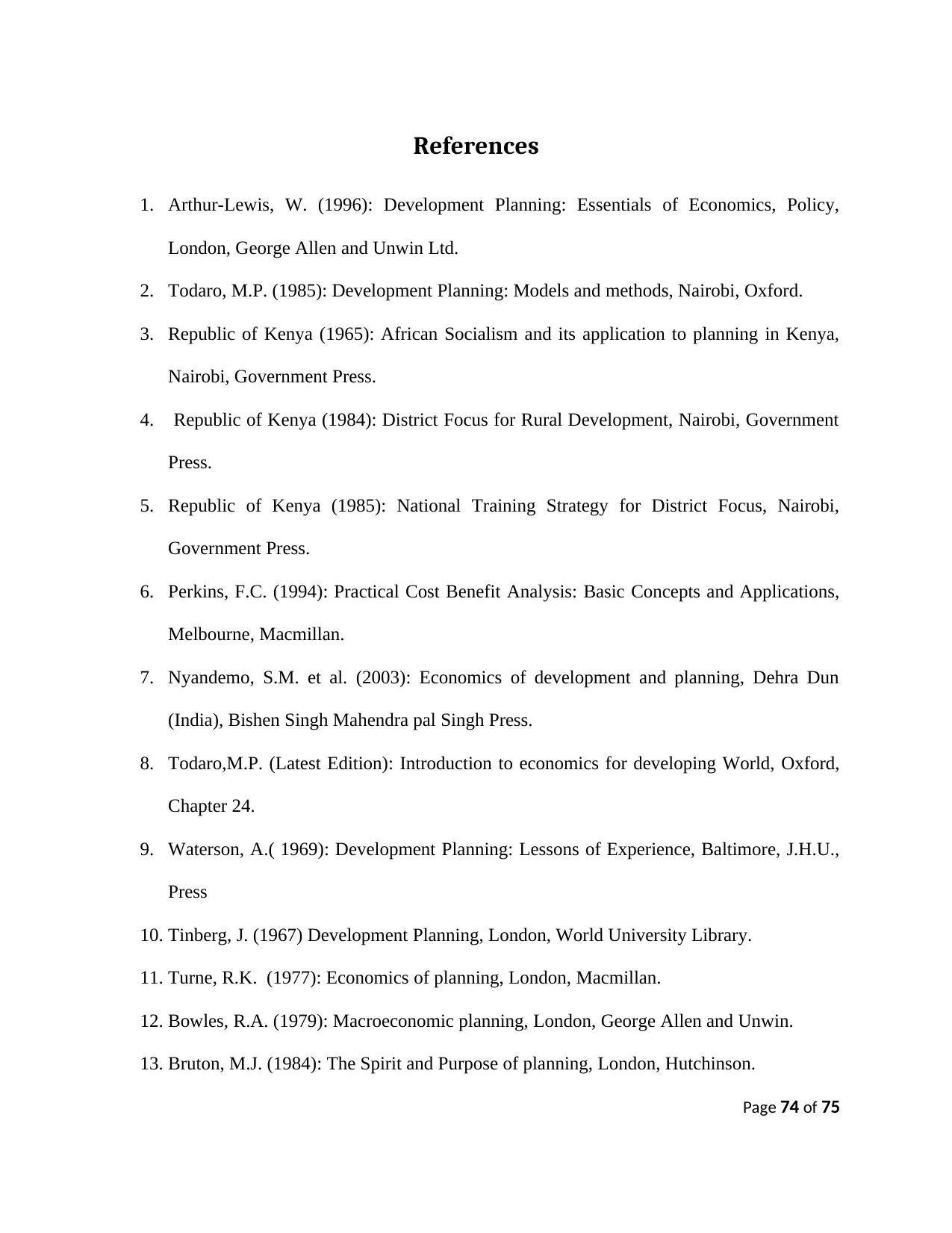
References
1. Arthur-Lewis, W. (1996): Development Planning: Essentials of Economics, Policy,
London, George Allen and Unwin Ltd.
2. Todaro, M.P. (1985): Development Planning: Models and methods, Nairobi, Oxford.
3. Republic of Kenya (1965): African Socialism and its application to planning in Kenya,
Nairobi, Government Press.
4. Republic of Kenya (1984): District Focus for Rural Development, Nairobi, Government
Press.
5. Republic of Kenya (1985): National Training Strategy for District Focus, Nairobi,
Government Press.
6. Perkins, F.C. (1994): Practical Cost Benefit Analysis: Basic Concepts and Applications,
Melbourne, Macmillan.
7. Nyandemo, S.M. et al. (2003): Economics of development and planning, Dehra Dun
(India), Bishen Singh Mahendra pal Singh Press.
8. Todaro,M.P. (Latest Edition): Introduction to economics for developing World, Oxford,
Chapter 24.
9. Waterson, A.( 1969): Development Planning: Lessons of Experience, Baltimore, J.H.U.,
Press
10. Tinberg, J. (1967) Development Planning, London, World University Library.
11. Turne, R.K. (1977): Economics of planning, London, Macmillan.
12. Bowles, R.A. (1979): Macroeconomic planning, London, George Allen and Unwin.
13. Bruton, M.J. (1984): The Spirit and Purpose of planning, London, Hutchinson.
Page 74 of 75
1. Arthur-Lewis, W. (1996): Development Planning: Essentials of Economics, Policy,
London, George Allen and Unwin Ltd.
2. Todaro, M.P. (1985): Development Planning: Models and methods, Nairobi, Oxford.
3. Republic of Kenya (1965): African Socialism and its application to planning in Kenya,
Nairobi, Government Press.
4. Republic of Kenya (1984): District Focus for Rural Development, Nairobi, Government
Press.
5. Republic of Kenya (1985): National Training Strategy for District Focus, Nairobi,
Government Press.
6. Perkins, F.C. (1994): Practical Cost Benefit Analysis: Basic Concepts and Applications,
Melbourne, Macmillan.
7. Nyandemo, S.M. et al. (2003): Economics of development and planning, Dehra Dun
(India), Bishen Singh Mahendra pal Singh Press.
8. Todaro,M.P. (Latest Edition): Introduction to economics for developing World, Oxford,
Chapter 24.
9. Waterson, A.( 1969): Development Planning: Lessons of Experience, Baltimore, J.H.U.,
Press
10. Tinberg, J. (1967) Development Planning, London, World University Library.
11. Turne, R.K. (1977): Economics of planning, London, Macmillan.
12. Bowles, R.A. (1979): Macroeconomic planning, London, George Allen and Unwin.
13. Bruton, M.J. (1984): The Spirit and Purpose of planning, London, Hutchinson.
Page 74 of 75

14. Republic of Kenya (2007). The Kenya Vision 2030: A Globally Competitive and
Prosperous Kenya. Nairobi, Government Printers.
15. State of Israel ( ). “Israel 2020”, Master Plan for Israel in the 21st Century.
Page 75 of 75
Prosperous Kenya. Nairobi, Government Printers.
15. State of Israel ( ). “Israel 2020”, Master Plan for Israel in the 21st Century.
Page 75 of 75
1 out of 75
Related Documents
Your All-in-One AI-Powered Toolkit for Academic Success.
+13062052269
info@desklib.com
Available 24*7 on WhatsApp / Email
![[object Object]](/_next/static/media/star-bottom.7253800d.svg)
Unlock your academic potential
© 2024 | Zucol Services PVT LTD | All rights reserved.





